

Change Waits for No Leader
Peter F. Gallagher is a leadership guru, change management global thought leader, organisational change expert, international corporate conference speaker, 15X author, and C-level change leadership coach.
• Peter consults, speaks, and writes about the Leadership of Change®. For the last 35 years he has worked in over 35 countries for some of the world’s most successful organisations.
• Peter’s PURPOSE and passion are to improve the Leadership of Change®. He helps leaders successfully lead and implement change in their organisations.
Global Recognition:
Thinkers360: #1 Global Thought Leader and Influencer on Change Management (CM) - 2024-2023-2022-2021-2020
Global Gurus: #15 in the “Top 30” Global Gurus Leadership - 2024
leadersHum:
• #1 CM Guru you should follow - 2022
• Listed on the Power List of the Top 200 Biggest Voices in Leadership - 2022 & 2023
Leadership Coach - Change Leadership Alignment:
Are you worried about how your organisation and leadership team will lead your next change or transformation? I prepare and align corporate leadership teams to successfully lead their organisation’s change.
At the start of an organisation change journey, Peter asks all leaders:
“Do you understand your organisation's change history? Do you have a change vision? Are you aligned with your strategic objectives? Are you a high-performing team? Does your team have change leadership skills to lead the change or improvement that your organisation is facing?”
He then works with the leadership team to develop a solution.
Change Management Gamification Leadership Workshop:
Peter uses experiential learning so that employees and leaders can learn, test, and prepare for their organisational change.
Qualifications:
Peter has an MBA (Distinction) from Robert Gordon University. He was an ASQ Certified Manager of Quality, and one of the ‘First 500’ globally Certified Change Management Professionals™ (CCMP™) with the ACMP®. He has held three certifications from the Project Management Institute (PMI).
Author 15x - Leadership of Change - Change Management Body of Knowledge (CMBoK):
1. Change Management (CM) Fables
2. CM Pocket Guide
3. CM Handbook
4. CM Leadership
5. CM Adoption
6. CM Behaviour
7. CM Sponsorship
8. CM Charade
9. CM Insanity
10. CM Dilettante
A. CM Gamification Leadership
B. CM Gamification Adoption
C. CM Gamification Behaviour
D. CM Gamification Sponsorship
E. CM Gamification Leadership Teams
https://amzn.to/3rxIVjj
Other:
Former Board Member: Association of Change Management Professionals® (ACMP®) Global & UK
Speaker Association: VSA International
Contact Details:
E-mail: peter.gallagher@a2B.consulting
Speaking: https://www.peterfgallagher.com
Consulting: https://www.a2b.consulting
Available For: Advising, Consulting, Influencing, Speaking
Travels From: London, UK
Speaking Topics: Organisational Change Leadership and Change Leadership Alignment
| Peter F Gallagher | Points |
|---|---|
| Academic | 85 |
| Author | 1319 |
| Influencer | 155 |
| Speaker | 374 |
| Entrepreneur | 367 |
| Total | 2300 |
Points based upon Thinkers360 patent-pending algorithm.
Tags: Business Strategy, Change Management, Leadership
 Professional Scrum Master I
Professional Scrum Master I
Tags: Leadership, Change Management, Business Strategy
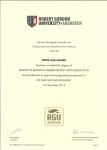 Masters in Business Administration (MBA) Distinction
Masters in Business Administration (MBA) Distinction
Tags: Business Strategy, Change Management, Leadership
 Manager of Quality/Organizational Excellence Certification - CMQ/OE
Manager of Quality/Organizational Excellence Certification - CMQ/OE
Tags: Business Strategy, Change Management, Leadership
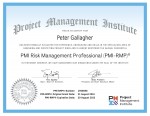 PMI Risk Management Professional (PMI-RMP)
PMI Risk Management Professional (PMI-RMP)
Tags: Leadership, Change Management, Business Strategy
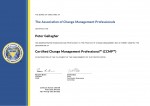 Certified Change Management Professional (CCMP)
Certified Change Management Professional (CCMP)
Tags: Leadership, Change Management, Business Strategy
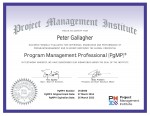 PMI Program Management Professional (PgMP)
PMI Program Management Professional (PgMP)
Tags: Leadership, Change Management, Business Strategy
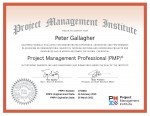 PMI Project Management Professional (PMP)
PMI Project Management Professional (PMP)
Tags: Leadership, Change Management, Business Strategy
 Diploma in Business Management Administration
Diploma in Business Management Administration
Tags: Business Strategy, Change Management, Leadership
 International Advisory Council Member - Human Health Education and Research Foundation
International Advisory Council Member - Human Health Education and Research Foundation
Tags: Leadership, Change Management, Business Strategy
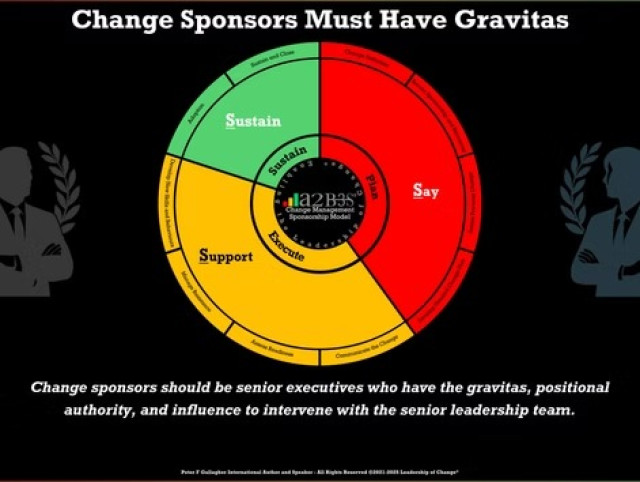 Change Sponsors Must Have Gravitas
Change Sponsors Must Have Gravitas
Tags: Business Strategy, Change Management, Leadership
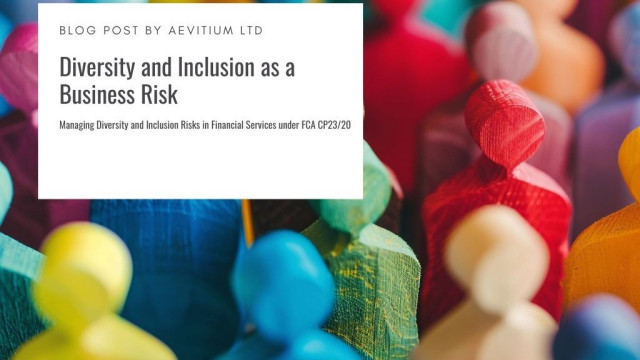 Protagonist #2. Change Sponsor: Change Management Charade
Protagonist #2. Change Sponsor: Change Management Charade
Tags: Business Strategy, Change Management, Leadership
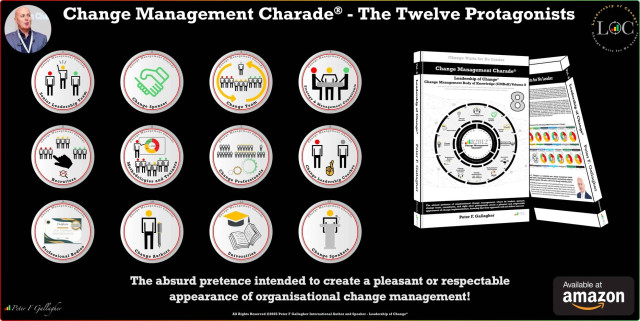 The Twelve Protagonists: Change Management Charade - Leadership of Change Volume 8
The Twelve Protagonists: Change Management Charade - Leadership of Change Volume 8
Tags: Business Strategy, Change Management, Leadership
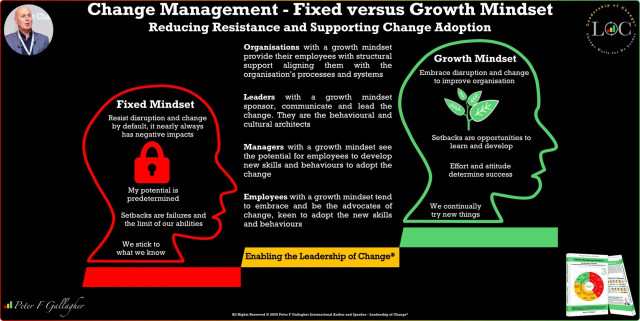 Change Management - Fixed Verses Growth Mindset
Change Management - Fixed Verses Growth Mindset
Tags: Business Strategy, Change Management, Leadership
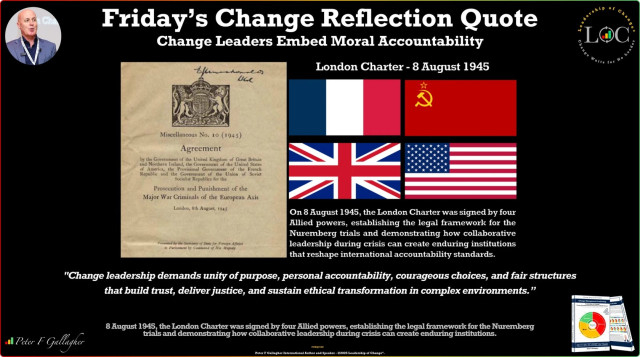 Friday’s Change Reflection Quote - Leadership of Change - Change Leaders Embed Moral Accountability
Friday’s Change Reflection Quote - Leadership of Change - Change Leaders Embed Moral Accountability
Tags: Business Strategy, Change Management, Leadership
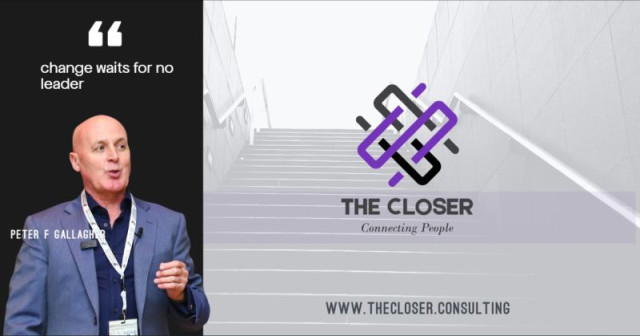 Peter F Gallagher Now Listed - The Closer Speakers' Consultancy Ltd.
Peter F Gallagher Now Listed - The Closer Speakers' Consultancy Ltd.
Tags: Business Strategy, Change Management, Leadership
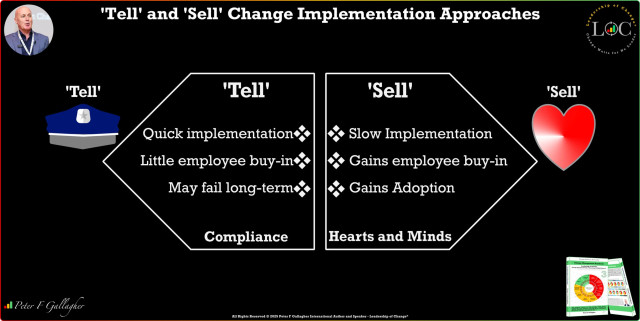 Change Implementation Approaches - ‘Tell’ versus ‘Sell’
Change Implementation Approaches - ‘Tell’ versus ‘Sell’
Tags: Business Strategy, Change Management, Leadership
 Friday’s Change Reflection Quote - Leadership of Change - Deference Ends Where Change Leaders Begin
Friday’s Change Reflection Quote - Leadership of Change - Deference Ends Where Change Leaders Begin
Tags: Business Strategy, Change Management, Leadership
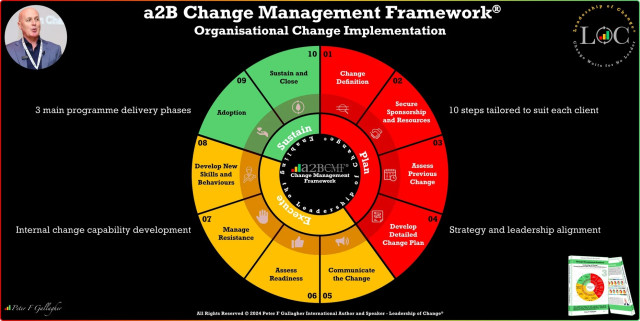 a2B Change Management Framework (a2BCMF) – Video Overview
a2B Change Management Framework (a2BCMF) – Video Overview
Tags: Business Strategy, Change Management, Leadership
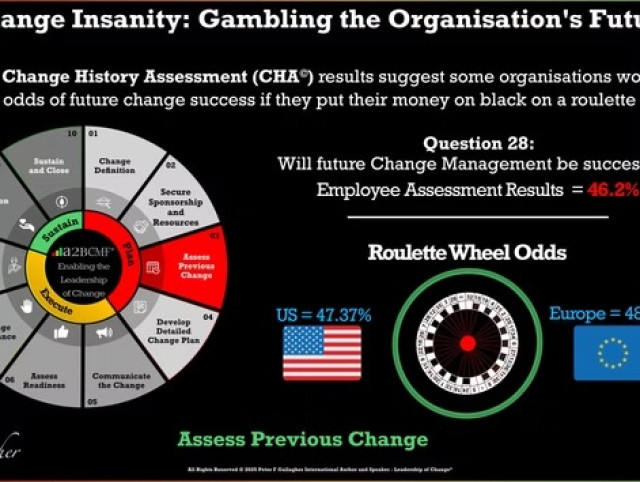 Change Insanity: Gambling the Organisation's Future
Change Insanity: Gambling the Organisation's Future
Tags: Business Strategy, Change Management, Leadership
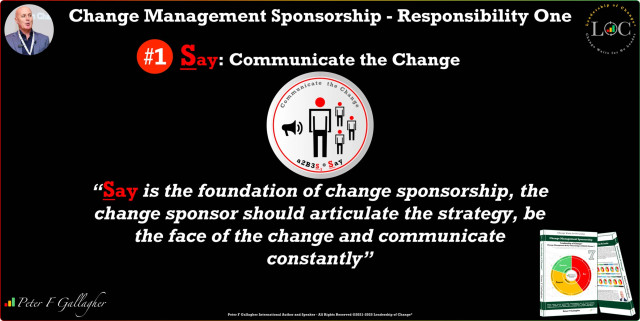 Change Management Sponsorship - Responsibility One: Say
Change Management Sponsorship - Responsibility One: Say
Tags: Business Strategy, Change Management, Leadership
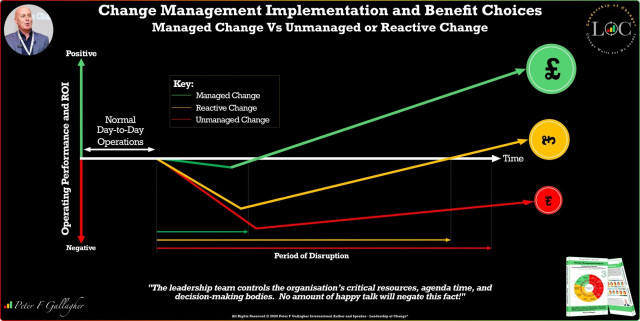 Change Management Implementation and Benefit Choices - Managed Change Vs Unmanaged or Reactive Change
Change Management Implementation and Benefit Choices - Managed Change Vs Unmanaged or Reactive Change
Tags: Business Strategy, Change Management, Leadership
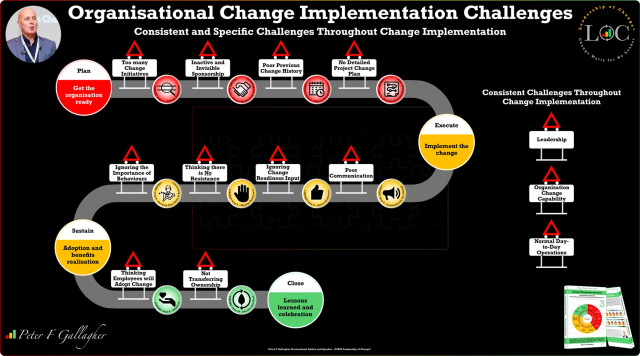 Organisational Change Implementation Challenges
Organisational Change Implementation Challenges
Tags: Business Strategy, Change Management, Leadership
 Change Leadership Versus Change Management Versus Employee Adoption
Change Leadership Versus Change Management Versus Employee Adoption
Tags: Business Strategy, Change Management, Leadership
 Friday’s Change Reflection Quote - Leadership of Change - Leaders Enable Peaceful Dispute Resolution
Friday’s Change Reflection Quote - Leadership of Change - Leaders Enable Peaceful Dispute Resolution
Tags: Business Strategy, Change Management, Leadership
 Change Readiness Assessment (CRA) - Organisational Change Implementation Preparation
Change Readiness Assessment (CRA) - Organisational Change Implementation Preparation
Tags: Business Strategy, Change Management, Leadership
 Change Management - Organisational Change Capacity and Workload
Change Management - Organisational Change Capacity and Workload
Tags: Business Strategy, Change Management, Leadership
 Change Leadership Alignment Process Step 1: Change History Assessment
Change Leadership Alignment Process Step 1: Change History Assessment
Tags: Business Strategy, Change Management, Leadership
 AUILM Employee Change Adoption Model
AUILM Employee Change Adoption Model
Tags: Business Strategy, Change Management, Leadership
 Change Management Communication - Starts with the Why
Change Management Communication - Starts with the Why
Tags: Business Strategy, Change Management, Leadership
 Friday’s Change Reflection Quote - Leadership of Change - Change Leaders Enable Shared Learning Networks
Friday’s Change Reflection Quote - Leadership of Change - Change Leaders Enable Shared Learning Networks
Tags: Business Strategy, Change Management, Leadership
 Friday’s Change Reflection Quote - Leadership of Change - Change Leaders Envision Human-Tech Synergy.
Friday’s Change Reflection Quote - Leadership of Change - Change Leaders Envision Human-Tech Synergy.
Tags: Business Strategy, Change Management, Leadership
 a2B Change Management Framework (a2BCMF) - Step #10: Sustain and Close
a2B Change Management Framework (a2BCMF) - Step #10: Sustain and Close
Tags: Business Strategy, Change Management, Leadership
 Change Elevator Speech - Initiative 'Commercial’ or ‘Advertisement’
Change Elevator Speech - Initiative 'Commercial’ or ‘Advertisement’
Tags: Business Strategy, Change Management, Leadership
 Change Reflection Quote - Leadership of Change - Change Leaders Maintain Intellectual Flexibility
Change Reflection Quote - Leadership of Change - Change Leaders Maintain Intellectual Flexibility
Tags: Business Strategy, Change Management, Leadership
 ACMP Board of Directors
ACMP Board of Directors
Tags: Business Strategy, Change Management, Leadership
Tags: Business Strategy, Change Management, Leadership
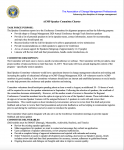 ACMP Speaker Committee
ACMP Speaker Committee
Tags: Business Strategy, Change Management, Leadership
Tags: Business Strategy, Change Management, Leadership
 UK Board Member (Officer) - JT LIMITED
UK Board Member (Officer) - JT LIMITED
Tags: Business Strategy, Change Management, Leadership
 Change Management Charade - Leadership of Change Volume 8 (Leadership of Change - Change Management Body of Knowledge
Change Management Charade - Leadership of Change Volume 8 (Leadership of Change - Change Management Body of Knowledge
Tags: Change Management, Leadership
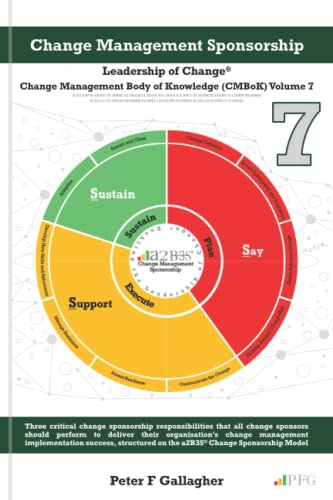 Change Management Sponsorship: Leadership of Change Volume 7
Change Management Sponsorship: Leadership of Change Volume 7
Tags: Leadership, Change Management, Business Strategy
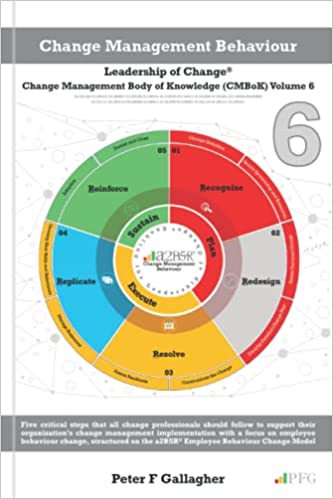 Change Management Behaviour: Leadership of Change Volume 6
Change Management Behaviour: Leadership of Change Volume 6
Tags: Leadership, Change Management, Business Strategy
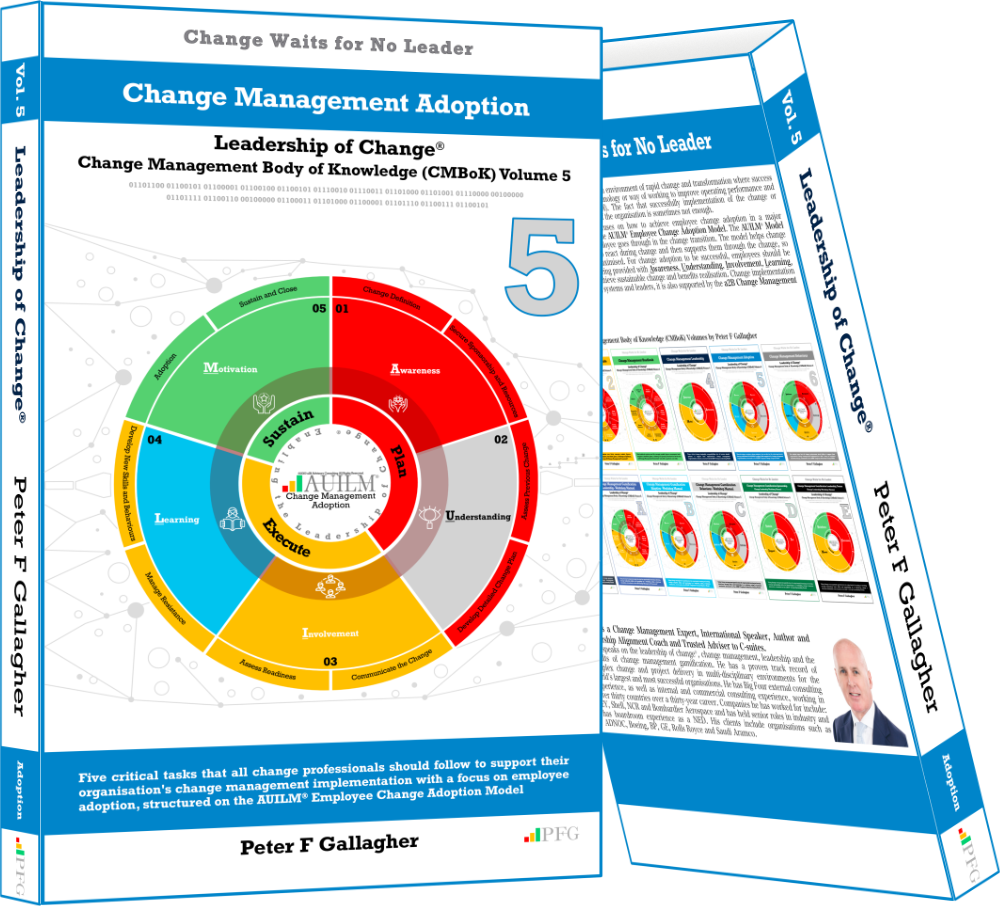 Change Management Adoption: Leadership of Change Volume 5
Change Management Adoption: Leadership of Change Volume 5
Tags: Business Strategy, Change Management, Leadership
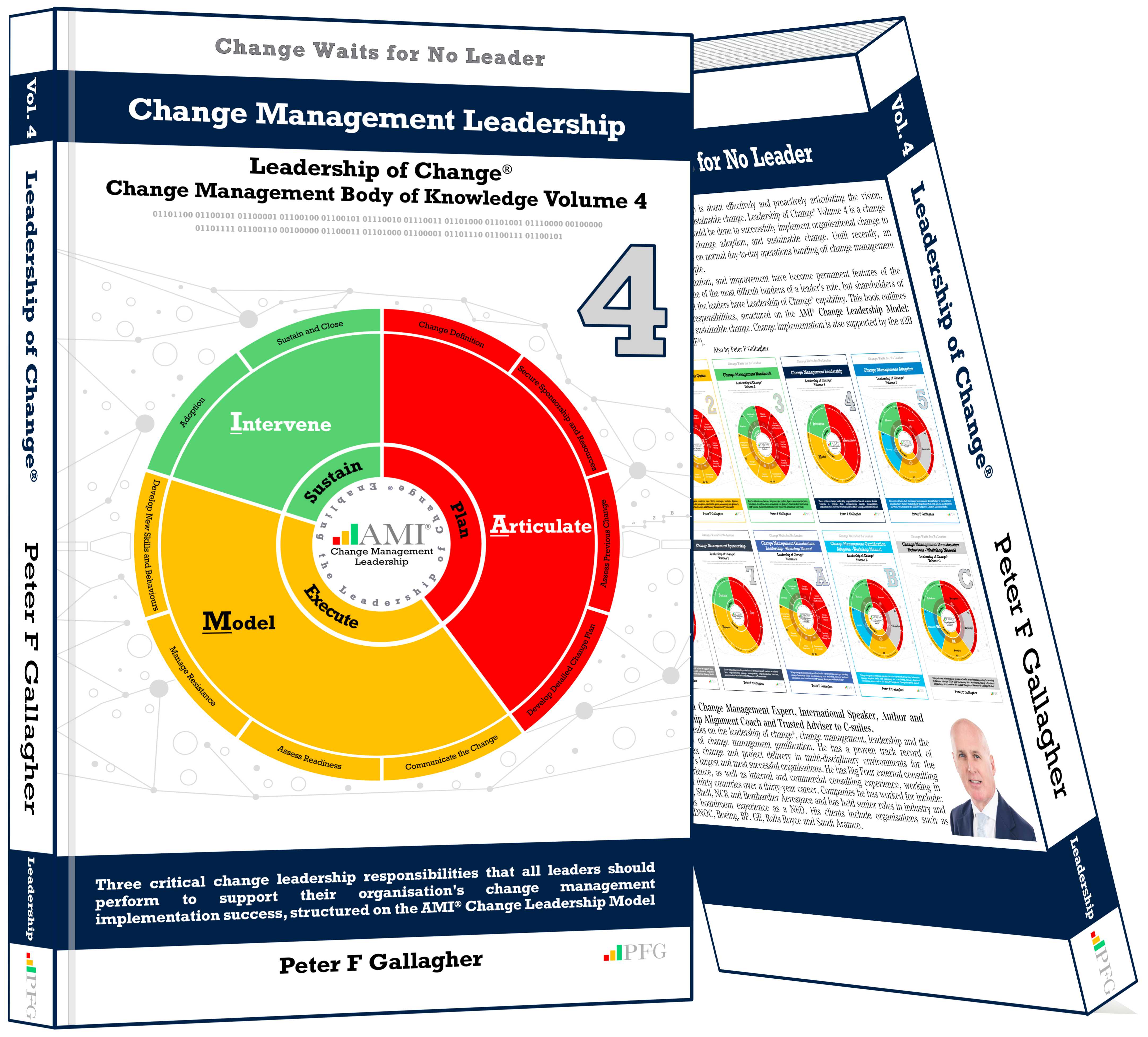 Change Management Leadership: Leadership of Change - Volume 4
Change Management Leadership: Leadership of Change - Volume 4
Tags: Business Strategy, Change Management, Leadership
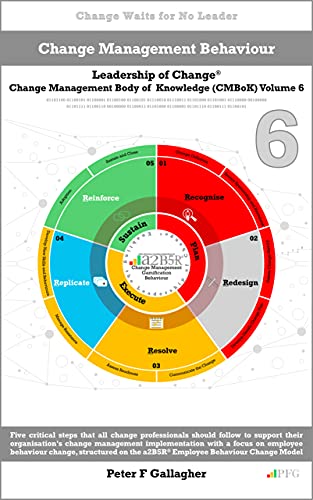 Change Management Behaviour: Leadership of Change Volume 6 (Leadership of Change - Change Management Body of Knowledge (CMBoK) Volumes)
Change Management Behaviour: Leadership of Change Volume 6 (Leadership of Change - Change Management Body of Knowledge (CMBoK) Volumes)
Tags: Leadership, Change Management
 Change Management Adoption: Leadership of Change Volume 5
Change Management Adoption: Leadership of Change Volume 5
Tags: Leadership, Change Management, Business Strategy
 Change Management Gamification Adoption: Leadership of Change Volume B
Change Management Gamification Adoption: Leadership of Change Volume B
Tags: Business Strategy, Change Management, Leadership
 Change Management Gamification Leadership - Leadership of Change Volume A
Change Management Gamification Leadership - Leadership of Change Volume A
Tags: Leadership, Change Management, Business Strategy
 Change Management Handbook - Leadership of Change Volume 3
Change Management Handbook - Leadership of Change Volume 3
Tags: Leadership, Change Management, Business Strategy
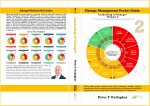 Change Management Pocket Guide - Leadership of Change Volume 2
Change Management Pocket Guide - Leadership of Change Volume 2
Tags: Business Strategy, Change Management, Leadership
 Change Management Fables - Leadership of Change Volume 1
Change Management Fables - Leadership of Change Volume 1
Tags: Business Strategy, Change Management, Leadership
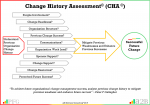 Change Management Handbook
3.3.3 The Importance of Assessing Previous Change
Change Management Handbook
3.3.3 The Importance of Assessing Previous Change
Tags: Leadership, Change Management, Business Strategy
 Coming Summer 2024 - Change Management Charade - Leadership of Change Volume 8
Coming Summer 2024 - Change Management Charade - Leadership of Change Volume 8
Tags: Business Strategy, Change Management, Leadership
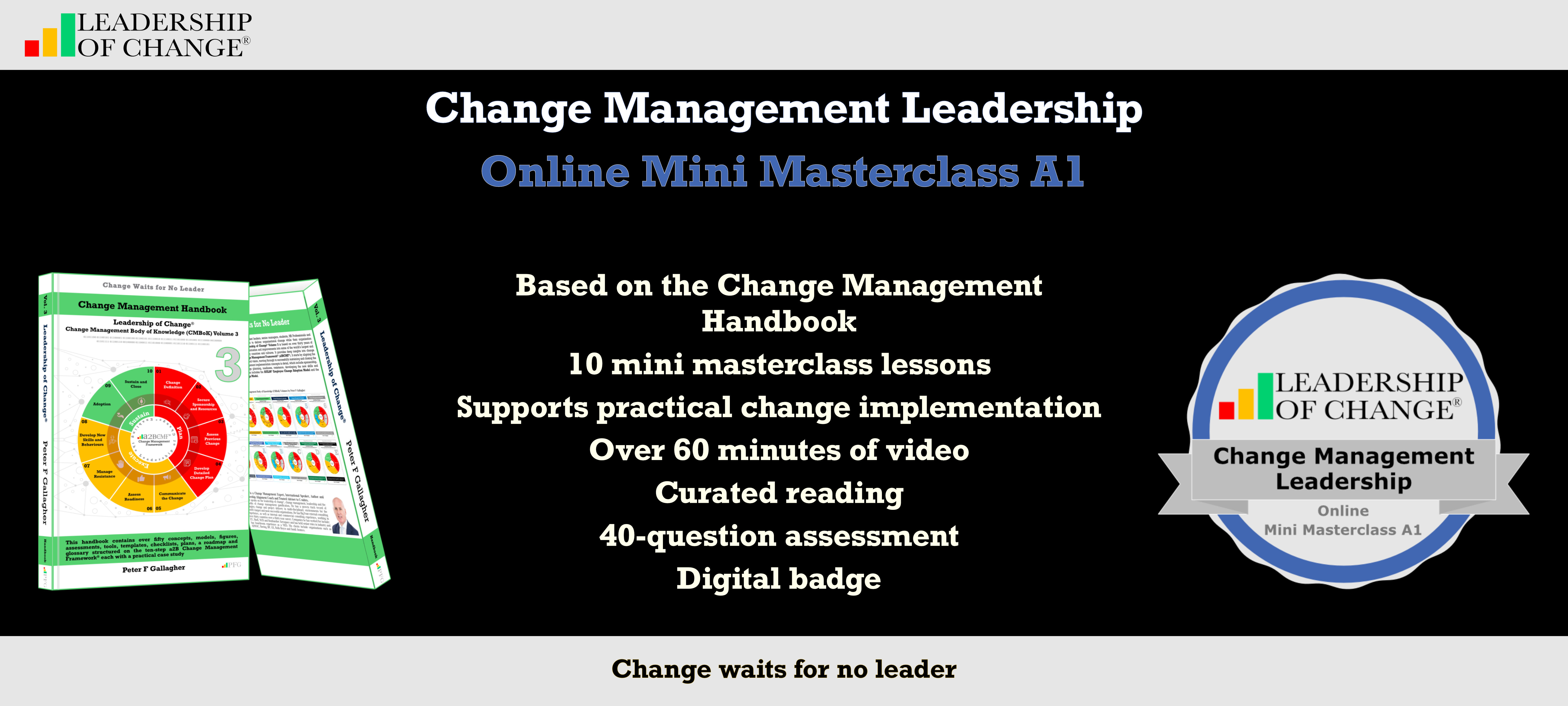 Change Management Leadership - Online Mini Masterclass A1
Change Management Leadership - Online Mini Masterclass A1
Tags: Business Strategy, Change Management, Leadership
Tags: Business Strategy, Change Management, Leadership
Tags: Business Strategy, Change Management, Leadership
 Change Management Glossary
Change Management Glossary
Tags: Business Strategy, Change Management, Leadership
Tags: Business Strategy, Change Management, Leadership
 Change Management Sponsorship: Leadership of Change Volume 7
Change Management Sponsorship: Leadership of Change Volume 7
Tags: Business Strategy, Change Management, Leadership
 Change Management Behaviour: Leadership of Change Volume 6
Change Management Behaviour: Leadership of Change Volume 6
Tags: Business Strategy, Change Management, Leadership
 Change Management Leadership - Leadership of Change Volume 4
Change Management Leadership - Leadership of Change Volume 4
Tags: Business Strategy, Change Management, Leadership
 Change Management Handbook: Leadership of Change Volume 3
Change Management Handbook: Leadership of Change Volume 3
Tags: Business Strategy, Change Management, Leadership
 Change Management Pocket Guide: Leadership of Change Volume 2
Change Management Pocket Guide: Leadership of Change Volume 2
Tags: Business Strategy, Change Management, Leadership
 Change Management Fables: Leadership of Change Volume 1
Change Management Fables: Leadership of Change Volume 1
Tags: Business Strategy, Change Management, Leadership
 a2B Advisory Consulting
a2B Advisory Consulting
Tags: Leadership, Change Management, Business Strategy
Tags: Business Strategy, Change Management, Leadership
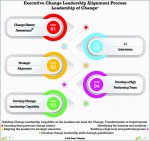 Change Leadership Alignment Process
Change Leadership Alignment Process
Tags: Business Strategy, Change Management, Leadership
 Change History Assessment (CHA)
Change History Assessment (CHA)
Tags: Business Strategy, Change Management, Leadership
 ACMP Turkey: 24th Nov 2021 - Peter F Gallagher Speaking on the Leadership of Change
ACMP Turkey: 24th Nov 2021 - Peter F Gallagher Speaking on the Leadership of Change
Tags: Business Strategy, Change Management, Leadership
 ASQ EMEA Virtual Conference: Nov 2021 - Peter F Gallagher Speaking on Change Leadership Lessons
ASQ EMEA Virtual Conference: Nov 2021 - Peter F Gallagher Speaking on Change Leadership Lessons
Tags: Business Strategy, Change Management, Leadership
 ACMP East Coast Australia: Nov 2021 - Peter F Gallagher Speaking on the Leadership of Change
ACMP East Coast Australia: Nov 2021 - Peter F Gallagher Speaking on the Leadership of Change
Tags: Business Strategy, Change Management, Leadership
 Peter F Gallagher Speaking to UK Key Executives - Lean Leader Masterclass - Coventry, UK
Peter F Gallagher Speaking to UK Key Executives - Lean Leader Masterclass - Coventry, UK
Tags: Business Strategy, Change Management, Leadership
 Peter F Gallagher Speaking to UK Chief Executives - Lean Leader Masterclass - BirminghamLean Leader Masterclass - Leadership of Improvement Vistage Group CE5 - Birmingham – July 1 2021 Workshop Sessions 1. Change Disruption and 4IR 2. Strategic Planning 3. Lean Masterclass 4. Change Management
Peter F Gallagher Speaking to UK Chief Executives - Lean Leader Masterclass - BirminghamLean Leader Masterclass - Leadership of Improvement Vistage Group CE5 - Birmingham – July 1 2021 Workshop Sessions 1. Change Disruption and 4IR 2. Strategic Planning 3. Lean Masterclass 4. Change Management
Tags: Business Strategy, Change Management, Leadership
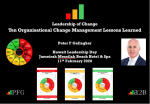 Leadership of Change - Ten Organisational Change Management Lessons Learned
Leadership of Change - Ten Organisational Change Management Lessons Learned
Tags: Leadership, Change Management, Business Strategy
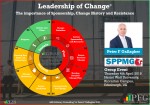 Leadership of Change: Three Change Management Lessons Learned
Leadership of Change: Three Change Management Lessons Learned
Tags: Leadership, Change Management, Business Strategy
 Leadership of Change: 10 Change Management Lessons Learned
Leadership of Change: 10 Change Management Lessons Learned
Tags: Leadership, Change Management, Business Strategy
 Peter F Gallagher Change Management Keynote - Edinburgh, UK
Peter F Gallagher Change Management Keynote - Edinburgh, UK
Tags: Business Strategy, Change Management, Leadership

Tags: Leadership, Change Management, Business Strategy
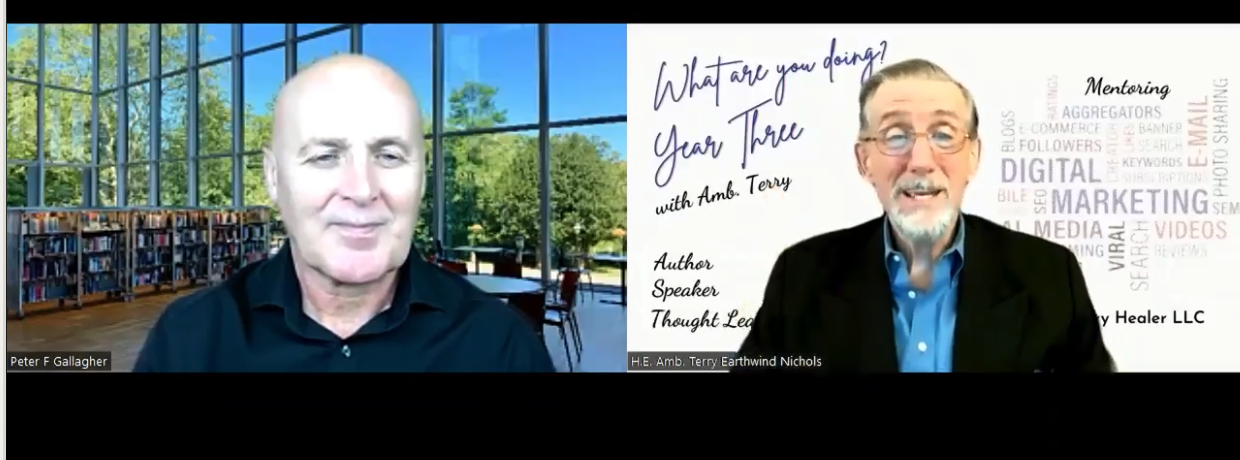 Is your organization in need of transition? Well...
Is your organization in need of transition? Well...
Tags: Business Strategy, Change Management, Leadership
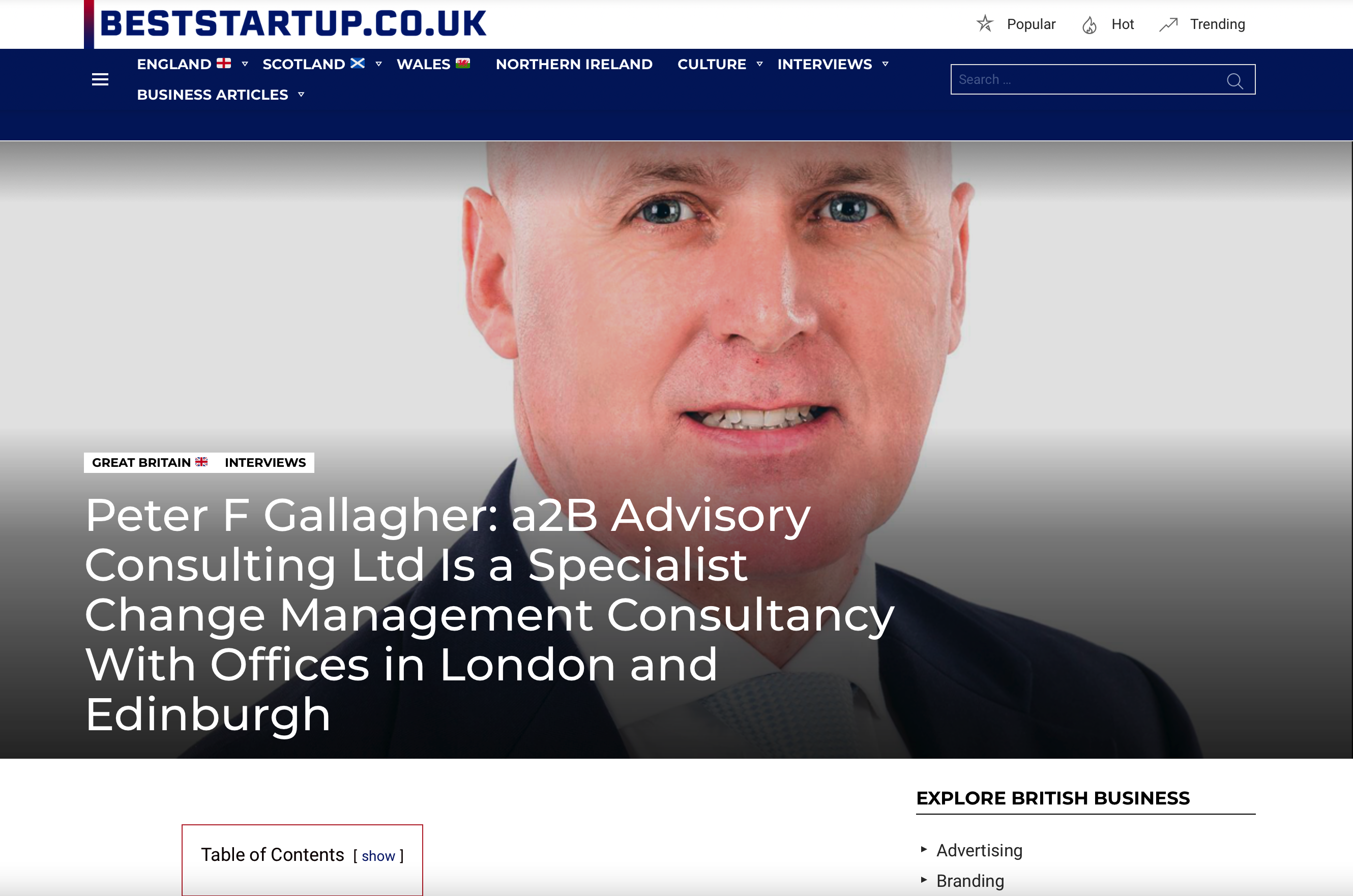 Interview with Peter F Gallagher Britain - BestStartup.co.uk
Interview with Peter F Gallagher Britain - BestStartup.co.uk
Tags: Business Strategy, Change Management, Leadership
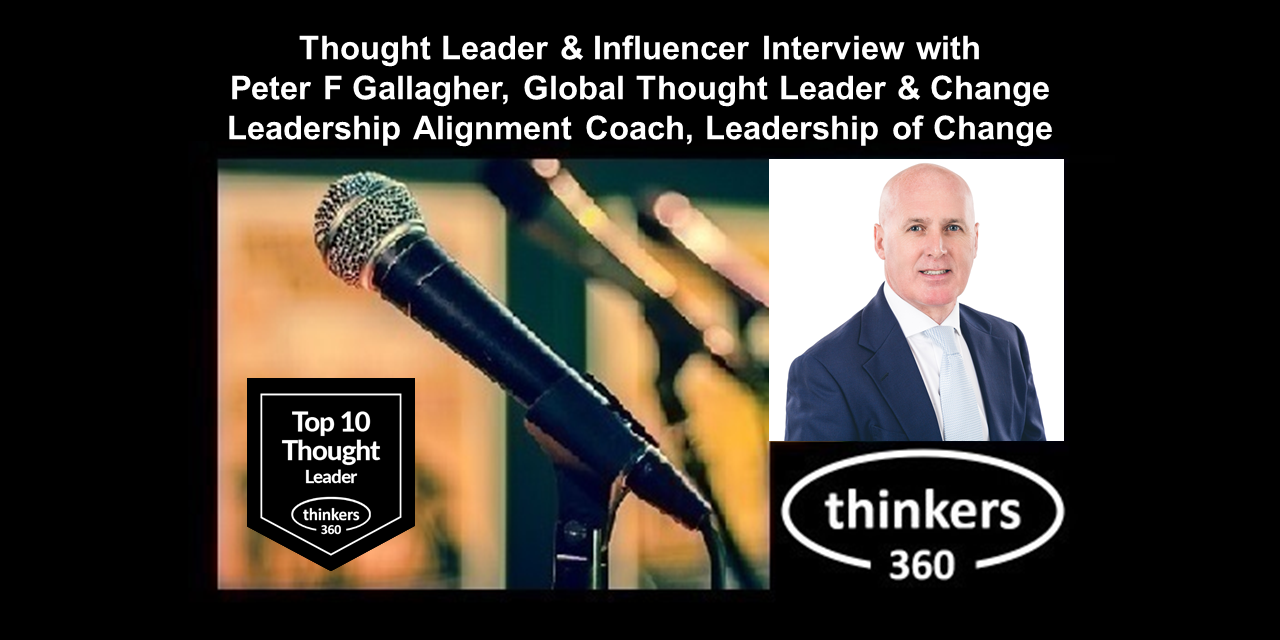 Thinkers360 Thought Leader and Influencer Interview with Peter F Gallagher
Thinkers360 Thought Leader and Influencer Interview with Peter F Gallagher
Tags: Business Strategy, Change Management, Leadership

Tags: Leadership, Change Management, Business Strategy
 Inside Track Podcast - Episode #21 - Peter Gallagher
Inside Track Podcast - Episode #21 - Peter Gallagher
Tags: Business Strategy, Change Management, Leadership
 Innohour: Delivering Fresh Ideas to Your Most Pressing Problems
Innohour: Delivering Fresh Ideas to Your Most Pressing Problems
Tags: Business Strategy, Change Management, Leadership
 Change Management Post-COVID 19: The Future of Work is Now
Change Management Post-COVID 19: The Future of Work is Now
Tags: Leadership, Change Management, Business Strategy
 Lead, Follow or Get Out of the Way
Lead, Follow or Get Out of the Way
Tags: Leadership, Change Management, Business Strategy
Tags: Business Strategy, Change Management, Leadership
 Business Talk Radio - Interview with Peter F Gallagher
Business Talk Radio - Interview with Peter F Gallagher
Tags: Leadership, Change Management, Business Strategy
 Association of Change Management Professionals (ACMP) UK Chapter
Association of Change Management Professionals (ACMP) UK Chapter
Tags: Leadership, Change Management, Business Strategy
 American Society for Quality (ASQ)
American Society for Quality (ASQ)
Tags: Business Strategy, Change Management, Leadership
 Association of Change Management Professionals (ACMP) UK Chapter
Association of Change Management Professionals (ACMP) UK Chapter
Tags: Business Strategy, Change Management, Leadership
 Association of Change Management Professionals (ACMP) UK Chapter
Association of Change Management Professionals (ACMP) UK Chapter
Tags: Business Strategy, Change Management, Leadership
 Project Management Institute, Inc Membership
Project Management Institute, Inc Membership
Tags: Business Strategy, Change Management, Leadership
 Association of Change Management Professionals (ACMP) UK Chapter
Association of Change Management Professionals (ACMP) UK Chapter
Tags: Business Strategy, Change Management, Leadership
 American Society for Quality (ASQ)
American Society for Quality (ASQ)
Tags: Business Strategy, Change Management, Leadership
 Association of Change Management Professionals (ACMP) UK Chapter
Association of Change Management Professionals (ACMP) UK Chapter
Tags: Business Strategy, Change Management, Leadership
 Association of Change Management Professionals (ACMP) Global & UAE
Association of Change Management Professionals (ACMP) Global & UAE
Tags: Business Strategy, Change Management, Leadership
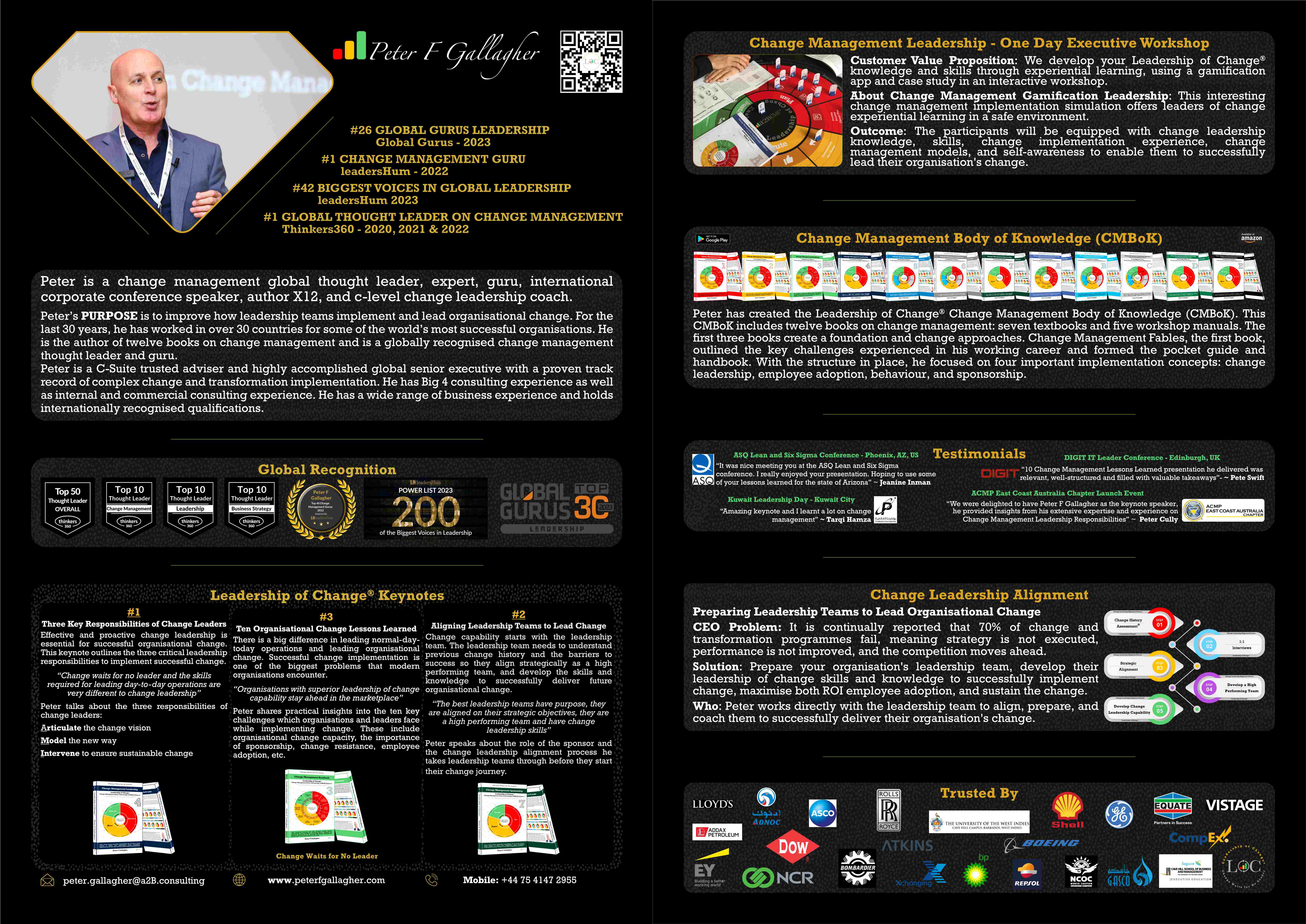 Peter F Gallagher's Speaker Bio with Keynotes - 2023 Update
Peter F Gallagher's Speaker Bio with Keynotes - 2023 Update
Tags: Business Strategy, Change Management, Leadership
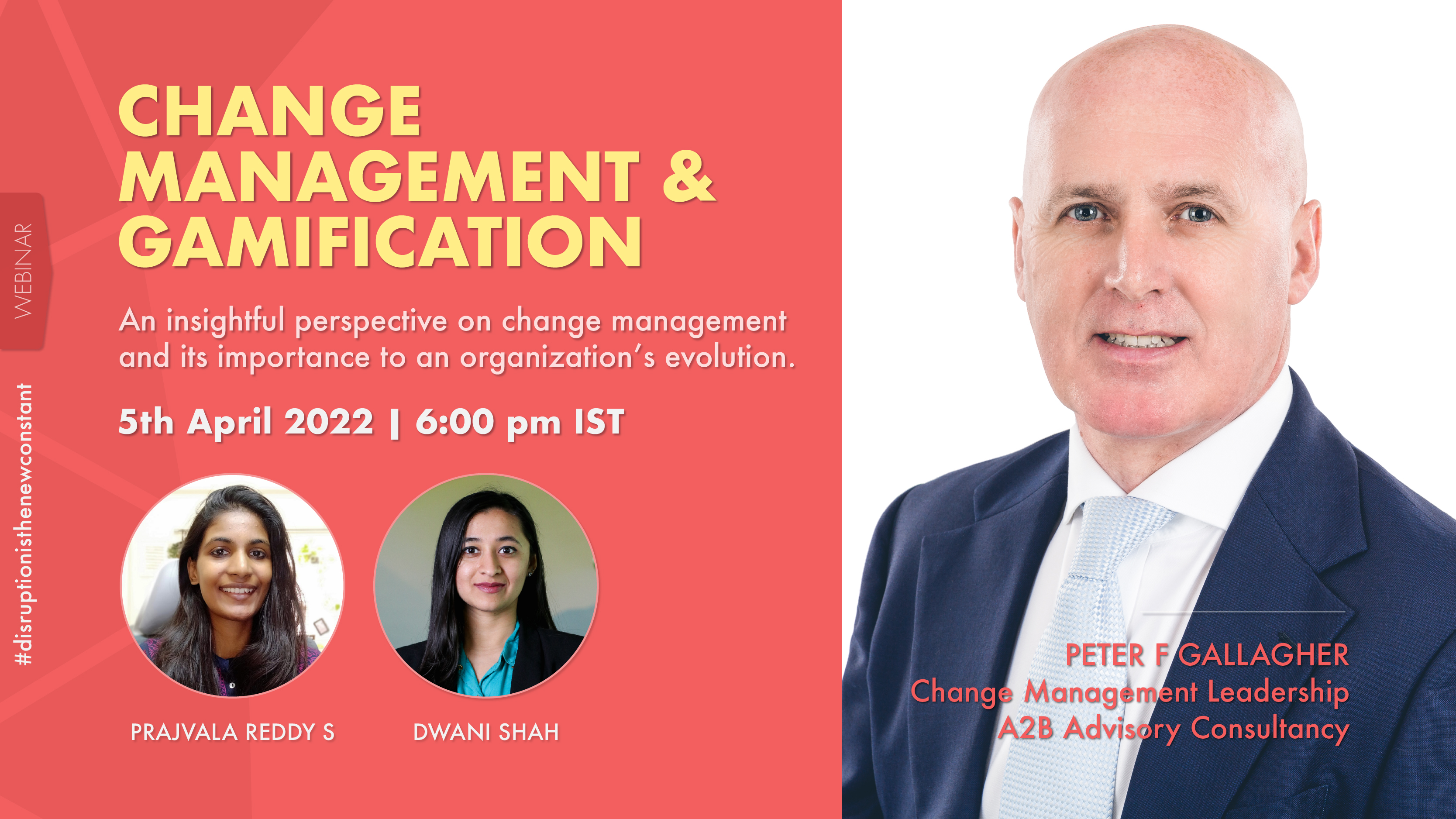 Peter F Gallagher Speaking to Zyeta on the Leadership of Change - Change Management & Gamification
Peter F Gallagher Speaking to Zyeta on the Leadership of Change - Change Management & Gamification
Tags: Business Strategy, Change Management, Leadership
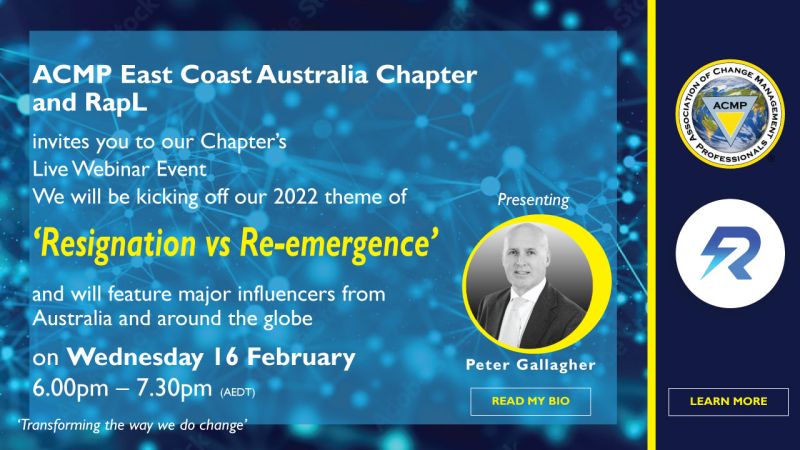 Resignation vs Re-emergence Round Table Discussion - ACMP East Coast Australia Chapter
Resignation vs Re-emergence Round Table Discussion - ACMP East Coast Australia Chapter
Tags: Business Strategy, Change Management, Leadership
 Kuwait Leadership Day Panel Discussion 2020
Kuwait Leadership Day Panel Discussion 2020
Tags: Business Strategy, Change Management, Leadership
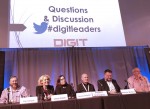 DIGIT IT Leaders Conference
DIGIT IT Leaders Conference
Tags: Leadership, Change Management, Business Strategy
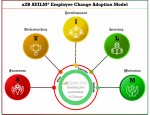 a2B AUILM Model: Employee Adoption Lifecycle
a2B AUILM Model: Employee Adoption Lifecycle
Tags: Leadership, Change Management, Business Strategy
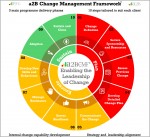 a2B Change Management Framework (a2BCMF)
a2B Change Management Framework (a2BCMF)
Tags: Leadership, Change Management, Business Strategy

Tags: Business Strategy, Change Management, Leadership

Tags: Business Strategy, Change Management, Leadership

Tags: Business Strategy, Change Management, Leadership

Tags: Business Strategy, Change Management, Leadership

Tags: Business Strategy, Change Management, Leadership

Tags: Business Strategy, Change Management, Leadership

Tags: Business Strategy, Change Management, Leadership

Tags: Business Strategy, Change Management, Leadership

Tags: Business Strategy, Change Management, Leadership

Tags: Business Strategy, Change Management, Leadership

Tags: Business Strategy, Change Management, Leadership

Tags: Business Strategy, Change Management, Leadership

Tags: Business Strategy, Change Management, Leadership

Tags: Business Strategy, Change Management, Leadership

Tags: Business Strategy, Change Management, Leadership

Tags: Business Strategy, Change Management, Leadership

Tags: Business Strategy, Change Management, Leadership
 a2B Change Management Framework (a2BCMF) - Step #8: Developing New Skills and Behaviours
a2B Change Management Framework (a2BCMF) - Step #8: Developing New Skills and Behaviours
Tags: Business Strategy, Change Management, Leadership
 Change Management Charade - Leadership of Change Volume 8 - October 21, 2024 Paperback Version
Change Management Charade - Leadership of Change Volume 8 - October 21, 2024 Paperback Version
Tags: Business Strategy, Change Management, Leadership

Tags: Business Strategy, Change Management, Leadership
 Friday’s Change Reflection Quote - Leadership of Change - Change Leaders Secure Influential Coalitions
Friday’s Change Reflection Quote - Leadership of Change - Change Leaders Secure Influential Coalitions
Tags: Business Strategy, Change Management, Leadership

Tags: Business Strategy, Change Management, Leadership

Tags: Business Strategy, Change Management, Leadership

Tags: Business Strategy, Change Management, Leadership

Tags: Business Strategy, Change Management, Leadership
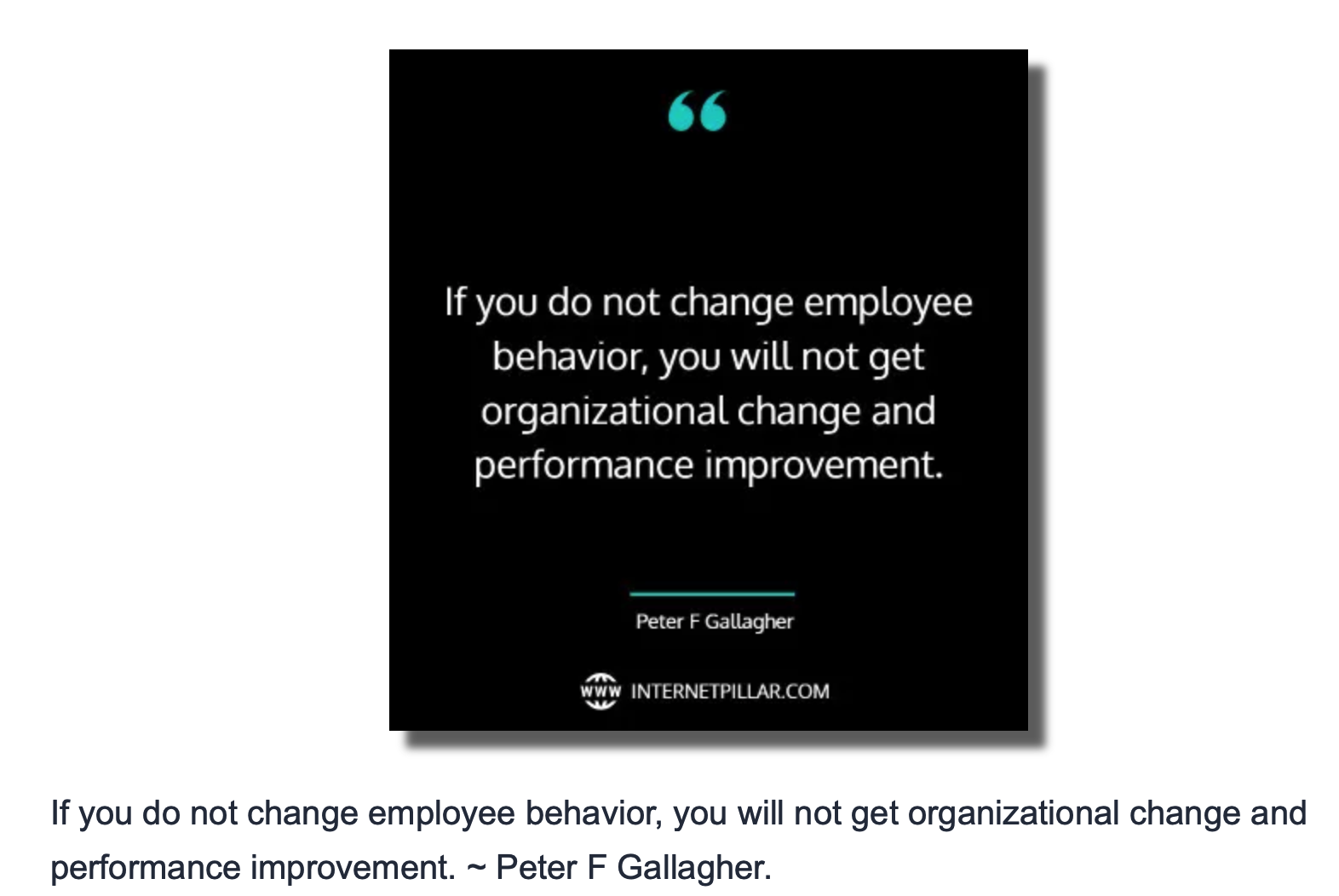 Change Employee Behavior - Internet pillar
Change Employee Behavior - Internet pillar
Tags: Change Management
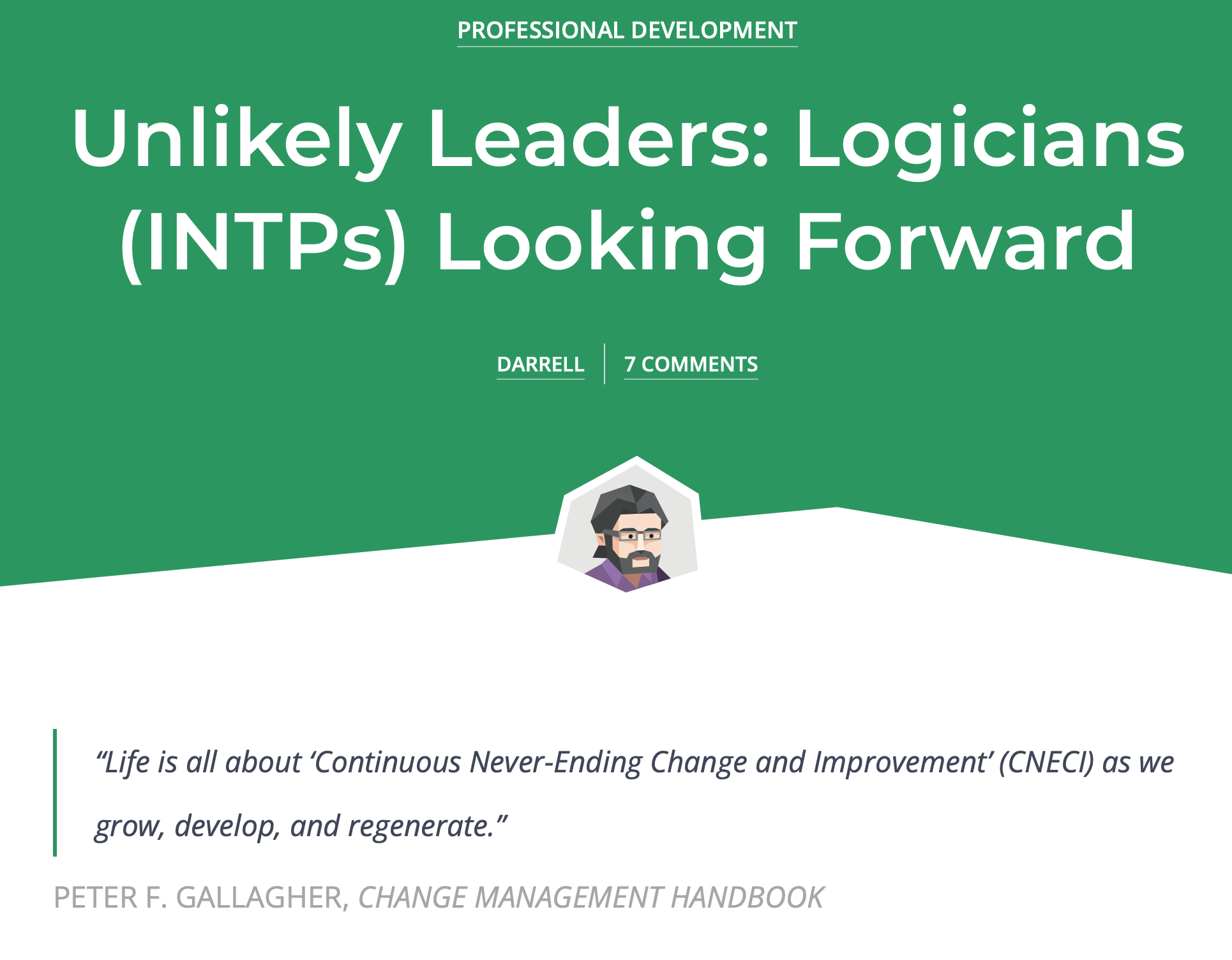 Continuous Never-Ending Change and Improvement’ (CNECI) - 16 Personalities
Continuous Never-Ending Change and Improvement’ (CNECI) - 16 Personalities
Tags: Change Management
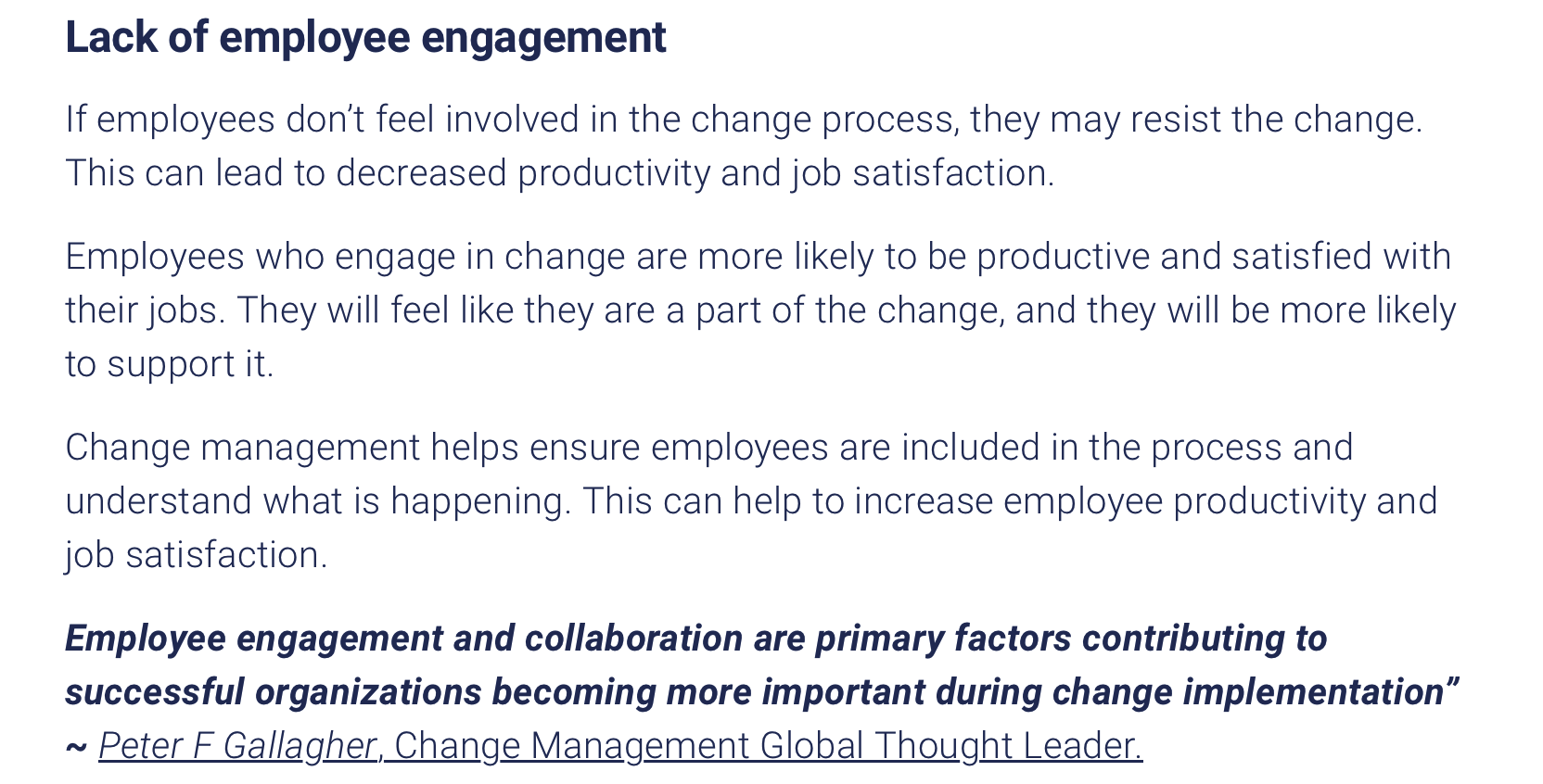 Employee Engagement and Collaboration - Monitask
Employee Engagement and Collaboration - Monitask
Tags: Change Management
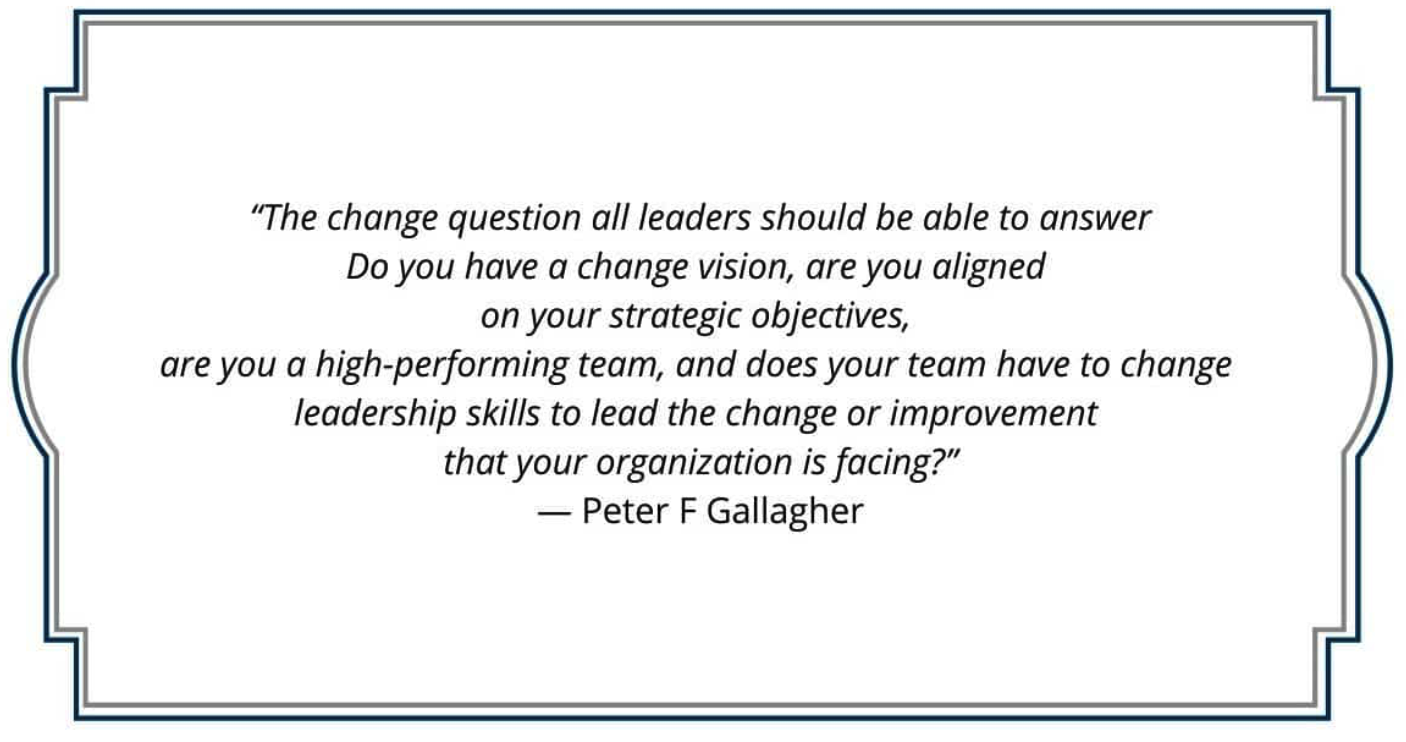 Change Leadership Alignment Question Set - CFO Systems
Change Leadership Alignment Question Set - CFO Systems
Tags: Change Management
 Human Health Education and Research Foundation (HHERF) Change Leadership Quote
Human Health Education and Research Foundation (HHERF) Change Leadership Quote
Tags: Change Management, Education
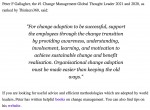 IT Modernization 2021, Part 2: 4 steps to get the job done
IT Modernization 2021, Part 2: 4 steps to get the job done
Tags: Change Management
 Change Leadership Quote - Peter F Gallagher
Change Leadership Quote - Peter F Gallagher
Tags: Change Management
 Change Management - Employee Change Behaviour Quote
Change Management - Employee Change Behaviour Quote
Tags: Change Management
 Change Management Behaviours Quote
Change Management Behaviours Quote
Tags: Change Management
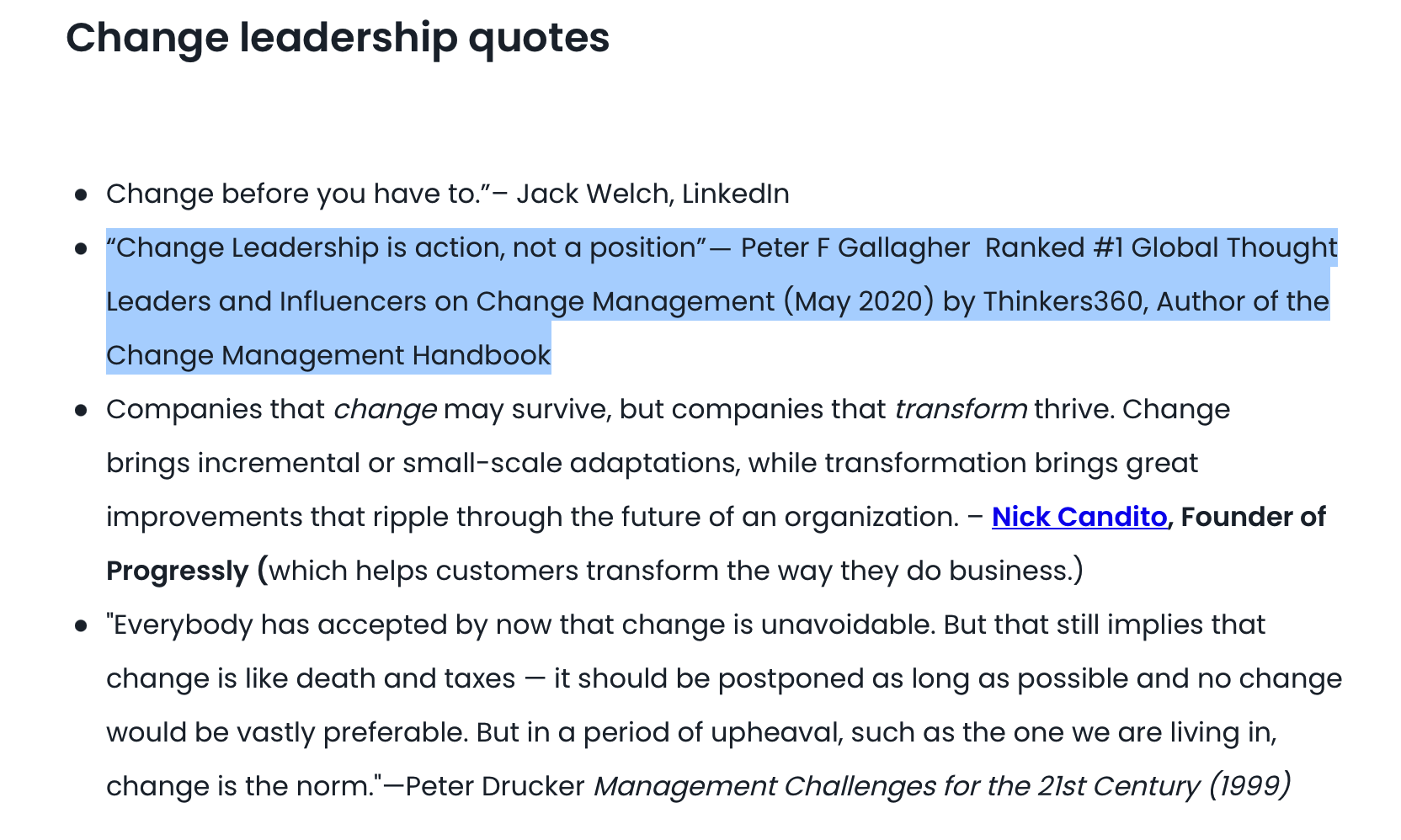 Change Leadership is Action, Not a Position - IPC Consultants
Change Leadership is Action, Not a Position - IPC Consultants
Tags: Change Management
 Change Management Quote
Change Management Quote
Tags: Change Management
 Employee Behaviour - Change Management Quote
Employee Behaviour - Change Management Quote
Tags: Change Management
 Narcissistic deluded leaders and sheep
Narcissistic deluded leaders and sheep
Tags: Change Management
 Change Management Quote Communication
Change Management Quote Communication
Tags: Business Strategy, Change Management, Leadership
 VSA International - Speaker Membership
VSA International - Speaker Membership
Tags: Business Strategy, Change Management, Leadership
 Professional Speakers Association (PSA) Member 2018
Professional Speakers Association (PSA) Member 2018
Tags: Business Strategy, Change Management, Leadership
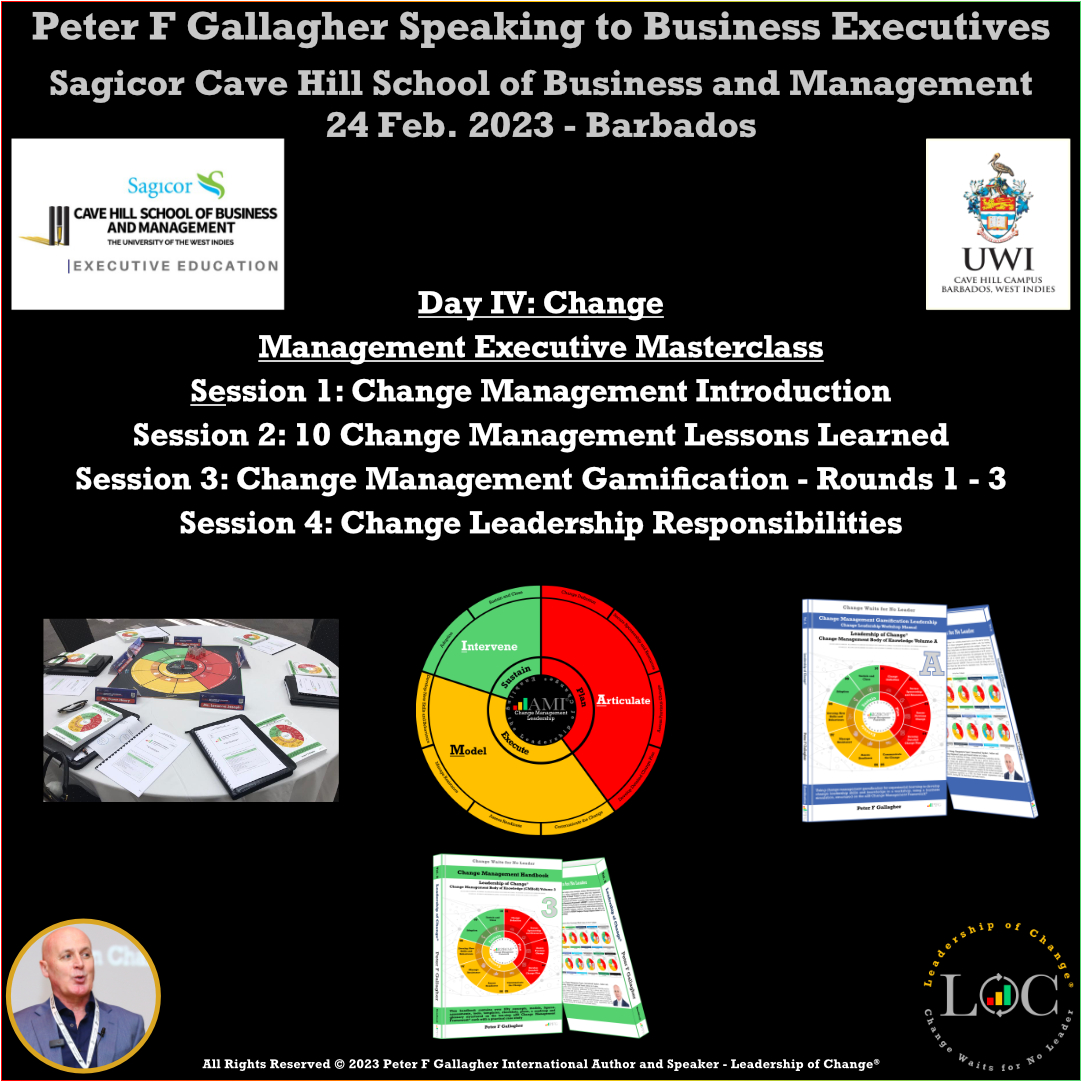 Executive Leadership Programme - Barbados: Day Four: Change
Executive Leadership Programme - Barbados: Day Four: Change
Tags: Business Strategy, Change Management, Leadership
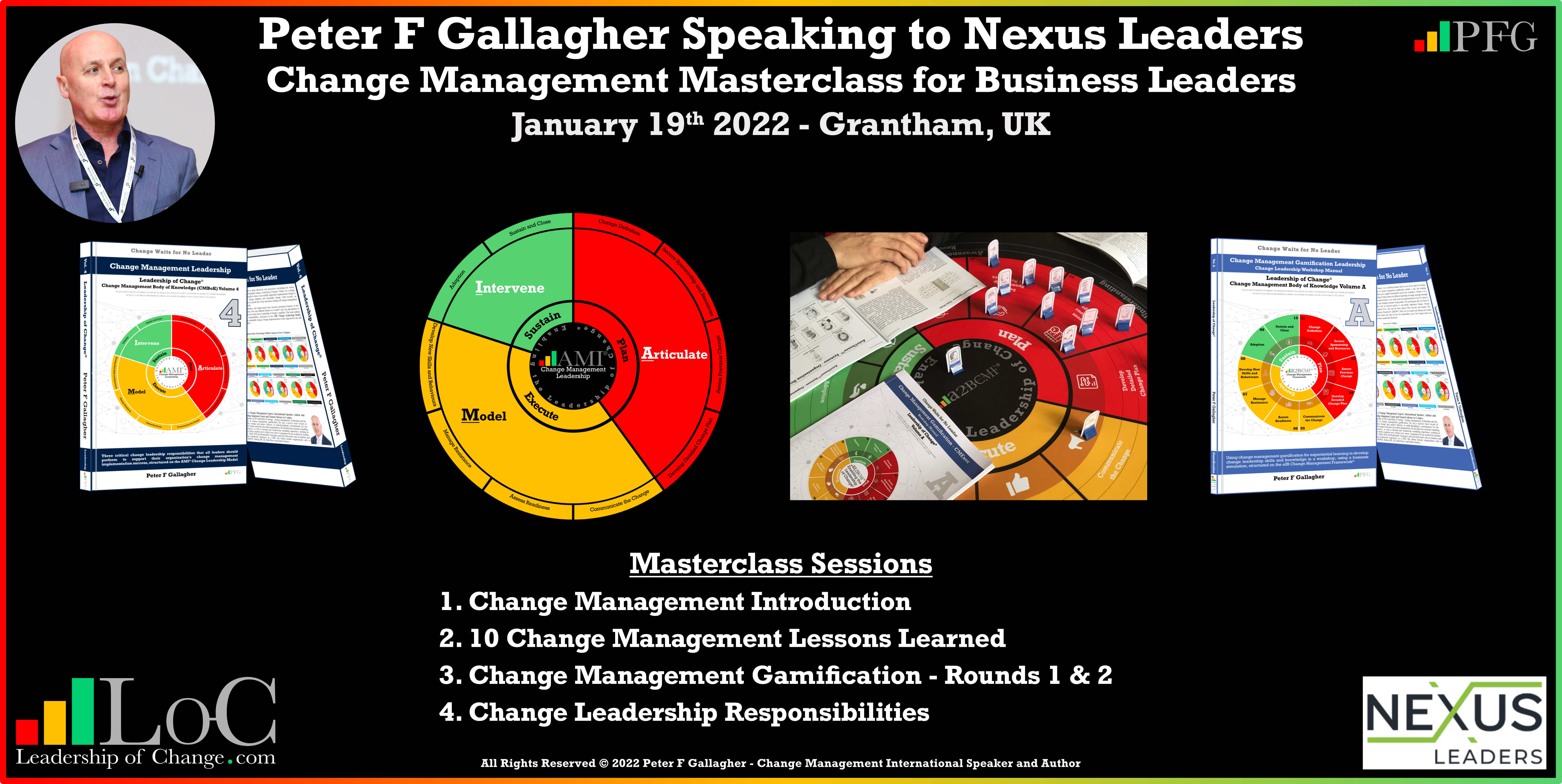 Change Management Masterclass - Peter F Gallagher Speaking to Nexus Leaders, Grantham - UK
Change Management Masterclass - Peter F Gallagher Speaking to Nexus Leaders, Grantham - UK
Tags: Business Strategy, Change Management, Leadership
 Peter F Gallagher Speaking to Vistage UK Chief Executives on the Leadership Of Change
Peter F Gallagher Speaking to Vistage UK Chief Executives on the Leadership Of Change
Tags: Business Strategy, Change Management, Leadership
 ASQ World Conference: Quality and Improvement - May 2021 - Peter F Gallagher Speaking on Change
ASQ World Conference: Quality and Improvement - May 2021 - Peter F Gallagher Speaking on Change
Tags: Business Strategy, Change Management, Leadership
 LSS World Conference: 24 - 25 March 2021 - Peter F Gallagher Speaking on Leadership of Change
LSS World Conference: 24 - 25 March 2021 - Peter F Gallagher Speaking on Leadership of Change
Tags: Business Strategy, Change Management, Leadership
 Three60 Leadership - Peter F Gallagher Speaking on Change Management to UK Business Leaders
Three60 Leadership - Peter F Gallagher Speaking on Change Management to UK Business Leaders
Tags: Business Strategy, Change Management, Leadership
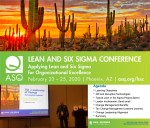 Leadership of Change - ASQ Lean Six Sigma Conference 2020 - Phoenix, AZ.
Leadership of Change - ASQ Lean Six Sigma Conference 2020 - Phoenix, AZ.
Tags: Business Strategy, Change Management, Leadership
 Linking Strategic Planning, Business Improvement and Change Management
Linking Strategic Planning, Business Improvement and Change Management
Tags: Business Strategy, Change Management, Leadership
Tags: Business Strategy, Change Management, Leadership
 Linking Strategic Planning, Business Improvement and Change Management
Linking Strategic Planning, Business Improvement and Change Management
Tags: Business Strategy, Change Management, Leadership
 Linking Strategic Planning, Business Improvement and Change Management
Linking Strategic Planning, Business Improvement and Change Management
Tags: Business Strategy, Change Management, Leadership
 Linking Strategic Planning, Business Improvement and Change Managem
Linking Strategic Planning, Business Improvement and Change Managem
Tags: Business Strategy, Change Management, Leadership
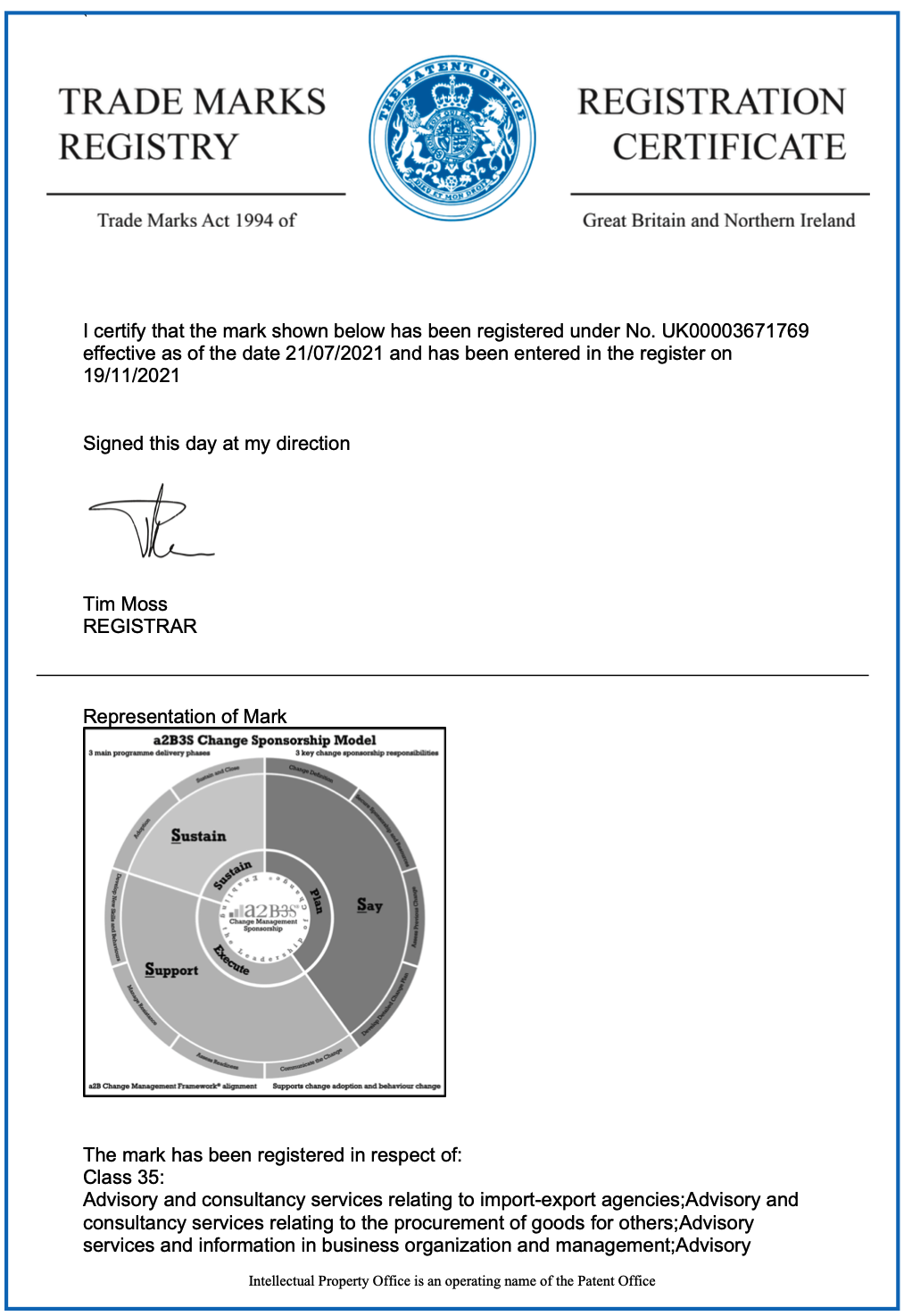 a2B3S Change Sponsorship Model
a2B3S Change Sponsorship Model
Tags: Business Strategy, Change Management, Leadership
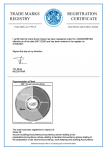 AMI Change Leadership Model
AMI Change Leadership Model
Tags: Business Strategy, Change Management, Leadership
Tags: Leadership, Change Management, Business Strategy
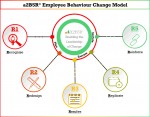 a2B5R Model: Employee Behavioural Change
a2B5R Model: Employee Behavioural Change
Tags: Leadership, Change Management, Business Strategy
 Shell Learning Process Leadership - YB Training - Aberdeen, UK
Shell Learning Process Leadership - YB Training - Aberdeen, UK
Tags: Business Strategy, Change Management, Leadership
 Shell Learning Process Leadership - YB Training - Aberdeen, UK
Shell Learning Process Leadership - YB Training - Aberdeen, UK
Tags: Business Strategy, Change Management, Leadership
 Shell Learning Process Leadership - YB Training - Aberdeen, UK
Shell Learning Process Leadership - YB Training - Aberdeen, UK
Tags: Business Strategy, Change Management, Leadership
 Shell Learning Process Leadership - YB Training - Assen, NL
Shell Learning Process Leadership - YB Training - Assen, NL
Tags: Business Strategy, Change Management, Leadership
 Shell Learning Process Leadership - YB Training - Aberdeen, UK
Shell Learning Process Leadership - YB Training - Aberdeen, UK
Tags: Business Strategy, Change Management, Leadership
 Shell Learning Process Leadership - YB Training - Aberdeen, UK
Shell Learning Process Leadership - YB Training - Aberdeen, UK
Tags: Business Strategy, Change Management, Leadership
 Shell Learning Process Leadership - EPE YB Training - Den Haag, NL
Shell Learning Process Leadership - EPE YB Training - Den Haag, NL
Tags: Business Strategy, Change Management, Leadership
 Shell Learning Process Leadership - YB Training - EPE, Aberdeen, UK
Shell Learning Process Leadership - YB Training - EPE, Aberdeen, UK
Tags: Business Strategy, Change Management, Leadership
 Shell Learning Process Leadership - EPE YB Training - Assen, NL
Shell Learning Process Leadership - EPE YB Training - Assen, NL
Tags: Business Strategy, Change Management, Leadership
 Shell Learning Process Leadership - EPE YB Training - Assen, NL
Shell Learning Process Leadership - EPE YB Training - Assen, NL
Tags: Business Strategy, Change Management, Leadership
 Training: Six Step Global Procurement Process (“GPP”) - APAC16
Training: Six Step Global Procurement Process (“GPP”) - APAC16
Tags: Change Management, Leadership, Procurement
 Training: Six Step Global Procurement Process (“GPP”) - APAC14
Training: Six Step Global Procurement Process (“GPP”) - APAC14
Tags: Change Management, Leadership, Procurement
 Training: Six Step Global Procurement Process (“GPP”) - APAC12
Training: Six Step Global Procurement Process (“GPP”) - APAC12
Tags: Change Management, Leadership, Procurement
 Training: Six Step Global Procurement Process (“GPP”) - APAC11
Training: Six Step Global Procurement Process (“GPP”) - APAC11
Tags: Change Management, Leadership, Procurement

Tags: Business Strategy, Change Management, Leadership

Tags: Business Strategy, Change Management, Leadership

Tags: Business Strategy, Change Management, Leadership

Tags: Business Strategy, Change Management, Leadership

Tags: Business Strategy, Change Management, Leadership

Tags: Business Strategy, Change Management, Leadership

Tags: Business Strategy, Change Management, Leadership

Tags: Business Strategy, Change Management, Leadership

Tags: Business Strategy, Change Management, Leadership
 Peter F Gallagher - New Webpage Design - Video Overview
Peter F Gallagher - New Webpage Design - Video Overview
Tags: Business Strategy, Change Management, Leadership
 Change Management Gamification Leadership Business Simulation - Video Overview
Change Management Gamification Leadership Business Simulation - Video Overview
Tags: Business Strategy, Change Management, Leadership

Tags: Leadership, Change Management, Business Strategy
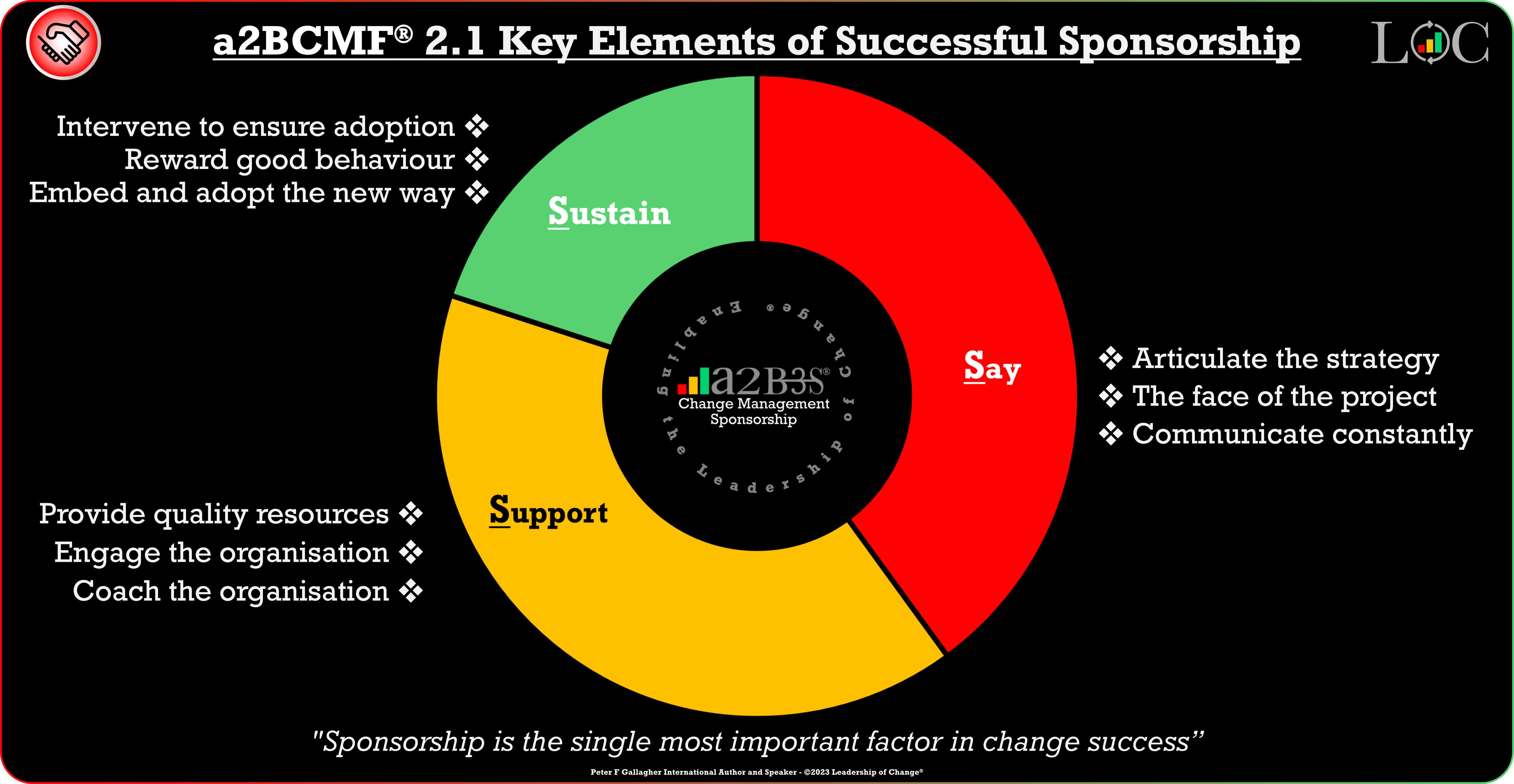 Change Management Leadership - Online Mini Masterclass A1 - 2.1 Change Sponsorship (Learning Sample)
Change Management Leadership - Online Mini Masterclass A1 - 2.1 Change Sponsorship (Learning Sample)
Tags: Business Strategy, Change Management, Leadership

Tags: Business Strategy, Change Management, Leadership
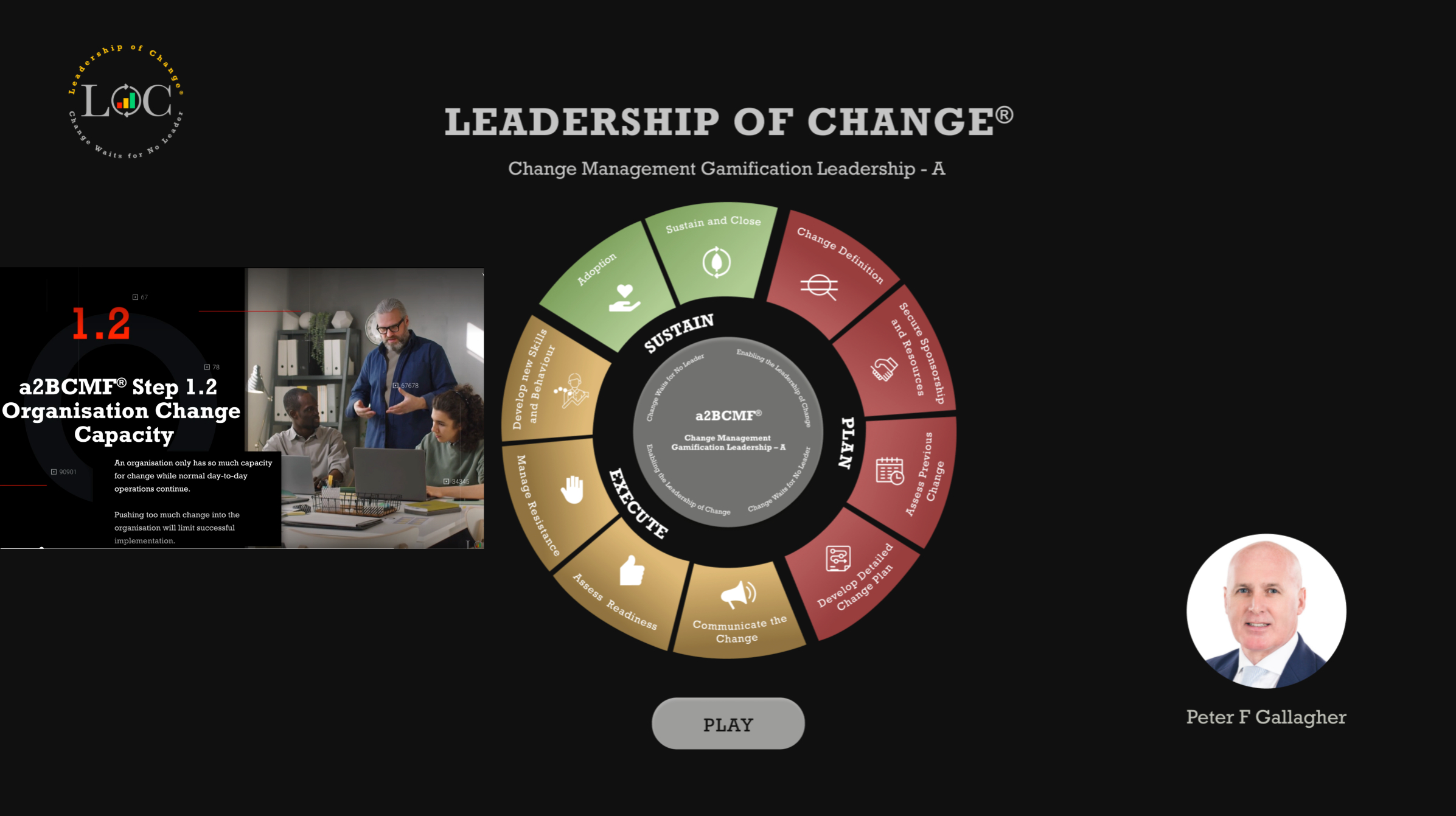 Gamification App Workshop Video 2 - a2BCMF Step 1.2 Capacity
Gamification App Workshop Video 2 - a2BCMF Step 1.2 Capacity
Tags: Business Strategy, Change Management, Leadership

Tags: Business Strategy, Change Management, Leadership

Tags: Business Strategy, Change Management, Leadership

Tags: Leadership, Change Management, Business Strategy

Tags: Business Strategy, Change Management, Leadership

Tags: Leadership, Change Management, Business Strategy

Tags: Business Strategy, Change Management, Leadership

Tags: Business Strategy, Change Management, Leadership

Tags: Business Strategy, Change Management, Leadership

Tags: Business Strategy, Change Management, Leadership

Tags: Business Strategy, Change Management, Leadership
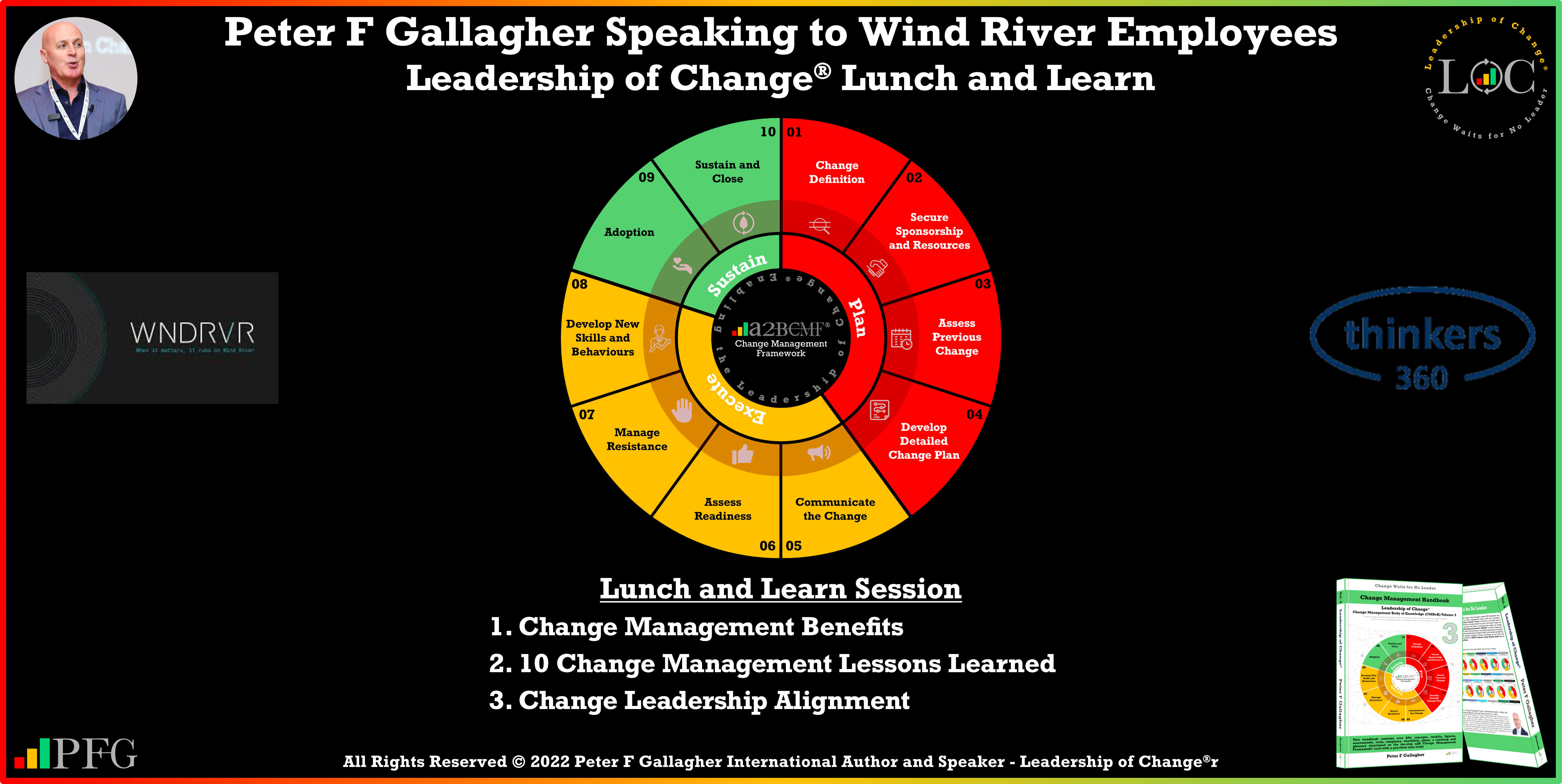 Peter F Gallagher Speaking to Wind River Employees - Leadership of Change Lunch and Learn
Peter F Gallagher Speaking to Wind River Employees - Leadership of Change Lunch and Learn
Tags: Business Strategy, Change Management, Leadership
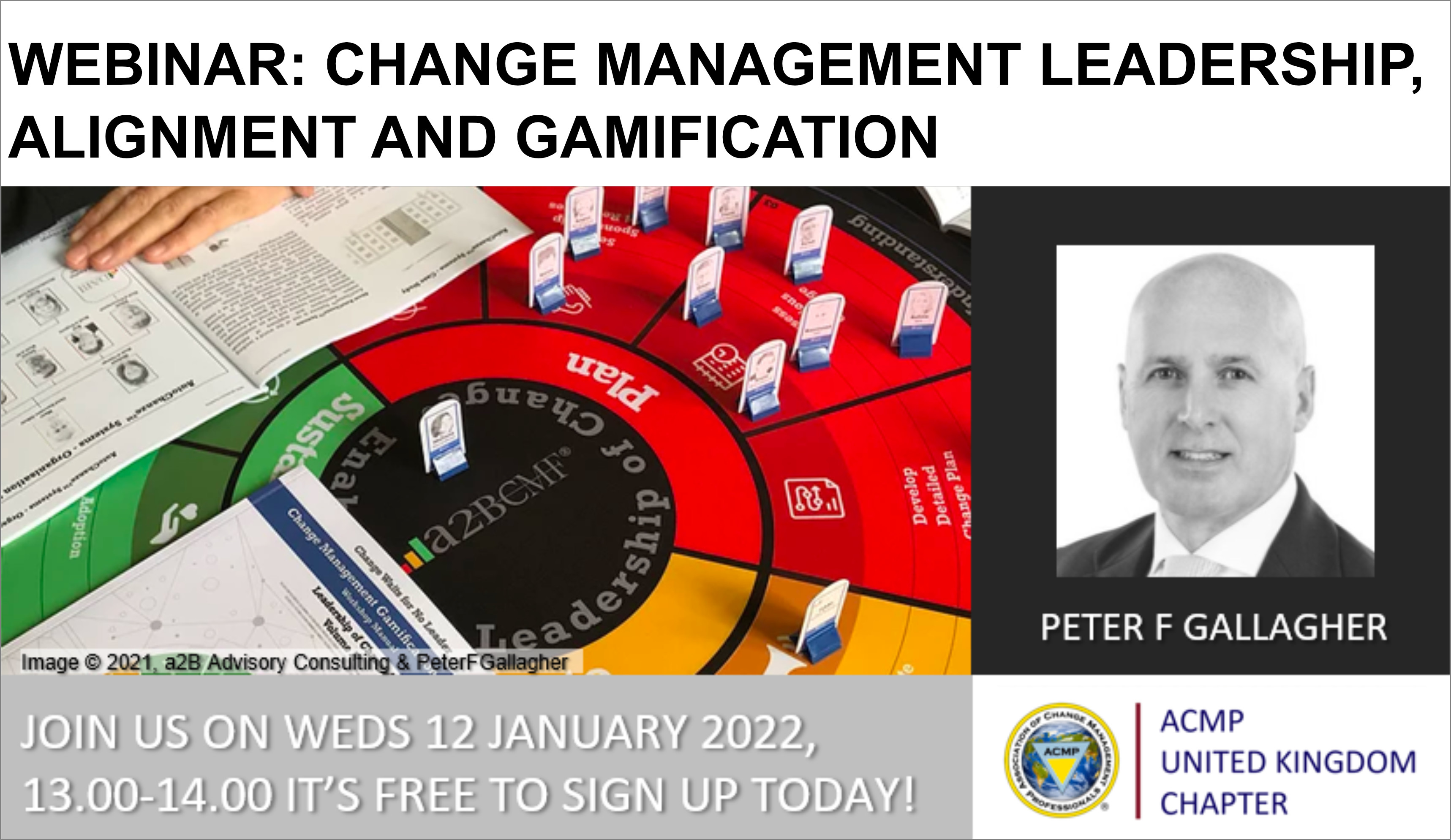 Leadership Responsibilities, Leadership Alignment, Management.
Leadership Responsibilities, Leadership Alignment, Management.
Tags: Business Strategy, Change Management, Leadership
 ASQ EMEA Virtual Conference: Nov 2021 - Peter F Gallagher Speaking on Change Leadership Lessons
ASQ EMEA Virtual Conference: Nov 2021 - Peter F Gallagher Speaking on Change Leadership Lessons
Tags: Leadership, Change Management, Business Strategy
 ASQ Great Britain Section: June 2021 - Peter F Gallagher Speaking on Change Management and Quality
ASQ Great Britain Section: June 2021 - Peter F Gallagher Speaking on Change Management and Quality
Tags: Business Strategy, Change Management, Leadership
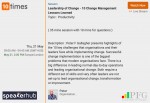 Leadership of Change - 10 Change Management Lessons Learned (SpeakerHub)
Leadership of Change - 10 Change Management Lessons Learned (SpeakerHub)
Tags: Leadership, Change Management, Business Strategy
 Leadership of Change - 10 Change Management Lessons Learned (ACMP UK)
Leadership of Change - 10 Change Management Lessons Learned (ACMP UK)
Tags: Leadership, Change Management, Business Strategy
Tags: Leadership, Change Management, Business Strategy
 Learning from Past Mistakes for Successful Change Programme Implementation
Learning from Past Mistakes for Successful Change Programme Implementation
Tags: Leadership, Change Management, Business Strategy
 Three60 Leadership - Peter F Gallagher Speaking on Change Management to UK Business Leaders
Three60 Leadership - Peter F Gallagher Speaking on Change Management to UK Business Leaders
Tags: Business Strategy, Change Management, Leadership
 Leadership Alignment High Performing Team Workshop 2 - Dusseldorf
Leadership Alignment High Performing Team Workshop 2 - Dusseldorf
Tags: Business Strategy, Change Management, Lean Startup
 Leadership Alignment Gamification Workshop 3 - Dresden
Leadership Alignment Gamification Workshop 3 - Dresden
Tags: Business Strategy, Change Management, Leadership
 Leadership Alignment High Performing Team Workshop 2 - Dresden
Leadership Alignment High Performing Team Workshop 2 - Dresden
Tags: Business Strategy, Change Management, Leadership
 Leadership Alignment Gamification Workshop 3 - Dusseldorf
Leadership Alignment Gamification Workshop 3 - Dusseldorf
Tags: Business Strategy, Change Management, Leadership
 Leadership Alignment Priorities Workshop 1 - Dresden
Leadership Alignment Priorities Workshop 1 - Dresden
Tags: Business Strategy, Change Management, Leadership
 Leadership Alignment Priorities Workshop 1 - Dusseldorf
Leadership Alignment Priorities Workshop 1 - Dusseldorf
Tags: Business Strategy, Change Management, Leadership
 EY MENA Strategy One Day Workshop - Dubai
EY MENA Strategy One Day Workshop - Dubai
Tags: Business Strategy, Change Management, Leadership
 Improving Governance and Collaboration between the Assets, the Functions and the Contractor Workshop
Improving Governance and Collaboration between the Assets, the Functions and the Contractor Workshop
Tags: Business Strategy, Change Management, Leadership
 Improving Governance and Collaboration between the Assets, the Functions and the Contractor - Kick-off
Improving Governance and Collaboration between the Assets, the Functions and the Contractor - Kick-off
Tags: Business Strategy, Change Management, Leadership
 2020 Planing and Budget Transformation 5th Jun 2013 - #2 Transformation Update
2020 Planing and Budget Transformation 5th Jun 2013 - #2 Transformation Update
Tags: Business Strategy, Change Management, Leadership
 2020 Planing and Budget Transformation - #1 1/2 Day Project Update
2020 Planing and Budget Transformation - #1 1/2 Day Project Update
Tags: Business Strategy, Change Management, Leadership
 Business improvement for Leaders - 2 day Workshop 1 of 1 - Bahrain
Business improvement for Leaders - 2 day Workshop 1 of 1 - Bahrain
Tags: Business Strategy, Change Management, Leadership
 Introduction to business improvement - 5 day Workshop 2 of 2 - Bahrain
Introduction to business improvement - 5 day Workshop 2 of 2 - Bahrain
Tags: Business Strategy, Change Management, Leadership
 2020 Transformation Programme Launch Workshop
2020 Transformation Programme Launch Workshop
Tags: Business Strategy, Change Management, Leadership
 Introduction to business improvement - 5 day Workshop 1 of 2 - Bahrain
Introduction to business improvement - 5 day Workshop 1 of 2 - Bahrain
Tags: Business Strategy, Change Management, Leadership
 Finance Transformation - Workshop Four Transformation Roadmap - Kuwait
Finance Transformation - Workshop Four Transformation Roadmap - Kuwait
Tags: Business Strategy, Change Management, Leadership
 Finance Transformation - Workshop Three Initial Design Phase - Kuwait
Finance Transformation - Workshop Three Initial Design Phase - Kuwait
Tags: Business Strategy, Change Management, Leadership
 Finance Transformation - Workshop Two Diagnose Phase - Kuwait
Finance Transformation - Workshop Two Diagnose Phase - Kuwait
Tags: Business Strategy, Change Management, Leadership
 Finance Transformation - Workshop One Identify Phase - Kuwait
Finance Transformation - Workshop One Identify Phase - Kuwait
Tags: Business Strategy, Change Management, Leadership
 Global HR Lifecycle Lean Change Project 1: HR Offer to Onseat
Global HR Lifecycle Lean Change Project 1: HR Offer to Onseat
Tags: Business Strategy, Change Management, Leadership
 NCPOC Work Permit Immigration Improvement Process - Kazakhstan SC5 Workshop Audit
NCPOC Work Permit Immigration Improvement Process - Kazakhstan SC5 Workshop Audit
Tags: Business Strategy, Change Management, Leadership
 Global HR Lifecycle Lean ESSA Change Project 2: HR Off-boarding
Global HR Lifecycle Lean ESSA Change Project 2: HR Off-boarding
Tags: Business Strategy, Change Management, Leadership
 NCPOC Work Permit Immigration Improvement Process - Kazakhstan SC4 Workshop Actions
NCPOC Work Permit Immigration Improvement Process - Kazakhstan SC4 Workshop Actions
Tags: Business Strategy, Change Management, Leadership
 KCO Hydrotest Lean Project: Phase 2 Kazakhstan, Caspian Sea Island
KCO Hydrotest Lean Project: Phase 2 Kazakhstan, Caspian Sea Island
Tags: Business Strategy, Change Management, Leadership
Date : January 28, 2021
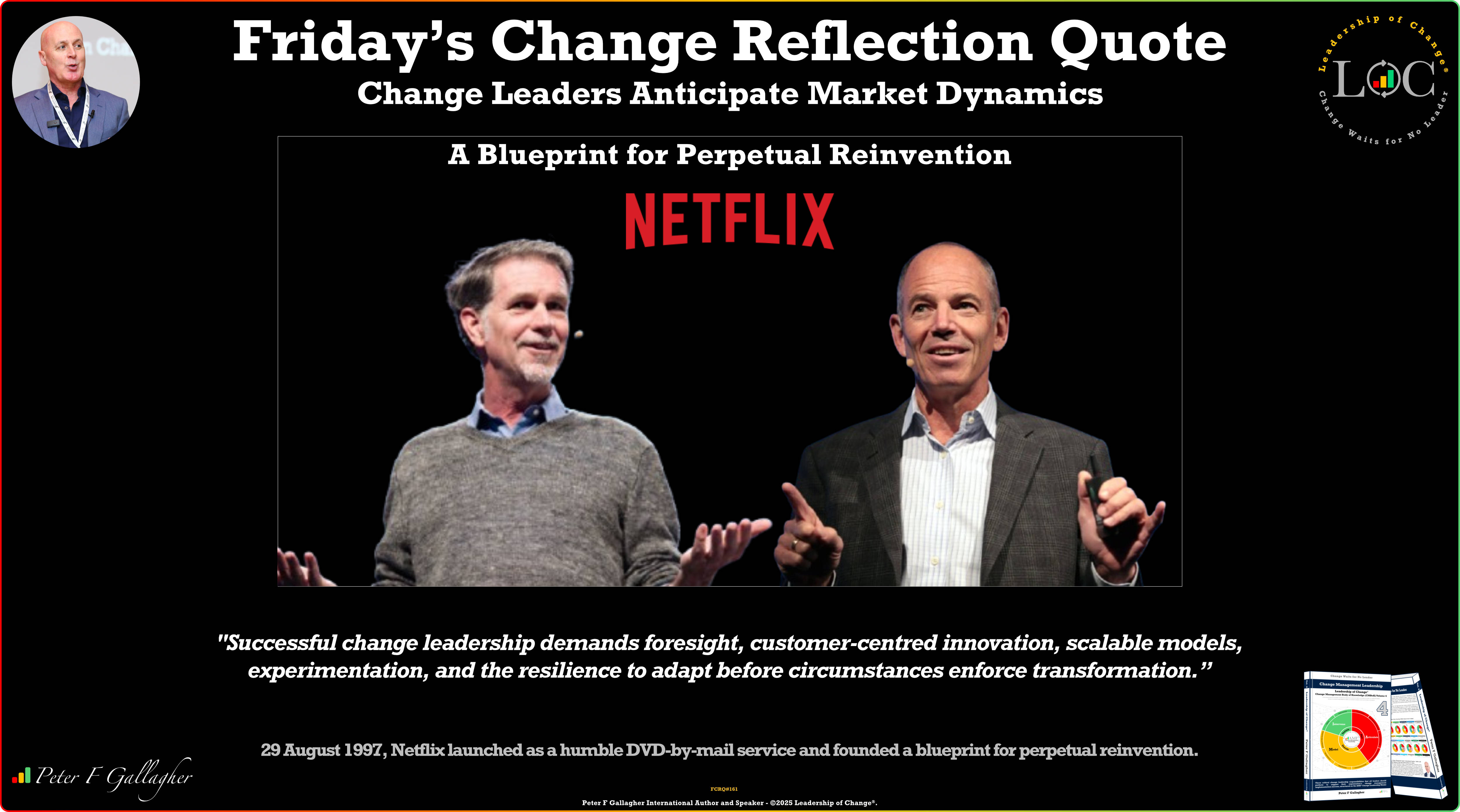 Friday’s Change Reflection Quote - Leadership of Change - Change Leaders Anticipate Market Dynamics
Friday’s Change Reflection Quote - Leadership of Change - Change Leaders Anticipate Market Dynamics
Leadership Learning!
On this day 29 August 1997, Netflix launched as a humble DVD-by-mail service and founded a blueprint for perpetual reinvention, proving that the greatest leaders architect organisations capable of transforming themselves before the market forces them to. Founded by Reed Hastings and Marc Randolph in Scotts Valley, California, Netflix grew from a simple yet daring idea tested through a single experiment: mailing a CD to prove DVDs could be reliably delivered by post. When the test succeeded, they entered the $16 billion home-video industry with revolutionary ambition. In April 1998 the company launched its website offering DVD rentals by mail, beginning with 30 employees and 925 titles. The mailing of DVDs and the introduction of an online platform foreshadowed a deep shift in media consumption and distribution, setting the stage for a subscription model that would eventually eclipse physical media. Importantly, the company was agile, experimental and willing to challenge entrenched norms not through bravado, but by solving a clear logistical problem through innovative technology. By the end of the first year, Netflix had already begun to differentiate itself by eliminating late fees, introducing greater convenience and embracing the potential of e-commerce. From the outset, the company embraced a culture of continuous experimentation, data-driven decision-making and customer obsession that would prove prophetic. These early decisions were neither flashy nor grandiose. They were grounded in safeguarding customer experience while testing the boundaries of emerging technology. As such, the foundation was laid for a company that would later pivot into a streaming powerhouse. In respectful reflection of those early days, one can appreciate that true leadership and change emerge not from self-promotion, but from quietly reimagining how things are done. The emphasis was not on discrediting competitors, but on solving a problem better. Critique of the DVD-by-mail approach might point to limitations, as it relied on postal infrastructure and physical media. Yet rather than disparaging the pioneers, the lesson lies in examining the challenge they addressed: delivering films differently, in a more consumer-centric way, without compromising practicality or customer trust. The historical significance of Netflix's foundation cannot be overstated. It illustrates how modest experimentation, such as testing a CD in the mail, can ignite a transformation in an entire industry. The launch in 1997 was not the pinnacle, but the prelude to continual reinvention. It underlined how organisational design, a willingness to test bold ideas and iterative learning would come to define future leadership. The emphasis on solving a core problem, not outmuscling incumbents, underpinned a culture of trust, resilience and foresight.
Change Leadership Lessons: Netflix's transformation journey reveals five fundamental principles that distinguish exceptional change leadership from reactive management approaches. Leaders of change anticipate emerging trends and position their organisations ahead of industry transformation through strategic foresight, data-driven decision-making and careful preparation. They design solutions around customer needs and frustrations, ensuring long-term relevance while strengthening competitive advantage in evolving markets. Change leaders build scalable business models and adaptable infrastructures that allow their organisations to thrive as technologies and markets shift. They embrace experimentation and are willing to test bold ideas, fostering innovation and laying the foundation for sustainable reinvention. Leaders of change recognise obsolescence early and adapt decisively, ensuring organisational resilience and ongoing success in dynamic environments. Change Leaders Anticipate Market Dynamics.
"Successful change leadership demands foresight, customer-centred innovation, scalable models, experimentation, and the resilience to adapt before circumstances enforce transformation.”
Application. Change Leadership Responsibility 1 - Articulate a Change Vision: Netflix's foundation demonstrates that articulating a compelling change vision begins with identifying customer frustrations that entire industries have accepted as inevitable. By recognising that late fees, limited selection, and inconvenient store hours represented systemic problems rather than necessary evils, the founders articulated a vision that challenged fundamental assumptions about entertainment access. The initial vision was modest yet transformational, embedding subscription convenience within familiar DVD technology. Effective change leaders articulate visions that acknowledge present limitations whilst signalling future possibilities, such as evolving from postal delivery to streaming platforms. Such vision-building ensures stakeholders understand both the immediate value proposition and the long-term transformation potential, creating momentum that sustains reinvention journeys across multiple technological shifts.
Final Thoughts: Exceptional change leadership emerges when leaders solve customer problems that entire industries have normalised as acceptable limitations. Sustainable transformation requires building organisational capabilities for continuous reinvention rather than optimising existing approaches.
Further Reading: Change Management Leadership - Leadership of Change® Volume 4.
Peter F. Gallagher consults, speaks, and writes on Leadership of Change®. He works exclusively with boards, CEOs, and senior leadership teams to prepare and align them to effectively and proactively lead their organisations through change and transformation.
For further reading please visit our websites: https://www.a2b.consulting https://www.peterfgallagher.com Amazon.com: Peter F Gallagher: Books, Biography, Blog, Audiobooks, Kindle
Leadership of Change® Body of Knowledge Volumes: Change Management Body of Knowledge (CMBoK) Books: Volumes 1, 2, 3, 4, 5, 6, 7, 8, 9, 10, A, B, C, D & E available on both Amazon and Google Play:
~ Leadership of Change® Volume 1 - Change Management Fables
~ Leadership of Change® Volume 2 - Change Management Pocket Guide
~ Leadership of Change® Volume 3 - Change Management Handbook
~ Leadership of Change® Volume 4 - Change Management Leadership
~ Leadership of Change® Volume 5 - Change Management Adoption
~ Leadership of Change® Volume 6 - Change Management Behaviour
~ Leadership of Change® Volume 7 - Change Management Sponsorship
~ Leadership of Change® Volume 8 - Change Management Charade
~ Leadership of Change® Volume 9 - Change Management Insanity
~ Leadership of Change® Volume 10 - Change Management Dilenttante
~ Leadership of Change® Volume A - Change Management Gamification - Leadership
~ Leadership of Change® Volume B - Change Management Gamification - Adoption
Peter F. Gallagher consults, speaks, and writes on Leadership of Change®. He works exclusively with boards, CEOs, and senior leadership teams to prepare and align them to effectively and proactively lead their organisations through change and transformation.
For insights on navigating organisational change, feel free to reach out at Peter.gallagher@a2B.consulting.
#LeadershipofChange #Leadership #ChangeLeadership #GlobalGurus #ChangeManagement #Netflix #ReedHastings #MarcRandolph
Tags: Business Strategy, Change Management, Leadership
 Friday’s Change Reflection Quote - Leadership of Change - Change Leaders Replace Outdated Ideologies
Friday’s Change Reflection Quote - Leadership of Change - Change Leaders Replace Outdated Ideologies
Leadership Learning!
On this day, 22 August 1904, Deng Xiaoping was born as a future leader whose pragmatic vision and decisive reforms would not only reshape China's trajectory but also alter the global economic landscape. In the aftermath of the Cultural Revolution, China stood at a crossroads. For more than a decade, the country had endured intellectual suppression, the dismantling of institutions, and widespread disruption across its economic and scientific sectors. With universities closed and scientists denounced, China's technological and industrial capabilities had suffered significant setbacks. It was in this fragile context that Deng Xiaoping rose to prominence, gradually reasserting influence after repeated political purges. His return to power marked not just a shift in leadership but a profound shift in national direction. At the National Conference on Science and Education, Deng called for the rehabilitation of intellectuals and scientists, arguing that science and technology were essential forces of production. He insisted that education, research, and open engagement with global scientific knowledge must be prioritised. The speech marked a dramatic break from ideological purges, reinstating rationality, meritocracy, and pragmatism at the core of China’s development. Deng declared that the Four Modernisations in agriculture, industry, defence, and science and technology were key to national progress. This approach laid the groundwork for what would soon become a sweeping reform agenda, opening the door to global exchange, institutional rebuilding, and economic liberalisation. The historical significance of this moment is vast. It marked a turning point where ideological rigidity gave way to a more open, forward looking national strategy. Within a year, China would launch policies that reversed years of isolation and set a course towards becoming a major global economy. The event also catalysed the re-establishment of higher education institutions, scientific academies, and international academic collaboration. The 1977 speech laid the foundation for the reform era that began in earnest in 1978. The long-term impact of this inflection point is reflected today in China's position as a global leader in technology, infrastructure, and innovation. More than four decades later, the decision to place scientific inquiry and education at the heart of national revival stands as a powerful example of strategic leadership. It underlines how, even in the face of significant institutional decay and public scepticism, a carefully timed and clearly articulated vision can rebuild trust, restore capability, and ignite sustained transformation. While Deng's approach was deeply rooted in China's specific political and cultural context, the underlying principle of re enabling institutional competence and long-term investment in knowledge offers enduring insights into change leadership. By setting aside ideological extremism and focusing on the essential levers of modernisation, Deng shifted the trajectory of over a billion people. This moment offers a historical case of how leadership choices in times of national uncertainty can drive generational change.
Change Leadership Lessons: The transformation Deng initiated reveals fundamental principles of effective change leadership. Leaders of change must focus on restoring trust in institutions like science and education after periods of disruption or neglect. They must be prepared to replace rigid ideology with practical strategies that support long-term growth and renewal. Change leaders recognise that valuing and empowering expert voices strengthens a nation’s capacity for innovation and reform. They establish strategic priorities to focus national efforts and lay the groundwork for sustainable transformation. Leaders of change build credibility by taking visible actions that create momentum and demonstrate commitment to the change agenda.Change Leaders Replace Outdated Ideologies.
“Change leaders rebuild trust in broken systems, replace outdated ideologies, empower expertise, set strategic direction, and act decisively to create sustainable momentum for transformation.”
Application. Change Leadership Responsibility 1 - Articulate a Change Vision: Deng Xiaoping's 1977 speech demonstrates that articulating a compelling change vision requires courage to challenge entrenched systems whilst offering a credible alternative path forward. The vision transcended ideological constraints by focusing on tangible outcomes like modernisation, scientific progress, and national renewal. While the speech addressed immediate concerns about China's technological lag, it simultaneously embedded long-term transformation through structured commitments to education and research. Effective change leaders must build visions that address current organisational challenges while establishing foundations for sustained renewal through institutional capability building. This requires a leadership approach that replaces outdated paradigms without creating destabilising uncertainty amongst stakeholders. By framing the vision around tangible modernisation goals, Deng enabled progressive momentum to build within a complex political environment. Articulating such a vision means clearly communicating both the immediate necessity for change and the transformative potential, so that all stakeholders understand the urgency whilst remaining committed throughout the transformation journey.
Final Thoughts: Strategic change requires more than reform; it demands the courage to challenge deeply embedded systems with practical and inclusive alternatives. When leaders replace outdated ideologies with visionary action, they unlock momentum that can reshape institutions for future generations.
Further Reading: Change Management Leadership - Leadership of Change® Volume 4.
Peter F. Gallagher consults, speaks, and writes on Leadership of Change®. He works exclusively with boards, CEOs, and senior leadership teams to prepare and align them to effectively and proactively lead their organisations through change and transformation.
For insights on navigating organisational change, feel free to reach out at Peter.gallagher@a2B.consulting.
#LeadershipofChange #Leadership #ChangeLeadership #GlobalGurus #ChangeManagement #Deng Xiaoping #CulturalRevolution
Further Reading: Change Management Leadership - Leadership of Change® Volume 4.
Peter F. Gallagher consults, speaks, and writes on Leadership of Change®. He works exclusively with boards, CEOs, and senior leadership teams to prepare and align them to effectively and proactively lead their organisations through change and transformation.
For insights on navigating organisational change, feel free to reach out at Peter.gallagher@a2B.consulting.
For further reading please visit our websites: https://www.a2b.consulting https://www.peterfgallagher.com Amazon.com: Peter F Gallagher: Books, Biography, Blog, Audiobooks, Kindle
Leadership of Change® Body of Knowledge Volumes: Change Management Body of Knowledge (CMBoK) Books: Volumes 1, 2, 3, 4, 5, 6, 7, 8, 9, 10, A, B, C, D & E available on both Amazon and Google Play:
~ Leadership of Change® Volume 1 - Change Management Fables
~ Leadership of Change® Volume 2 - Change Management Pocket Guide
~ Leadership of Change® Volume 3 - Change Management Handbook
~ Leadership of Change® Volume 4 - Change Management Leadership
~ Leadership of Change® Volume 5 - Change Management Adoption
~ Leadership of Change® Volume 6 - Change Management Behaviour
~ Leadership of Change® Volume 7 - Change Management Sponsorship
~ Leadership of Change® Volume 8 - Change Management Charade
~ Leadership of Change® Volume 9 - Change Management Insanity
~ Leadership of Change® Volume 10 - Change Management Dilenttante
~ Leadership of Change® Volume A - Change Management Gamification - Leadership
~ Leadership of Change® Volume B - Change Management Gamification - Adoption
Tags: Business Strategy, Change Management, Leadership
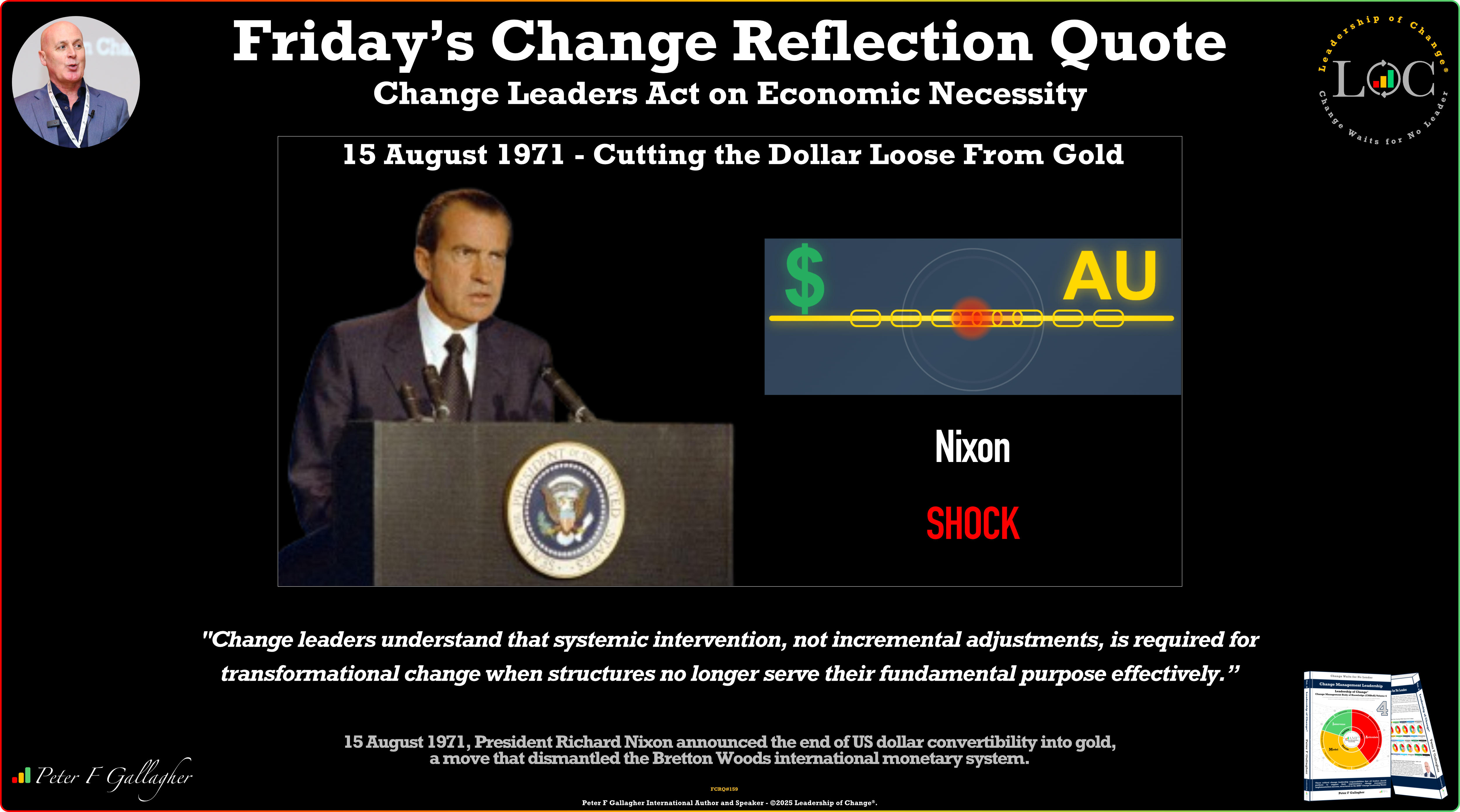 Friday’s Change Reflection Quote - Leadership of Change - Change Leaders Act on Economic Necessity
Friday’s Change Reflection Quote - Leadership of Change - Change Leaders Act on Economic Necessity
Leadership Learning!
On this day, 15 August 1971, President Richard Nixon announced the end of US dollar convertibility into gold, a move that dismantled the Bretton Woods international monetary system. Delivered via televised address, the decision transformed the dollar into a fiat currency and reshaped global finance. Nixon’s unilateral cancellation of direct international convertibility—the act frequently described as cutting the dollar loose from gold—became known as the “Nixon Shock”, one of the most significant economic policy reversals in modern history. The context was mounting economic pressure. During the 1960s the United States endured fiscal strain from Vietnam War spending and expanded domestic social programmes. At the same time, trade partners such as Germany and Japan accumulated large dollar reserves and kept currencies deliberately undervalued to support export growth. As American gold reserves fell, Nixon acted partly to force surplus nations to revalue, using convertibility suspension as leverage, and to buy time to address inflationary pressure and employment concerns. The decision emerged after three days of secret deliberations at Camp David in August 1971, where Nixon and his principal economic advisers debated the nation’s monetary future. The gravity of this choice was not lost on key participants; Treasury Secretary John Connally observed in advance, “We may never go back to it [convertibility]. I suspect we never will.” The move combined political theatre with economic brinkmanship, a reminder that leadership often blends public symbolism with technical policy-making. Markets reacted almost immediately. Exchange rates began floating freely, producing unprecedented volatility and uncertainty. What had been a stable, predictable exchange-rate mechanism suddenly became fluid and market-driven, and currencies moved in response to news and sentiment rather than fixed parities. Countries holding substantial dollar balances found themselves relying on the “full faith and credit” of the United States rather than tangible gold backing. The consequences reached far beyond technical adjustments. The end of gold convertibility entrenched the dollar’s position as the dominant global reserve currency, granting the United States unique privileges—including the ability to run persistent trade deficits—while also creating systemic vulnerabilities tied to US fiscal and monetary policy. The immediate volatility morphed into a new normal for floating exchange regimes, altering how nations conducted trade, managed reserves, and framed monetary policy. The Nixon Shock shows how even robust, complex systems can be overturned when economic realities change. Bretton Woods had supplied stability for two decades, yet once its foundations eroded, bold intervention became inevitable. The speed and comprehensiveness of the shift and the readiness to defy precedent demonstrate how decisive leadership can reconfigure global structures almost overnight.
Change Leadership Lessons: This historic moment offers profound insights into systemic transformation and the courage required to abandon familiar frameworks when they no longer serve their purpose. Nixon’s unilateral action, taken despite the risk of international backlash, shows how leaders must sometimes prioritise long-term strategic interests over short-term diplomatic convenience. The enduring consequences of this decision continue to shape global economic relations, monetary policy, and the structure of international finance. Leaders of change recognise when incremental adjustments prove insufficient to address fundamental structural problems requiring comprehensive systemic transformation. They create secure environments for intensive analysis away from external pressures and media scrutiny during critical decision-making processes. Change leaders act unilaterally when circumstances demand immediate intervention rather than seeking consensus that might result in paralysing organisational delays. They must recognise when underlying conditions make transformation inevitable and act decisively to maintain control over complex transition processes. Leaders of change require intellectual courage to dismantle familiar structures when changing circumstances render their core assumptions fundamentally obsolete. Change Leaders Act on Economic Necessity.
“Change leaders understand that systemic intervention, not incremental adjustments, is required for transformational change when structures no longer serve their fundamental purpose effectively.”
Application: Change Leadership Responsibility 1 - Articulate a Change Vision: The Nixon Shock demonstrates that articulating a compelling change vision requires leaders to confront systemic failure whilst presenting a credible alternative pathway forward. When existing structures become economically unsustainable, the vision must clearly communicate both the necessity for transformation and the potential stability that new approaches can provide. Effective change visions acknowledge current pressures without creating paralysing uncertainty for stakeholders. Leaders must frame fundamental shifts as inevitable responses to changed realities rather than experimental departures from proven methods. The vision should emphasise long term organisational sustainability over short term convenience, ensuring that all stakeholders understand the rationale for abandoning familiar frameworks. This requires transparent communication about underlying conditions that make transformation essential whilst maintaining confidence in the organisation's capacity to navigate complex transitions successfully. The change vision for this situation communicates that abandoning gold convertibility, whilst disruptive, provides essential monetary flexibility to address economic pressures and establish sustainable fiscal foundations for future prosperity.
Final Thoughts: Transformational change requires leaders who recognise when economic realities make familiar systems obsolete and act decisively despite uncertainty. The courage to abandon established frameworks, even when they have provided decades of stability, distinguishes truly effective change leadership from incremental management.
Further Reading: Change Management Leadership - Leadership of Change® Volume 4.
Peter F. Gallagher consults, speaks, and writes on Leadership of Change®. He works exclusively with boards, CEOs, and senior leadership teams to prepare and align them to effectively and proactively lead their organisations through change and transformation.
For insights on navigating organisational change, feel free to reach out at Peter.gallagher@a2B.consulting.
For further reading please visit our websites: https://www.a2b.consulting https://www.peterfgallagher.com Amazon.com: Peter F Gallagher: Books, Biography, Blog, Audiobooks, Kindle
Leadership of Change® Body of Knowledge Volumes: Change Management Body of Knowledge (CMBoK) Books: Volumes 1, 2, 3, 4, 5, 6, 7, 8, 9, 10, A, B, C, D & E available on both Amazon and Google Play:
~ Leadership of Change® Volume 1 - Change Management Fables
~ Leadership of Change® Volume 2 - Change Management Pocket Guide
~ Leadership of Change® Volume 3 - Change Management Handbook
~ Leadership of Change® Volume 4 - Change Management Leadership
~ Leadership of Change® Volume 5 - Change Management Adoption
~ Leadership of Change® Volume 6 - Change Management Behaviour
~ Leadership of Change® Volume 7 - Change Management Sponsorship
~ Leadership of Change® Volume 8 - Change Management Charade
~ Leadership of Change® Volume 9 - Change Management Insanity
~ Leadership of Change® Volume 10 - Change Management Dilenttante
~ Leadership of Change® Volume A - Change Management Gamification - Leadership
~ Leadership of Change® Volume B - Change Management Gamification - Adoption
Tags: Business Strategy, Change Management, Leadership
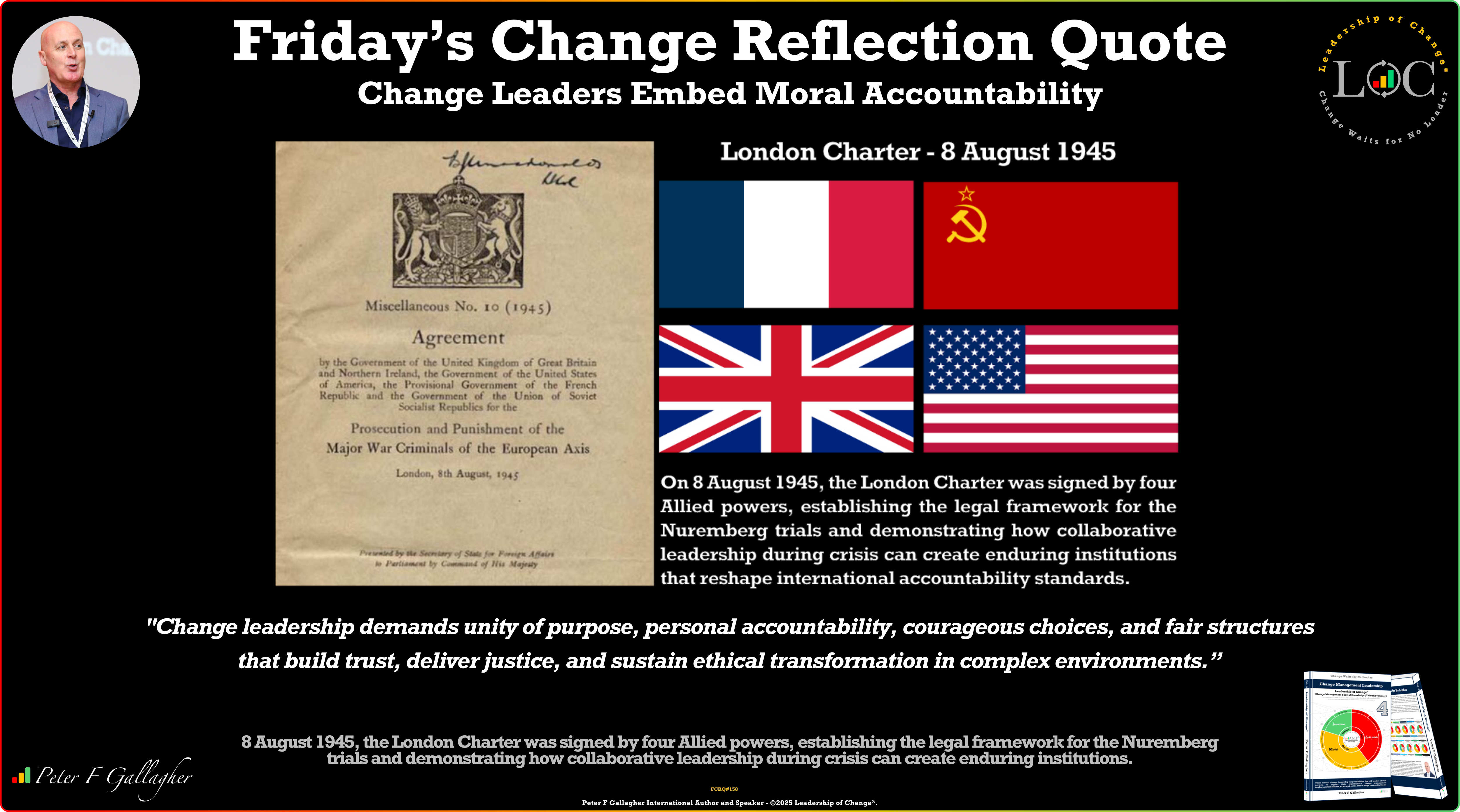 Friday’s Change Reflection Quote - Leadership of Change - Change Leaders Embed Moral Accountability
Friday’s Change Reflection Quote - Leadership of Change - Change Leaders Embed Moral Accountability
Leadership Learning!
On this day, 8 August 1945, the London Charter was signed by four Allied powers, establishing the legal framework for the Nuremberg trials and demonstrating how collaborative leadership during crisis can create enduring institutions that reshape international accountability standards. The London Charter of the International Military Tribunal was agreed upon by representatives from the United Kingdom, the United States, the Soviet Union, and France. It defined core charges including crimes against peace, war crimes, and crimes against humanity, and outlined procedures for fair trial standards. The Nuremberg trials that followed marked the first truly international war crimes tribunal, setting a precedent for principled legal processes that hold leaders accountable for mass atrocities and shaping the future of global justice. The historical significance of this agreement lies in its precedent-setting approach to international justice, directly influencing the formation of later bodies such as the International Criminal Court. The context of 1945 was one of exhausted nations emerging from the most devastating conflict in human history. With much of Europe and parts of Asia in ruins, and public awareness of the Holocaust and other atrocities coming to light, the Allied powers were under immense pressure to show not only that justice would be done, but that it would be done fairly. The London Charter marked a moment where leaders chose principle over vengeance, legality over expedience, and cooperation over fragmentation. It was a critical departure from the victor’s justice seen in previous centuries. Instead of punitive reprisals, the Allied leaders built a new international legal framework with the intention of setting a lasting standard for future conduct in times of war and peace. While political tensions already existed between the Allied nations, they nonetheless coalesced around a shared understanding of accountability and moral responsibility. That unity was tested as geopolitical alliances began to strain, foreshadowing the Cold War. Yet those differences were set aside for a greater good. The collaborative spirit embedded in the London Charter contrasts with the often-fractured nature of international responses to conflict today. The Nuremberg trials brought prominent Nazi leaders to justice and introduced legal concepts that continue to influence transitional justice efforts worldwide. The notion that individuals, including heads of state, could be held personally responsible for crimes against humanity was revolutionary. By establishing a transparent process rooted in evidence and legal reasoning, the London Charter began the difficult work of rebuilding global trust in justice. That legacy endures in modern frameworks for human rights law and continues to challenge leaders to uphold the principles first laid down in that pivotal agreement.
Change Leadership Lessons: This legal innovation was a powerful demonstration of multinational leadership under extreme pressure offering lessons which remain vital for change leaders today. This pivotal legal moment offers more than historical insight; it offers essential lessons for leading change in today’s complex environments. Leaders of change unify around a shared purpose to drive collective action in the face of complicated and urgent challenges. They build strong legal and operational frameworks that support accountability, fairness, and consistency throughout the change journey. Change leaders take personal responsibility for decisions and outcomes, ensuring ethical integrity remains central to all actions. They prioritise transparent and fair processes that reinforce legitimacy, trust, and confidence in the change being led. Leaders of change make courageous decisions that balance long-term principles with the demands of short-term pressure and uncertainty. Change Leaders Embed Moral Accountability.
“Change leadership demands unity of purpose, personal accountability, courageous choices, and fair structures that build trust, deliver justice, and sustain ethical transformation in complex environments.”
Application – Change Leadership Responsibility 1 - Articulate a Change Vision: The signing of the London Charter exemplifies that articulating a compelling change vision requires courage to challenge entrenched systems while offering a credible alternative path forward. This vision transcended ideological constraints by focusing on tangible outcomes such as international justice, accountability, and the rule of law. This requires a leadership approach that replaces outdated paradigms without creating destabilising uncertainty among stakeholders. By framing the vision around tangible goals of justice and accountability, the Allied leaders enabled progressive momentum to build within a complex geopolitical environment. Articulating a forward-thinking vision means clearly communicating both the immediate necessity for change and the transformative potential, ensuring that all stakeholders understand the urgency while remaining committed throughout the transformation journey.
Final Thoughts: Enduring change is built on the courage to lead ethically, even when the stakes are high and consensus is difficult. When leaders unify around moral purpose and structured action, they transform not only systems, but also the trust they depend on.
Further Reading: Change Management Leadership - Leadership of Change® Volume 4.
Peter F. Gallagher consults, speaks, and writes on Leadership of Change®. He works exclusively with boards, CEOs, and senior leadership teams to prepare and align them to effectively and proactively lead their organisations through change and transformation.
For insights on navigating organisational change, feel free to reach out at Peter.gallagher@a2B.consulting.
For further reading please visit our websites: https://www.a2b.consulting https://www.peterfgallagher.com Amazon.com: Peter F Gallagher: Books, Biography, Blog, Audiobooks, Kindle
Leadership of Change® Body of Knowledge Volumes: Change Management Body of Knowledge (CMBoK) Books: Volumes 1, 2, 3, 4, 5, 6, 7, 8, 9, 10, A, B, C, D & E available on both Amazon and Google Play:
~ Leadership of Change® Volume 1 - Change Management Fables
~ Leadership of Change® Volume 2 - Change Management Pocket Guide
~ Leadership of Change® Volume 3 - Change Management Handbook
~ Leadership of Change® Volume 4 - Change Management Leadership
~ Leadership of Change® Volume 5 - Change Management Adoption
~ Leadership of Change® Volume 6 - Change Management Behaviour
~ Leadership of Change® Volume 7 - Change Management Sponsorship
~ Leadership of Change® Volume 8 - Change Management Charade
~ Leadership of Change® Volume 9 - Change Management Insanity
~ Leadership of Change® Volume 10 - Change Management Dilenttante
~ Leadership of Change® Volume A - Change Management Gamification - Leadership
~ Leadership of Change® Volume B - Change Management Gamification - Adoption
Tags: Business Strategy, Change Management, Leadership
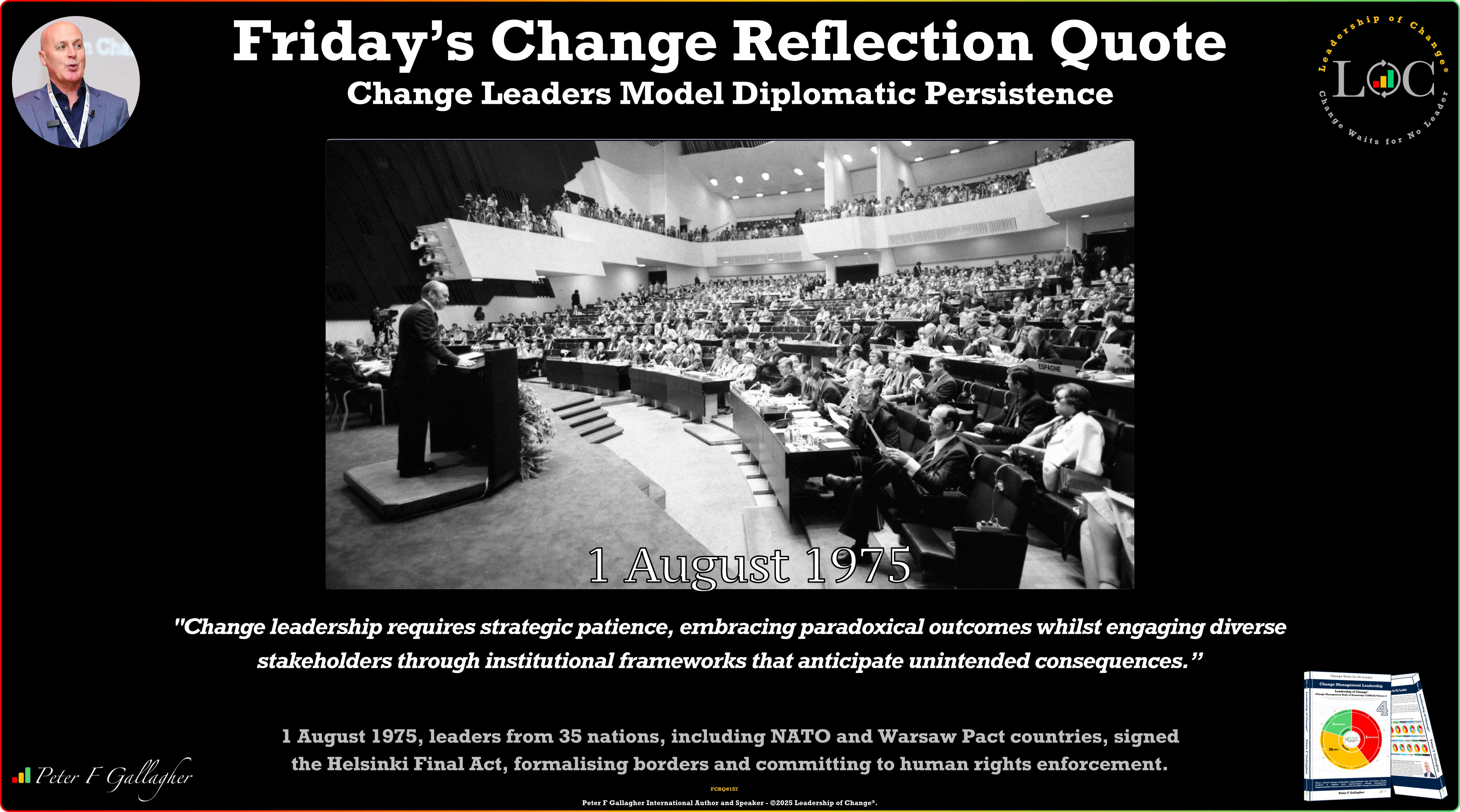 Friday’s Change Reflection Quote - Leadership of Change - Change Leaders Model Diplomatic Persistence
Friday’s Change Reflection Quote - Leadership of Change - Change Leaders Model Diplomatic Persistence
Leadership Learning!
On this day, 1 August 1975, leaders from 35 nations, including NATO and Warsaw Pact countries, signed the Helsinki Final Act, formalising borders and committing to human rights enforcement. The event took place in Helsinki, Finland, at the conclusion of the Conference on Security and Cooperation in Europe (CSCE). While the Act was not legally binding, it carried significant political weight and laid the foundation for a new form of engagement between adversaries. The Final Act addressed three major areas: security in Europe, cooperation in economics and science, and human rights and fundamental freedoms. One of the most notable outcomes was the mutual acceptance of post-World War II European borders, easing long-standing territorial disputes. The inclusion of human rights, freedom of thought, religion, and movement in the agreement served as a critical platform for later reformist and dissident movements in Eastern Europe. These provisions became tools for internal opposition, notably influencing Charter 77 in Czechoslovakia and Solidarność in Poland, demonstrating how agreements lacking legal enforceability could foster long-term change through civil society movements. They helped establish a standard of accountability on human rights that authoritarian regimes struggled to suppress without international scrutiny. Over time, the Helsinki process evolved into the Organisation for Security and Cooperation in Europe (OSCE), formalised in 1995, which continues to promote dialogue, conflict prevention, and democratic governance throughout the continent. This moment in history reveals the complexities of change through multilateral diplomacy. This illustrates how commitments can sometimes become constraints for those who impose them. Although Soviet leaders expected the security elements to reinforce their power, they underestimated the catalytic potential of the human rights provisions. In contrast, many Western nations embraced the broader, long-term strategy of shaping internal reform through international pressure and persistent engagement. From a leadership perspective, the signing of the Helsinki Final Act exemplifies how change can be initiated even within adversarial and seemingly intractable challenges. It shows that progress is not always driven by force or unilateral action but can emerge through dialogue, negotiation, and shared norms. Leaders at Helsinki did not resolve the ideological divide between East and West, but they did begin a new chapter of influence by introducing principles that could be used to hold systems accountable. This agreement illustrates the enduring value of creating frameworks that outlive political expedience. Although not every participant upheld the commitments made in Helsinki, the legacy of the Final Act is found in the seeds it planted for democratic reform and the peaceful redefinition of European political identity.
Change Leadership Lessons: The diplomatic achievements at Helsinki reveal fundamental principles about effective change leadership in complex, multi-stakeholder environments. Leaders of change must demonstrate strategic patience during complex negotiations, maintaining sustained commitment over extended timeframes to achieve meaningful transformation. They must recognise that agreements designed to maintain stability can inadvertently create powerful catalysts for organisational change throughout their institutions. Change leaders require multi-stakeholder engagement across ideological divides, bringing together diverse perspectives and competing interests to find workable solutions addressing core concerns. They should create permanent institutional frameworks and review mechanisms ensuring that change initiatives continue evolving rather than becoming static agreements. Leaders of change must anticipate that concessions made during negotiations may produce unexpected results,fundamentally altering the original strategic landscape. Change Leaders Model Diplomatic Persistence.
“Change leadership requires strategic patience, embracing paradoxical outcomes whilst engaging diverse stakeholders through institutional frameworks that anticipate unintended consequences.”
Application – Change Leadership Responsibility 1 - Articulate a Change Vision: The Helsinki Final Act demonstrates that articulating a compelling change vision requires diplomatic nuance and an ability to balance short-term concessions with long-term reform. Leaders developed a vision that transcended Cold War rivalries by focusing on shared goals such as peace, cooperation, and respect for human dignity. While the agreement stabilised territorial concerns, it simultaneously embedded human rights principles that would spark future democratic change. Effective change leaders must build visions that address immediate stakeholder concerns while embedding long-term transformation through structured commitments. This requires a leadership approach that unites seemingly opposing interests without compromising the integrity of the change initiative. By framing the vision around mutual security and cooperation, leaders at Helsinki enabled progressive momentum to build within constrained environments. Articulating such a vision means clearly communicating both the practical outcomes and the transformative intent, so that all stakeholders understand its implications and remain engaged throughout the change journey.
Final Thoughts: The Helsinki experience demonstrates how dialogue can plant the seeds of reform even in resistant systems. Lasting change emerges when leaders remain committed to inclusive vision and principled persistence.
Peter F. Gallagher consults, speaks, and writes on Leadership of Change®. He works exclusively with boards, CEOs, and senior leadership teams to prepare and align them to effectively and proactively lead their organisations through change and transformation.
Further Reading: Change Management Leadership - Leadership of Change® Volume 4.
Peter F. Gallagher consults, speaks, and writes on Leadership of Change®. He works exclusively with boards, CEOs, and senior leadership teams to prepare and align them to effectively and proactively lead their organisations through change and transformation.
For insights on navigating organisational change, feel free to reach out at Peter.gallagher@a2B.consulting.
For further reading please visit our websites: https://www.a2b.consulting https://www.peterfgallagher.com Amazon.com: Peter F Gallagher: Books, Biography, Blog, Audiobooks, Kindle
Leadership of Change® Body of Knowledge Volumes: Change Management Body of Knowledge (CMBoK) Books: Volumes 1, 2, 3, 4, 5, 6, 7, 8, 9, 10, A, B, C, D & E available on both Amazon and Google Play:
~ Leadership of Change® Volume 1 - Change Management Fables
~ Leadership of Change® Volume 2 - Change Management Pocket Guide
~ Leadership of Change® Volume 3 - Change Management Handbook
~ Leadership of Change® Volume 4 - Change Management Leadership
~ Leadership of Change® Volume 5 - Change Management Adoption
~ Leadership of Change® Volume 6 - Change Management Behaviour
~ Leadership of Change® Volume 7 - Change Management Sponsorship
~ Leadership of Change® Volume 8 - Change Management Charade
~ Leadership of Change® Volume 9 - Change Management Insanity
~ Leadership of Change® Volume 10 - Change Management Dilenttante
~ Leadership of Change® Volume A - Change Management Gamification - Leadership
~ Leadership of Change® Volume B - Change Management Gamification - Adoption
Tags: Leadership, Change Management, Business Strategy
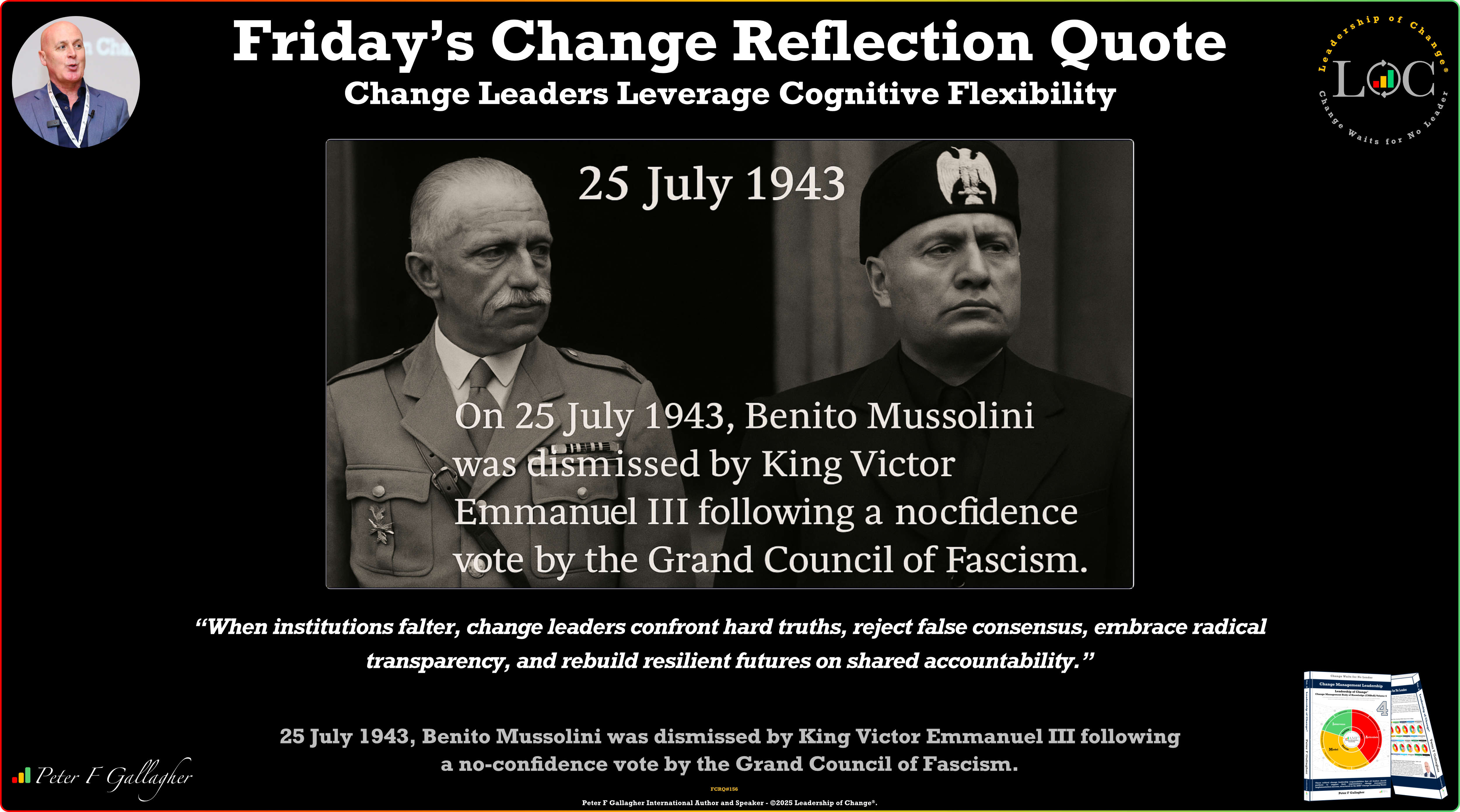 Friday’s Change Reflection Quote - Leadership of Change - Change Leaders Leverage Cognitive Flexibility
Friday’s Change Reflection Quote - Leadership of Change - Change Leaders Leverage Cognitive Flexibility
Leadership Learning!
On this day, 25 July 1943, Benito Mussolini was dismissed by King Victor Emmanuel III following a no-confidence vote by the Grand Council of Fascism. This marked a dramatic fall from power for a leader who had ruled Italy for over two decades, initially as prime minister from 1922 and then as dictator under the title “Il Duce.” The decision to remove him came at a moment of crisis. Following the Allied invasion of Sicily on 9 July 1943, Italy’s military failures and internal instability reached a critical point. The country had suffered heavy losses in North Africa, morale was low, and civilian infrastructure was in disarray. The Axis alliance with Nazi Germany had become increasingly unpopular among both the political elite and the Italian people. For years, Mussolini had presented himself as the embodiment of national destiny, relying on propaganda, authoritarian control, and a tightly centralised decision-making structure. He surrounded himself with loyalists and discouraged dissent, silencing critics within government, the military, and the press. This created an echo chamber of obedience, where the absence of challenge led to flawed decisions—an enduring risk for any leader who surrounds themselves with followers unwilling or afraid to speak truth to power. Despite worsening conditions, he continued to project an image of control and inevitable victory. He refused to adapt policy, replace failing military leadership, or acknowledge Italy’s deteriorating position. Internally, trust in his leadership eroded as ministers and senior officers witnessed repeated strategic failures and Mussolini’s unwillingness to listen to advice or share decision-making authority. The Grand Council of Fascism—once compliant—voted against him in a rare act of collective defiance. Although the vote was not legally binding, King Victor Emmanuel seized the opportunity to act. When Mussolini met with the king the following day, expecting a routine discussion, he was instead informed of his dismissal and immediately arrested. Marshal Pietro Badoglio was appointed as the new prime minister and quickly began secret negotiations with the Allies. Mussolini’s fall was not sudden—it was the delayed consequence of years of centralised control, poor judgement, and strategic rigidity in the face of national crisis. Less than two years later, in April 1945, Mussolini was captured and executed by Italian partisans while attempting to flee the country.
Change Leadership Lessons: The downfall of this long-serving leader offers more than a cautionary tale—it provides a powerful reminder of what happens when leadership rejects uncomfortable truths, suppresses dissent, and loses the trust of those within its ranks. These leadership failures, left unchecked, create pressure that builds beneath the surface until collapse becomes inevitable. For today’s change leaders, this moment in history reinforces the necessity of timely transformation, honest reflection, and cognitive flexibility under pressure. Effective change leaders recognise that sustained success requires internal evolution before crisis makes it unavoidable. Leaders of change who eliminate dissent and avoid challenge from their teams risk becoming disconnected from operational and organisational reality. They neglect internal and external stakeholders at their peril, accelerating decline through lost confidence and weakening leadership authority. Change leaders who depend solely on outdated control structures without meaningful reform expose their organisations to instability under pressure. They compromise long-term influence when they suppress open dialogue and delay the actions necessary to rebuild trust. Leaders of change who resist internal evolution create hidden pressure that eventually erupts, forcing unmanaged and often disruptive transformation. Change Leaders Leverage Cognitive Flexibility.
“Change collapses when leadership rejects truth, silences dissent, ignores trust, and delays the inevitable transformation that pressure demands.”
Application: Change Leadership Responsibility 3 - Intervene to Ensure Sustainable Change: Mussolini’s downfall exemplifies the peril of leaders who ignore the need for intervention amid clear signs that change is essential. Rather than addressing internal concerns, implementing reform, or shifting failing strategies, he doubled down on outdated practices. Effective change leaders must act decisively when internal dissent and external indicators point to systemic failure. They must create structured interventions to correct course—whether through honest dialogue, organisational reform, or structural realignment. Intervention necessitates courage rather than control; it requires acknowledging that true sustainability hinges on evolution, not inertia. Leaders who fail to intervene eventually lose not only their authority but also the institutional foundations that sustain them. Proactive intervention is not about reacting to crisis—it is about anticipating resistance, engaging with reality, and removing barriers to change before they destabilise the organisation. Change leaders must stay vigilant, particularly when systems seem stable, and be prepared to disrupt the status quo for long-term resilience. Intervening early prevents minor issues from becoming existential failures.
Final Thoughts: Mussolini’s downfall serves as a cautionary tale about the dangers of ignoring internal dissent and postponing necessary reform. Change leaders must actively listen, adapt, and drive transformation proactively, rather than allowing circumstances to dictate their actions.
Peter F. Gallagher consults, speaks, and writes on Leadership of Change®. He works exclusively with boards, CEOs, and senior leadership teams to prepare and align them to effectively and proactively lead their organisations through change and transformation.
For insights on navigating organisational change, feel free to reach out at Peter.gallagher@a2B.consulting.
For further reading please visit our websites: https://www.a2b.consulting https://www.peterfgallagher.com Amazon.com: Peter F Gallagher: Books, Biography, Blog, Audiobooks, Kindle
Leadership of Change® Body of Knowledge Volumes: Change Management Body of Knowledge (CMBoK) Books: Volumes 1, 2, 3, 4, 5, 6, 7, 8, 9, 10, A, B, C, D & E available on both Amazon and Google Play:
~ Leadership of Change® Volume 1 - Change Management Fables
~ Leadership of Change® Volume 2 - Change Management Pocket Guide
~ Leadership of Change® Volume 3 - Change Management Handbook
~ Leadership of Change® Volume 4 - Change Management Leadership
~ Leadership of Change® Volume 5 - Change Management Adoption
~ Leadership of Change® Volume 6 - Change Management Behaviour
~ Leadership of Change® Volume 7 - Change Management Sponsorship
~ Leadership of Change® Volume 8 - Change Management Charade
~ Leadership of Change® Volume 9 - Change Management Insanity
~ Leadership of Change® Volume 10 - Change Management Dilenttante
~ Leadership of Change® Volume A - Change Management Gamification - Leadership
~ Leadership of Change® Volume B - Change Management Gamification - Adoption
Tags: Leadership, Change Management, Business Strategy
 Friday’s Change Reflection Quote - Leadership of Change - Change Leaders Courageously Acknowledge Failure
Friday’s Change Reflection Quote - Leadership of Change - Change Leaders Courageously Acknowledge Failure
Leadership Learning!
On this day, 18 July 2013, the city of Detroit initiated Chapter 9 bankruptcy proceedings under Kevyn Orr, the emergency manager appointed by Michigan Governor Rick Snyder. This marked the largest municipal bankruptcy in U.S. history, involving approximately $18.5 billion in debt and liabilities. The filing reflected decades of economic decline, depopulation, and financial mismanagement, making Detroit’s collapse one of the most profound in American urban history. The city's eligibility was initially contested but ultimately upheld in December 2013, allowing it to restructure debts under federal bankruptcy law while continuing to provide essential services. Notably, the crisis stemmed from a prolonged collapse in revenues—not spiralling pension liabilities, as often misrepresented. With Detroit’s population falling from 1.8 million in 1950 to just 700,000 by 2013, its tax base could no longer sustain services scaled for a much larger city. While the bankruptcy shocked municipal bond markets and raised concerns nationwide, it also became a catalyst for institutional reinvention. Painful negotiations led to the restructuring of pension obligations, and outdated operational models were replaced by technology-driven efficiencies. Emergency management structures—though controversial—broke through entrenched dysfunction and delivered decisive leadership in a time of crisis. The appointment of Kevyn Orr marked a shift from traditional democratic governance to crisis leadership, sparking debate about representation and accountability during institutional collapse. Yet, it forced Detroit’s stakeholders—unions, bondholders, pensioners, and residents—into a new era of collaboration. Emerging from bankruptcy in just eighteen months, Detroit shed about $7 billion of debt, regained fiscal stability, and introduced stronger governance systems to prevent future crises. Its story remains a stark reminder that no organisation, regardless of scale or history, is immune to collapse when core problems are ignored. And yet, when leaders have the courage to confront failure, even the most troubled institutions can become blueprints for radical renewal.
Change Leadership Lessons: Detroit’s collapse revealed the dangers of avoiding uncomfortable truths—yet its recovery proved what is possible when change leadership is both honest and bold. Detroit’s journey from bankruptcy to recovery illustrates how leaders can use crisis to create opportunities for transformation that would have been impossible under normal circumstances. This pivotal moment in urban governance reminds us that effective change management requires the courage to acknowledge failure, the wisdom to learn from it, and the determination to build something better from the ashes of what came before. Leaders of change must sometimes abandon consensus-building approaches in favour of rapid, decisive action when institutional survival is threatened. They benefit from external perspectives that can break through organisational inertia and implement changes internal actors cannot achieve. Change leaders insist on complete transparency with stakeholders, even when the message is uncomfortable or politically contentious. They replace incremental negotiation with decisive frameworks that prioritise institutional survival over individual preferences during existential threat. Leaders of change protect fundamental operations whilst eliminating non-essential activities through difficult but necessary prioritisation decisions during resource constraints. Change Leaders Courageously Acknowledge Failure.
“When institutions falter, change leaders confront hard truths, reject false consensus, embrace radical transparency, and rebuild resilient futures on shared accountability.”
Application – Change Leadership Responsibility 1 - Articulate a Change Vision: The Detroit bankruptcy shows that effective change leaders must articulate a vision that acknowledges institutional failure while inspiring confidence in renewal. Kevyn Orr’s appointment, though contested, brought urgent clarity and focused direction during an unprecedented institutional crisis. A compelling vision in times of crisis must confront uncomfortable truths, unify stakeholders, and define a path toward realistic transformation. Detroit’s renewal went beyond balance sheets—it involved reimagined governance, restored trust, and renegotiated stakeholder relationships. Change leaders must communicate a vision that instils accountability, outlines measurable steps, and secures shared commitment from those affected. Articulating a vision during crisis demands courage, clarity, and a relentless focus on long-term stability—not just immediate rescue. Detroit teaches us that successful change leadership begins by confronting reality and uniting stakeholders around an achievable future.
Final Thoughts: Detroit’s crisis reminds us that silence and inaction can erode institutions faster than external threats. Courageous change leaders confront failure, define vision, and lead the charge toward transformation.
Have a fantastic weekend with the ones you love and care for, enjoy some fresh air, exercise, eat, drink, and be happy.
Peter F. Gallagher consults, speaks, and writes on Leadership of Change®. He works exclusively with boards, CEOs, and senior leadership teams to prepare and align them to effectively and proactively lead their organisations through change and transformation.
For insights on navigating organisational change, feel free to reach out at Peter.gallagher@a2B.consulting.
For further reading please visit our websites: https://www.a2b.consulting https://www.peterfgallagher.com Amazon.com: Peter F Gallagher: Books, Biography, Blog, Audiobooks, Kindle
Leadership of Change® Body of Knowledge Volumes: Change Management Body of Knowledge (CMBoK) Books: Volumes 1, 2, 3, 4, 5, 6, 7, 8, 9, 10, A, B, C, D & E available on both Amazon and Google Play:
~ Leadership of Change® Volume 1 - Change Management Fables
~ Leadership of Change® Volume 2 - Change Management Pocket Guide
~ Leadership of Change® Volume 3 - Change Management Handbook
~ Leadership of Change® Volume 4 - Change Management Leadership
~ Leadership of Change® Volume 5 - Change Management Adoption
~ Leadership of Change® Volume 6 - Change Management Behaviour
~ Leadership of Change® Volume 7 - Change Management Sponsorship
~ Leadership of Change® Volume 8 - Change Management Charade
~ Leadership of Change® Volume 9 - Change Management Insanity
~ Leadership of Change® Volume 10 - Change Management Dilenttante
~ Leadership of Change® Volume A - Change Management Gamification - Leadership
~ Leadership of Change® Volume B - Change Management Gamification - Adoption
Tags: Business Strategy, Change Management, Leadership
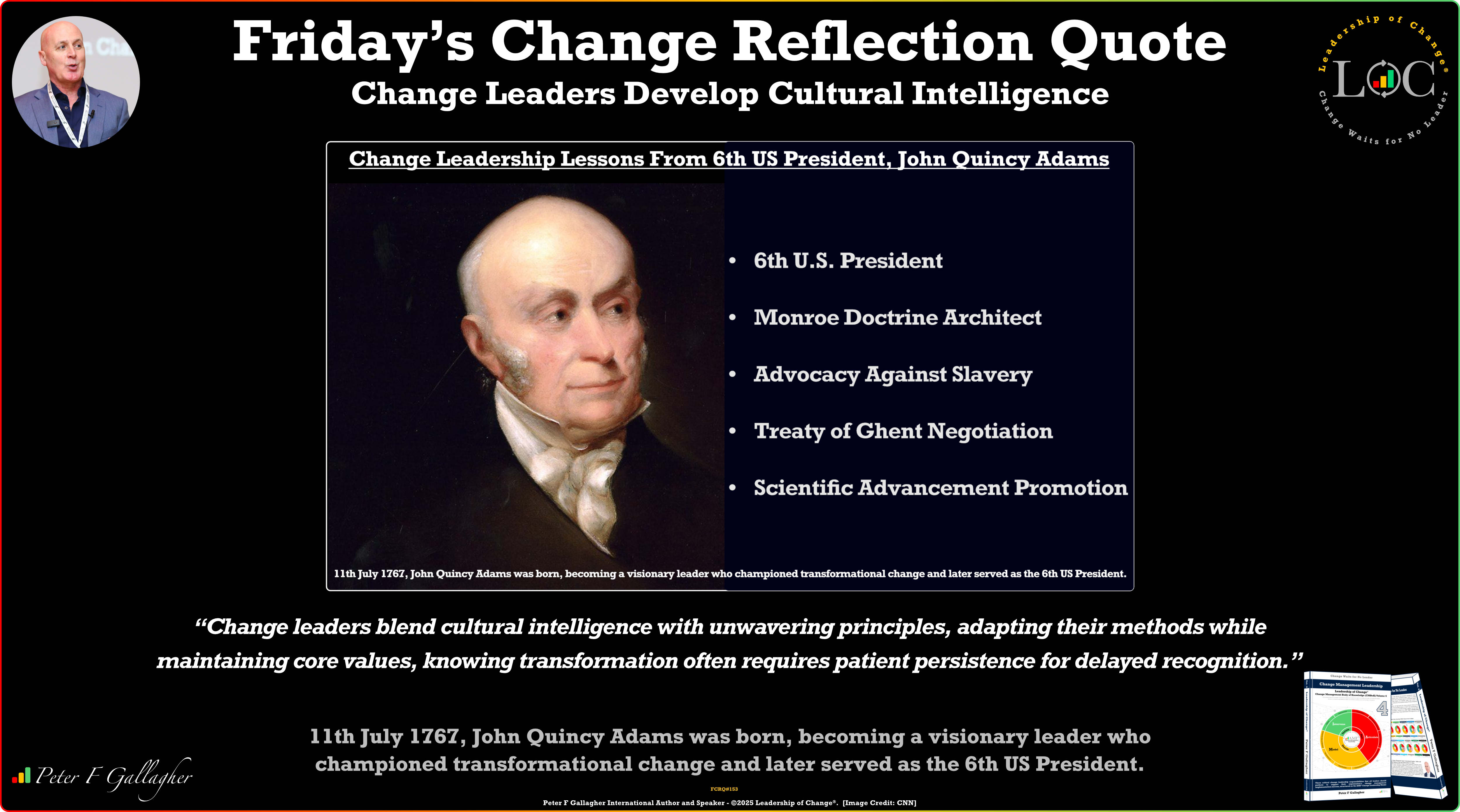 Friday’s Change Reflection Quote - Leadership of Change - Change Leaders Develop Cultural Intelligence
Friday’s Change Reflection Quote - Leadership of Change - Change Leaders Develop Cultural Intelligence
Leadership Learning!
On this day, 11th July 1767, John Quincy Adams was born, becoming a visionary leader who championed transformational change and later served as the 6th US President. Born in Braintree, now Quincy, Massachusetts, John Quincy Adams entered the world during a transformative period in history. Growing up during the American Revolution, he watched the Battle of Bunker Hill from Penn's Hill and heard the cannons roar across Boston's Back Bay. As the son of John Adams, the second President of the United States, and Abigail Smith Adams, young John Quincy was destined to witness and shape the formation of American democracy. His formative years were marked by extraordinary international exposure, which later proved invaluable in his diplomatic career. Between 1778 and 1780, he accompanied his father to Europe, studying in Paris and at the University of Leiden, where he gained fluency in French and Dutch, developing a rare global perspective for his generation. At the remarkably young age of 14, Adams demonstrated exceptional maturity when he accompanied Francis Dana, United States envoy to Russia, as his private secretary and interpreter of French. His time in St. Petersburg and role in the Peace of Paris marked him as a skilled diplomat before adulthood. After graduating from Harvard College in 1787, Adams pursued law, yet his true calling lay in public service and diplomacy. Appointed by President Washington as minister to the Netherlands in 1794, Adams used The Hague to report critical intelligence during the War of the First Coalition. He was also instrumental in negotiating the Treaty of Ghent (1814), which ended the War of 1812 and restored peaceful relations between the United States and Britain. As Secretary of State under President James Monroe, Adams achieved several significant diplomatic victories. He helped secure Oregon with England, gained Florida from Spain, and shaped the Monroe Doctrine to deter European colonisation. The presidential election of 1824 marked one of the most contentious periods in American political history. Adams won a bitter election over Andrew Jackson, though the election was ultimately decided by the House of Representatives when no candidate secured a majority in the Electoral College. This controversial victory would overshadow much of his presidency. As President, Adams proved to be a visionary leader whose ideas were often ahead of their time. He advocated for internal improvements, such as a national road and a network of canals. His agenda proposed a national university, observatory, and infrastructure projects to transform American society. However, Adams's presidency was marked by significant political opposition and personal challenges. His vision of strong federal leadership clashed with prevailing political sentiment. The political climate was further complicated by accusations of a "corrupt bargain" with Henry Clay, which damaged his credibility and effectiveness as a leader. Following his presidency, Adams embarked on perhaps his most transformative chapter as a member of the House of Representatives from 1831 to 1848. During this period, he became known as "Old Man Eloquent" for his passionate advocacy against slavery expansion. His post-presidency showed resilience and a tireless commitment to national progress. His life story reveals how true visionaries must often endure periods of misunderstanding and opposition before their contributions are fully recognised and appreciated.
Change Leadership Lessons: The legacy of John Quincy Adams offers profound insights into the nature of transformational leadership. His ability to maintain principled positions despite political adversity, his commitment to long-term national interests over short-term political gain, and his willingness to champion unpopular causes demonstrate the characteristics of authentic change leadership. Leaders of change must develop cultural intelligence and international exposure to navigate complex negotiations and build lasting diplomatic relationships across diverse cultures. They understand that even brilliant transformational ideas fail when they exceed stakeholders' capacity for accepting change within their organisations. Change leaders demonstrate how principled advocacy requires personal resilience, enduring isolation whilst maintaining their core values throughout challenging periods. They illustrate how effective leaders reinvent their approaches whilst preserving fundamental principles, extending their impact beyond initial roles and responsibilities. Leaders of change often achieve delayed recognition, as their forward-thinking vision contributes to societal transformation that validates their groundwork decades later. Change Leaders Develop Cultural Intelligence.
“Change leaders blend cultural intelligence with unwavering principles, adapting their methods while maintaining core values, knowing transformation often requires patient persistence for delayed recognition.”
Application – Change Leadership Responsibility 1 - Articulate a Change Vision: Adams’s presidency illustrates how leaders with bold, long-term visions must navigate the realities of institutional resistance. His efforts to articulate a national vision for scientific advancement, infrastructure, and education highlight the challenge of aligning visionary ideals with prevailing political realities. Despite opposition, Adams’s unwavering consistency in advocating for progress exemplified how leaders must continuously communicate, defend, and embody their vision. His post-presidency work in Congress reinforced this idea, demonstrating that a change vision must persist beyond tenure and be sustained through personal conviction and public engagement. A compelling change vision demands ongoing communication that reinforces a leader’s long-term commitment to progress. This vision must be consistently embodied through visible leadership behaviours that reflect integrity and principle. By doing so, leaders like John Quincy Adams foster trust, enable alignment, and empower others to take confident steps toward a shared and transformative national or organisational interest.
Final Thoughts: Adams’s leadership reminds us that true vision often encounters resistance long before it gains recognition. Modern leaders must learn to endure, adapt, and stay committed to principled transformation during uncertain times.
Have a fantastic weekend with the ones you love and care for, enjoy some fresh air, exercise, eat, drink, and be happy.
Peter F. Gallagher consults, speaks, and writes on Leadership of Change®. He works exclusively with boards, CEOs, and senior leadership teams to prepare and align them to effectively and proactively lead their organisations through change and transformation.
For insights on navigating organisational change, feel free to reach out at Peter.gallagher@a2B.consulting.
For further reading please visit our websites: https://www.a2b.consulting https://www.peterfgallagher.com Amazon.com: Peter F Gallagher: Books, Biography, Blog, Audiobooks, Kindle
Leadership of Change® Body of Knowledge Volumes: Change Management Body of Knowledge (CMBoK) Books: Volumes 1, 2, 3, 4, 5, 6, 7, 8, 9, 10, A, B, C, D & E available on both Amazon and Google Play:
~ Leadership of Change® Volume 1 - Change Management Fables
~ Leadership of Change® Volume 2 - Change Management Pocket Guide
~ Leadership of Change® Volume 3 - Change Management Handbook
~ Leadership of Change® Volume 4 - Change Management Leadership
~ Leadership of Change® Volume 5 - Change Management Adoption
~ Leadership of Change® Volume 6 - Change Management Behaviour
~ Leadership of Change® Volume 7 - Change Management Sponsorship
~ Leadership of Change® Volume 8 - Change Management Charade
~ Leadership of Change® Volume 9 - Change Management Insanity
~ Leadership of Change® Volume 10 - Change Management Dilenttante
~ Leadership of Change® Volume A - Change Management Gamification - Leadership
~ Leadership of Change® Volume B - Change Management Gamification - Adoption
Tags: Business Strategy, Change Management, Leadership
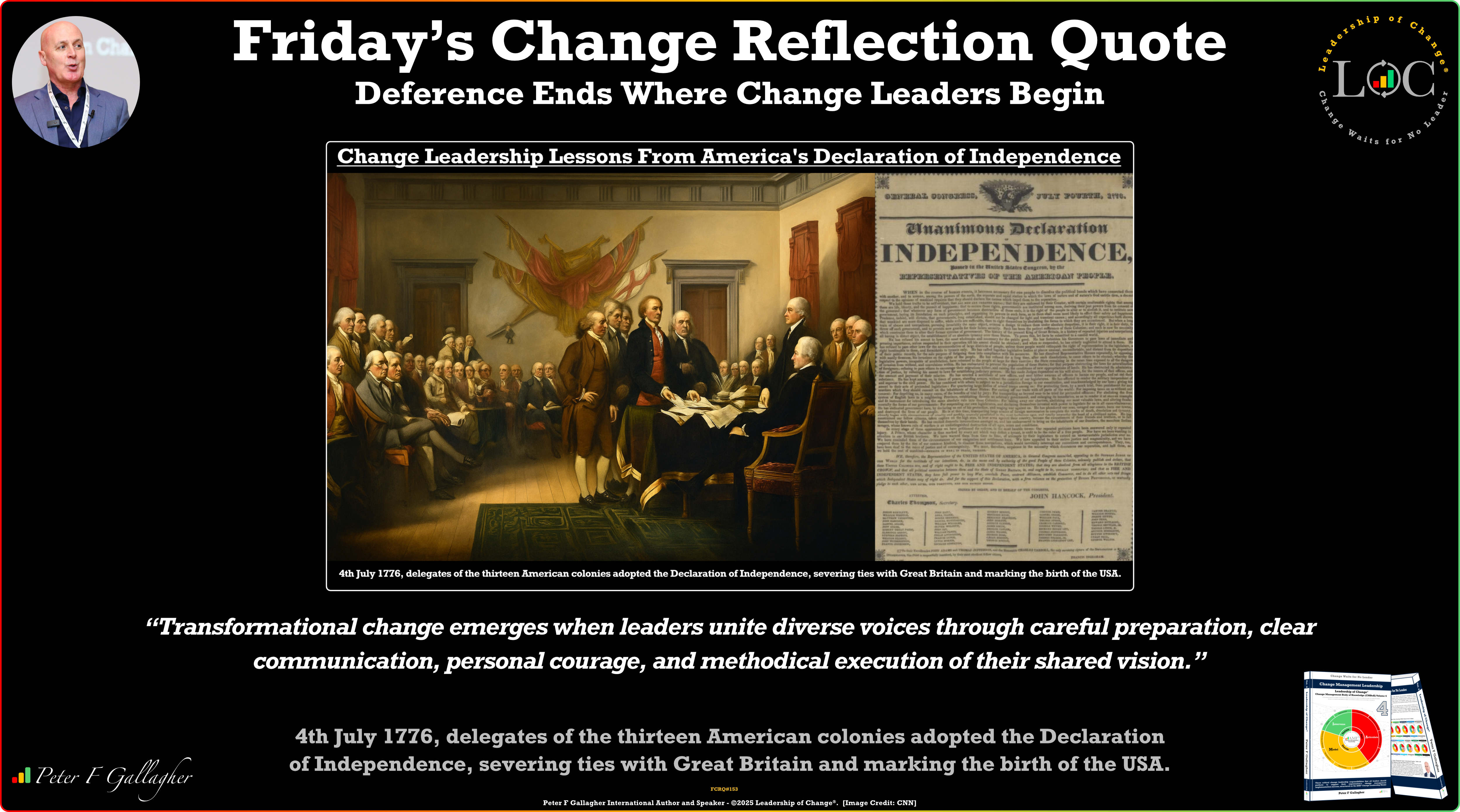 Friday’s Change Reflection Quote - Leadership of Change - Deference Ends Where Change Leaders Begin
Friday’s Change Reflection Quote - Leadership of Change - Deference Ends Where Change Leaders Begin
Leadership Learning!
On this day, 4th July 1776, delegates of the thirteen American colonies adopted the Declaration of Independence, formally severing ties with Great Britain and marking the birth of the United States of America. Among those leading this historic transformation were Thomas Jefferson, the Declaration’s principal author, and John Adams, its most determined advocate, alongside Benjamin Franklin, Roger Sherman, and Robert R. Livingston, who together formed the drafting committee. This pivotal moment in world history exemplifies organised resistance to established authority and the collective will to forge a new path forward. The Declaration was a revolutionary manifesto that challenged the foundations of governance and human rights of the 18th century. This document articulated principles that influenced democratic movements worldwide, introducing the radical idea that legitimate power must be grounded in the will of the people. The clarity and conviction of its prose, especially for the time, reflect the power of well-crafted language to articulate enduring ideals. Jefferson’s eloquence and philosophical vision gave the Declaration its enduring rhetorical force, while Adams fought fiercely to secure its adoption. The Declaration proclaimed that all men are created equal and possess unalienable rights to life, liberty, and the pursuit of happiness—concepts that would echo through centuries of social and political transformation. The courage required to affix one's signature to this document cannot be understated; these delegates were signing their own death warrants if the revolution failed. Benjamin Franklin famously quipped at the signing, “We must all hang together, or most assuredly we shall all hang separately.” The Declaration itself proclaimed, “That to secure these rights, Governments are instituted among Men, deriving their just powers from the consent of the governed.” Just six months earlier, Thomas Paine’s pamphlet Common Sense had galvanised colonial sentiment, proving how persuasive language could ignite public appetite for change. This moment of profound risk-taking illustrates how transformational change requires leaders to stake everything on their vision of a better future. The ripple effects of this declaration established precedents for self-determination that inspired liberation movements globally. The Declaration's emphasis on natural rights and popular sovereignty challenged the established order throughout Europe and beyond, becoming a catalyst for democratic ideals. The process leading to this moment also highlights the complexity of achieving consensus among diverse stakeholders. The thirteen colonies had significant differences in culture, economy, and political structure. Yet through months of debate and negotiation, these disparate entities found common ground in their shared desire for self-governance and freedom from perceived oppressive rule. Thismoment marked a fundamental shift in thinking about authority and legitimacy, transforming the relationship between rulers and the ruled, while introducing a new framework for understanding political power. 4th July is now observed across the United States as Independence Day, a national celebration of liberty, identity, and democratic beginnings.
Change Leadership Lessons: The Declaration of Independence reminds us that transformational change demands both visionary thinking and the courage to act decisively when the moment for change arrives. Modern leaders can draw inspiration from these delegates who risked everything to create a new paradigm, demonstrating that lasting change requires both collective commitment and individual accountability. Leaders of change understand that successful transformation requires strategic preparation and groundwork before any decisive action is taken. They understand that achieving lasting change demands bringing together diverse stakeholders with different interests to reach agreement. Change leaders develop immediate and systematic communication plans to ensure all constituencies understand the transformation rationale and purpose. They must be willing to accept significant personal risks when pursuing organisational or societal change initiatives that matter. Leaders of change require structured approaches that balance bold decision-making with practical steps for executing their transformation vision. Deference Ends Where Change Leaders Begin.
“Transformational change emerges when leaders unite diverse voices through careful preparation, clear communication, personal courage, and methodical execution of their shared vision.”
Application – Change Leadership Responsibility 1 - Articulate a Change Vision: The adoption of the Declaration of Independence exemplifies the critical role of a clearly articulated change vision in large-scale transformation. The delegates’ vision transcended mere political separation; it outlined a revolutionary narrative that sought to establish a new governance framework based on the principles of liberty and equality. By presenting this vision with clarity and conviction, the delegates garnered support from diverse factions within the colonies. Their commitment to the ideals of self-governance and human rights demonstrated not only clarity of purpose but also the courage to act decisively in the face of potential consequences. Effective change leaders, much like these delegates, craft aspirational yet credible visions that guide diverse stakeholders through uncertainty while reinforcing a shared sense of direction. A compelling change vision requires continuous communication and consistent embodiment of core principles through visible leadership behaviours, fostering trust, enabling alignment, and empowering individuals to take confident steps toward a common goal.
Final Thoughts: The Declaration of Independence reminds us that transformational change demands both visionary thinking and the courage to act decisively when the moment for change arrives. Modern leaders can draw inspiration from those who risked everything to redefine the future, proving change demands commitment and personal accountability.
Further Reading: Change Management Leadership - Leadership of Change® Volume 4.
Peter F. Gallagher consults, speaks, and writes on Leadership of Change®. He works exclusively with boards, CEOs, and senior leadership teams to prepare and align them to effectively and proactively lead their organisations through change and transformation.
For insights on navigating organisational change, feel free to reach out at Peter.gallagher@a2B.consulting.
#LeadershipofChange #Leadership #ChangeLeadership #GlobalGurus #ChangeManagement #ChangeVision #AmericanIndependence #BenjaminFranklin #ThomasJefferson #JohnAdam
Further Reading: Change Management Leadership - Leadership of Change® Volume 4
Have a fantastic weekend with the ones you love and care for, enjoy some fresh air, exercise, eat, drink, and be happy.
Peter F. Gallagher consults, speaks, and writes on Leadership of Change®. He works exclusively with boards, CEOs, and senior leadership teams to prepare and align them to effectively and proactively lead their organisations through change and transformation.
For insights on navigating organisational change, feel free to reach out at Peter.gallagher@a2B.consulting.
For further reading please visit our websites: https://www.a2b.consulting https://www.peterfgallagher.com Amazon.com: Peter F Gallagher: Books, Biography, Blog, Audiobooks, Kindle
Leadership of Change® Body of Knowledge Volumes: Change Management Body of Knowledge (CMBoK) Books: Volumes 1, 2, 3, 4, 5, 6, 7, 8, 9, 10, A, B, C, D & E available on both Amazon and Google Play:
~ Leadership of Change® Volume 1 - Change Management Fables
~ Leadership of Change® Volume 2 - Change Management Pocket Guide
~ Leadership of Change® Volume 3 - Change Management Handbook
~ Leadership of Change® Volume 4 - Change Management Leadership
~ Leadership of Change® Volume 5 - Change Management Adoption
~ Leadership of Change® Volume 6 - Change Management Behaviour
~ Leadership of Change® Volume 7 - Change Management Sponsorship
~ Leadership of Change® Volume 8 - Change Management Charade
~ Leadership of Change® Volume 9 - Change Management Insanity
~ Leadership of Change® Volume 10 - Change Management Dilenttante
~ Leadership of Change® Volume A - Change Management Gamification - Leadership
~ Leadership of Change® Volume B - Change Management Gamification - Adoption
Tags: Business Strategy, Change Management, Leadership
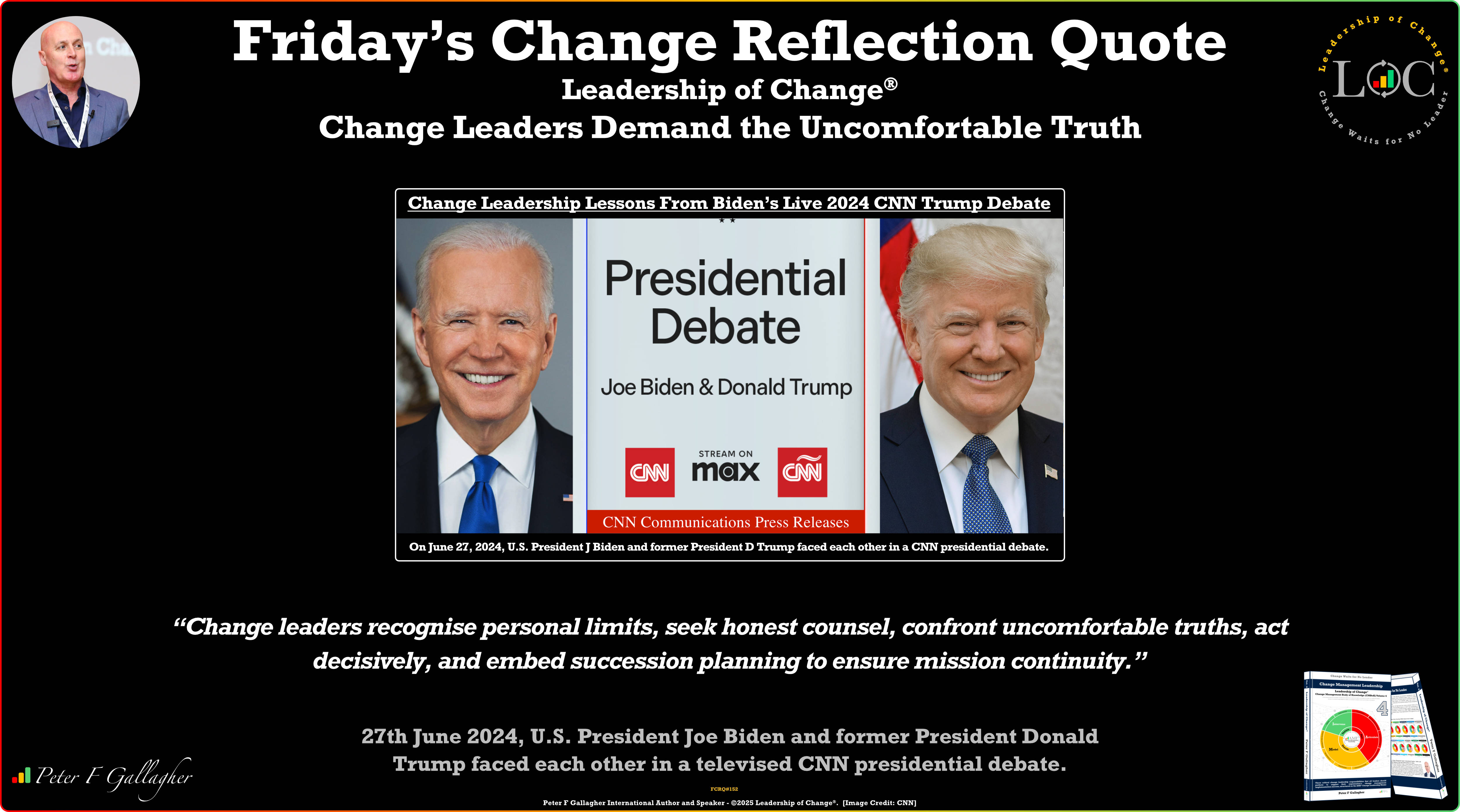 Friday’s Change Reflection Quote - Leadership of Change - Change Leaders Demand the Uncomfortable Truth
Friday’s Change Reflection Quote - Leadership of Change - Change Leaders Demand the Uncomfortable Truth
Leadership Learning!
On this Day, 27th June 2024, U.S. President Joe Biden and former President Donald Trump faced each other in a televised CNN presidential debate. This marked the first presidential debate of the 2024 United States general election campaign and was held unusually early—nearly four months before election day. Hosted at CNN’s studios in Atlanta, Georgia, the event was historic for multiple reasons. For the first time in U.S. history, a sitting president and a former president, debated head-to-head. It was also the earliest general election debate ever held, reflecting a highly polarised political climate and a deeply divided electorate. CNN introduced strict format rules, including muted microphones, the absence of a live audience, and firm time limits, to maintain control during a volatile campaign. As the debate unfolded, millions of Americans tuned in via television and online platforms, with international audiences also watching closely. According to CNN, over 51 million viewers watched the debate live across broadcast, cable, and streaming services, making it one of the most viewed political events of the year. President Biden, aged 81 at the time, was seeking re-election after serving one term in office. His record included economic recovery efforts post-COVID-19, renewed emphasis on NATO and international diplomacy, and efforts to stabilise democratic institutions following the upheaval of the 2020 election and its aftermath. However, questions about his age, cognitive sharpness, and overall stamina had become an undercurrent throughout the campaign. Those concerns came sharply into focus during this debate. Media reports noted his halting delivery, visible pauses, and difficulty rebutting statements made by Trump. Former President Donald Trump, aged 78, remained a polarising figure. Despite multiple legal indictments and ongoing criminal trials, he had maintained dominance within the Republican Party and secured the 2024 nomination. His approach to the debate was aggressive and assertive, often delivering rehearsed messages aimed at energising his core base. Trump capitalised on the contrast between himself and Biden, leveraging moments of uncertainty in Biden’s delivery to portray himself as a stronger, more capable leader. The aftermath of the debate generated immediate headlines. Prominent Democratic supporters, media commentators, and political analysts began to question whether President Biden should continue in the race. Within days, polling data began to reflect voter unease. According to Ipsos and YouGov surveys conducted shortly after the debate, confidence in Biden’s candidacy dropped significantly, especially among independent voters and younger demographics. The Democratic Party entered a phase of intense introspection, with growing discussions about a potential replacement candidate. Despite statements from the White House affirming President Biden’s intention to continue, internal pressure mounted steadily. President Biden’s voluntary withdrawal less than a month later marked a rare moment of introspection in high-stakes leadership. On 21st July 2024—less than one month after the debate, he formally announced he would not seek re-election. This decision marked a significant moment in modern U.S. political history. He became the first sitting president since Lyndon B. Johnson in 1968 to voluntarily withdraw from a re-election campaign. Biden’s announcement reshaped the entire trajectory of the 2024 election, triggering an urgent and unprecedented Democratic nomination process.
Change Leadership Lessons: The events of 27th June 2024 offer profound insights into the nature of leadership during moments of truth. Leadership is tested not only through decisions, but also by how capability is perceived under intense public scrutiny. The debate reinforced existing concerns, showing how swiftly public perception can shift—even for leaders with decades of service. Leaders of change understand that past success does not guarantee current confidence during pivotal, high-visibility, and high-stakes leadership moments. They understand the risks of becoming the last to recognise their own decline if surrounded by those unwilling to speak the truth. Change leaders demonstrate integrity by preparing thoroughly for critical moments that test both credibility and capability. They show responsibility by ensuring succession planning is transparent, future-focused, and aligned with stakeholder expectations. Leaders of change uphold integrity by stepping aside when necessary, putting the mission ahead of personal position or legacy. Change Leaders Demand the Uncomfortable Truth.
“Change leaders recognise personal limits, seek honest counsel, confront uncomfortable truths, act decisively, and embed succession planning to ensure mission continuity.”
Application - Change Leadership Responsibility 3 – Intervene to Ensure Sustainable Change: The Biden–Trump debate exemplifies how leadership responsibility includes knowing when to intervene to ensure sustainable change and continuity. Biden's situation demonstrates that sustainable change often demands difficult decisions about leadership transitions, particularly when external pressures and internal capabilities become misaligned. Effective change leaders ensure honest self-assessment and create conditions where trusted voices can speak hard truths without fear. The debate's aftermath revealed the dangers of insular decision-making and the importance of diverse perspectives in leadership evaluation. Change leaders must distinguish between personal ambition and organisational mission. Biden's eventual withdrawal, though painful, illustrated how sustainable change sometimes requires leaders to step aside for the greater good. The same principle applies in business—leaders must know when their presence supports progress, and when it obstructs it. The intervention responsibility extends beyond self-assessment to include succession planning and ensuring smooth transitions that preserve institutional knowledge whilst enabling fresh leadership perspectives to emerge
Final Thoughts: Many leadership failures arise not from lack of vision, but from a reluctance to respond to what the mirror reflects. The 27 June 2024 debate reminds us: leadership is a privilege with performance conditions. When capacity and challenge no longer align, the true leader responds—with clarity, transparency, and loyalty to the mission over self.
Credit and thank you: CNN.
Further Reading: Change Management Leadership - Leadership of Change® Volume 4.
Peter F. Gallagher consults, speaks, and writes on Leadership of Change®. He works exclusively with boards, CEOs, and senior leadership teams to prepare and align them to effectively and proactively lead their organisations through change and transformation.
For insights on navigating organisational change, feel free to reach out at Peter.gallagher@a2B.consulting.
Credit and Thank you: Greenpeace
#LeadershipofChange #Leadership #ChangeLeadership #GlobalGurus #ChangeManagement #Shell #EnvironmentalIntegrity #BrentSpar
Further Reading: Change Management Leadership - Leadership of Change® Volume 4
Have a fantastic weekend with the ones you love and care for, enjoy some fresh air, exercise, eat, drink, and be happy.
Peter F. Gallagher consults, speaks, and writes on Leadership of Change®. He works exclusively with boards, CEOs, and senior leadership teams to prepare and align them to effectively and proactively lead their organisations through change and transformation.
For insights on navigating organisational change, feel free to reach out at Peter.gallagher@a2B.consulting.
For further reading please visit our websites: https://www.a2b.consulting https://www.peterfgallagher.com Amazon.com: Peter F Gallagher: Books, Biography, Blog, Audiobooks, Kindle
Leadership of Change® Body of Knowledge Volumes: Change Management Body of Knowledge (CMBoK) Books: Volumes 1, 2, 3, 4, 5, 6, 7, 8, 9, 10, A, B, C, D & E available on both Amazon and Google Play:
~ Leadership of Change® Volume 1 - Change Management Fables
~ Leadership of Change® Volume 2 - Change Management Pocket Guide
~ Leadership of Change® Volume 3 - Change Management Handbook
~ Leadership of Change® Volume 4 - Change Management Leadership
~ Leadership of Change® Volume 5 - Change Management Adoption
~ Leadership of Change® Volume 6 - Change Management Behaviour
~ Leadership of Change® Volume 7 - Change Management Sponsorship
~ Leadership of Change® Volume 8 - Change Management Charade
~ Leadership of Change® Volume 9 - Change Management Insanity
~ Leadership of Change® Volume 10 - Change Management Dilenttante
~ Leadership of Change® Volume A - Change Management Gamification - Leadership
~ Leadership of Change® Volume B - Change Management Gamification - Adoption
Tags: Leadership, Change Management, Business Strategy
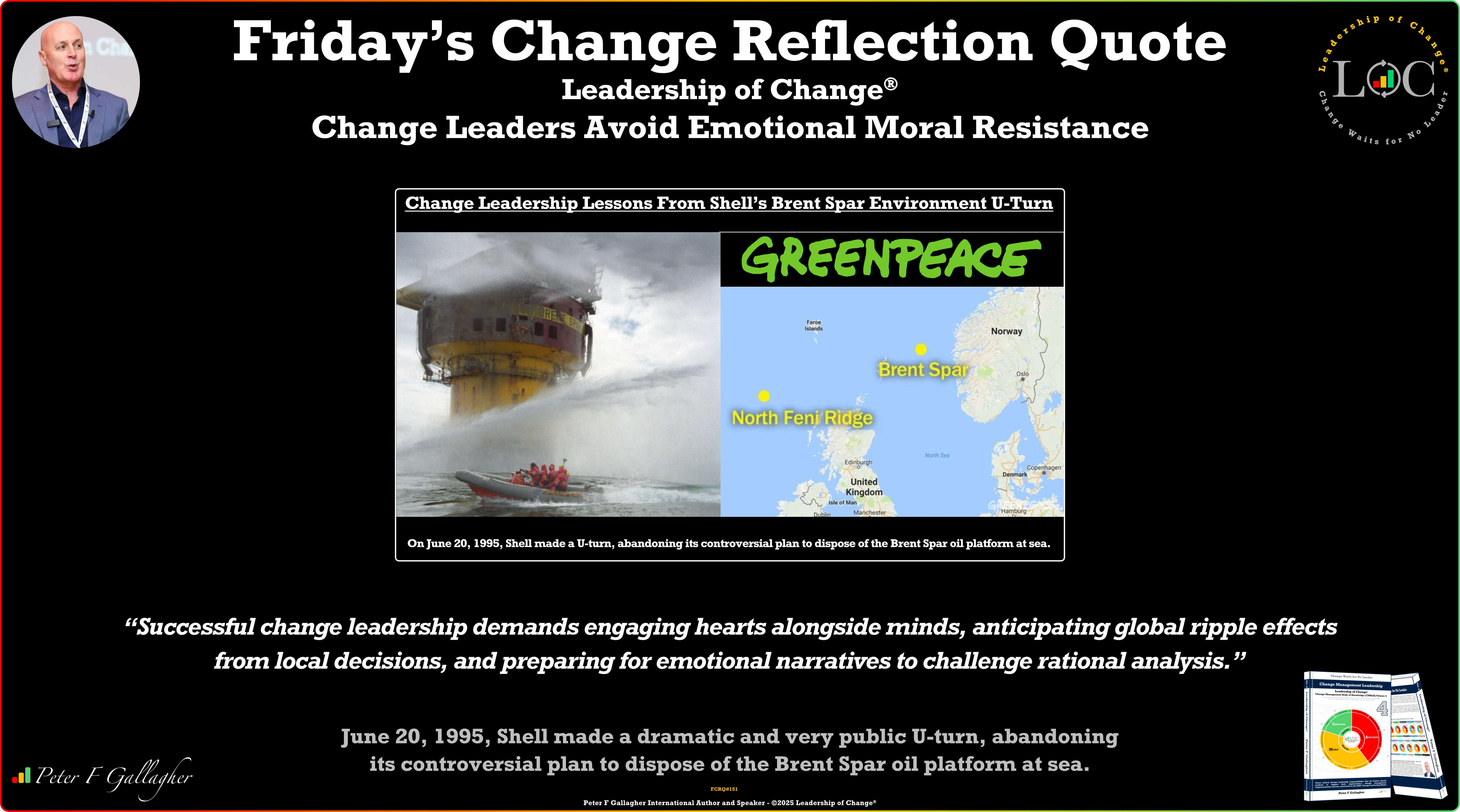 Friday’s Change Reflection Quote - Leadership of Change - Change Leaders Avoid Emotional Moral Resistance
Friday’s Change Reflection Quote - Leadership of Change - Change Leaders Avoid Emotional Moral Resistance
Leadership Learning!
On this Day, 20th June 1995, Shell made a dramatic and very public U-turn—abandoning its controversial plan to dispose of the Brent Spar oil platform at sea, after intense global criticism and environmental activism. The controversy erupted on 30th April 1995 when Greenpeace activists occupied the Brent Spar platform, located 190 kilometres northeast of the Shetland Islands. Shell had received UK government approval to scuttle the 14,500-tonne platform in the Atlantic, citing scientific assessments and regulatory compliance. Greenpeace contested these findings, alleging the platform held 5,500 tonnes of oil and toxins that threatened marine ecosystems. Television footage of activists being blasted with water cannons whilst occupying the platform generated enormous public sympathy across Europe. German consumers launched massive boycotts of Shell petrol stations, with some stations reporting sales drops of up to 50 per cent. The controversy reached the highest political levels when German Chancellor Helmut Kohl personally confronted British Prime Minister John Major at the G7 summit in Halifax, demanding Britain reconsider its position. As protests intensified across Europe, Shell faced increasing isolation and relentless political, consumer, and media pressure. The company's share price declined, and its carefully cultivated corporate reputation suffered severe damage. Recognising the untenable nature of its position, Shell announced on 20th June 1995 that it would abandon sea disposal and pursue alternative options for dismantling the platform onshore. The Brent Spar incident represents a watershed moment in corporate environmental responsibility and stakeholder engagement. It reshaped how multinational corporations interact with environmental groups and public opinion, proving how swiftly activism can challenge entrenched decisions. The incident highlighted how media-savvy environmental groups could rapidly mobilise cross-border sentiment and exert unprecedented corporate pressure. This marked the rise of a more sophisticated, strategic era in the environmental movement. Greenpeace’s campaign combined direct action, science, global media, and consumer mobilisation in ways no prior campaign had achieved. The organisation successfully transformed a technical regulatory matter into a powerful moral crusade that resonated with millions of European consumers.
Change Leadership Lessons: Events such as this illustrate why leaders must look beyond operational correctness to anticipate public, political, and emotional dynamics. The Shell Brent Spar incident offers valuable insights to leaders who prioritise technical arguments and profit, while neglecting public sentiment and environmental concerns. Leaders of change must recognise that technical correctness and regulatory approval alone cannot guarantee successful corporate decision-making today. They discover that sophisticated activist campaigns using emotionally compelling narratives can outweigh expert-led reasoning, even when grounded in fact. Change leaders understand that corporate decisions with seemingly local impact can rapidly escalate into international crises through interconnected networks. They learn that conventional corporate communication approaches fail against modern activist organisations employing sophisticated media manipulation and coordination techniques. Leaders of change recognise that corporate crises can evolve from routine operational matters to international incidents within weeks. ChangeLeaders Avoid Emotional Moral Resistance.
“Successful change leadership demands engaging hearts alongside minds, anticipating global ripple effects from local decisions, and preparing for emotional narratives to challenge rational analysis.”
Application - Change Leadership Responsibility 2 - Model the New Way:
A fundamental responsibility of change leaders is to model how integrity, accountability, and aligned actions must drive decision-making based on core values. During complex change, especially under public scrutiny, actions must not only follow internal assessments but also anticipate how stakeholders will perceive intent and consequence. Modelling the new way requires visibly demonstrating responsible leadership when ethical dilemmas arise, particularly when technical accuracy conflicts with emotional or moral concerns. Leaders must personify the behaviour they wish others to adopt—integrity in the face of opposition, humility when challenged, and transparency when under pressure. In stakeholder-driven change environments, credibility is earned not through data alone but through visible, values-based conduct. Leadership modelling is not symbolic. It is the daily act of ensuring change leadership reflects both the rational case for change and the emotional demands of those it affects.
Final Thoughts: Effective change leadership is tested when moral pressure challenges technical certainty. Modelling values under scrutiny strengthens credibility and deepens trust. Leaders who embody ethical resolve in turbulent times show their organisations and the world what principled leadership truly means.
Credit and thank you: Greenpeace.
Further Reading: Change Management Leadership - Leadership of Change® Volume 4.
Peter F. Gallagher consults, speaks, and writes on Leadership of Change®. He works exclusively with boards, CEOs, and senior leadership teams to prepare and align them to effectively and proactively lead their organisations through change and transformation.
For insights on navigating organisational change, feel free to reach out at Peter.gallagher@a2B.consulting.
Credit and Thank you: Greenpeace
#LeadershipofChange #Leadership #ChangeLeadership #GlobalGurus #ChangeManagement #Shell #EnvironmentalIntegrity #BrentSparFurther Reading: Change Management Leadership - Leadership of Change® Volume 4
Have a fantastic weekend with the ones you love and care for, enjoy some fresh air, exercise, eat, drink, and be happy.
Peter F. Gallagher consults, speaks, and writes on Leadership of Change®. He works exclusively with boards, CEOs, and senior leadership teams to prepare and align them to effectively and proactively lead their organisations through change and transformation.
For insights on navigating organisational change, feel free to reach out at Peter.gallagher@a2B.consulting.
For further reading please visit our websites: https://www.a2b.consulting https://www.peterfgallagher.com Amazon.com: Peter F Gallagher: Books, Biography, Blog, Audiobooks, Kindle
Leadership of Change® Body of Knowledge Volumes: Change Management Body of Knowledge (CMBoK) Books: Volumes 1, 2, 3, 4, 5, 6, 7, 8, 9, 10, A, B, C, D & E available on both Amazon and Google Play:
~ Leadership of Change® Volume 1 - Change Management Fables
~ Leadership of Change® Volume 2 - Change Management Pocket Guide
~ Leadership of Change® Volume 3 - Change Management Handbook
~ Leadership of Change® Volume 4 - Change Management Leadership
~ Leadership of Change® Volume 5 - Change Management Adoption
~ Leadership of Change® Volume 6 - Change Management Behaviour
~ Leadership of Change® Volume 7 - Change Management Sponsorship
~ Leadership of Change® Volume 8 - Change Management Charade
~ Leadership of Change® Volume 9 - Change Management Insanity
~ Leadership of Change® Volume 10 - Change Management Dilenttante
~ Leadership of Change® Volume A - Change Management Gamification - Leadership
~ Leadership of Change® Volume B - Change Management Gamification - Adoption
Tags: Leadership, Change Management, Business Strategy
 Friday’s Change Reflection Quote - Leadership of Change - Change Leaders Align Distinctive Value
Friday’s Change Reflection Quote - Leadership of Change - Change Leaders Align Distinctive Value
Leadership Learning!
On this Day, 13th June 2016, Microsoft announced its intent to acquire LinkedIn for US $26.2 billion, marking one of the largest tech acquisitions in history. The Microsoft-LinkedIn acquisition offers profound insights into transformational change leadership, going beyond typical merger strategies by prioritising cultural cohesion and long-term value creation. The success of this unprecedented combination demonstrates how visionary leaders can orchestrate complex organisational transformations whilst maintaining cultural integrity and strategic focus. Satya Nadella's approach to this acquisition exemplified the principle of strategic patience combined with decisive action. Instead of enforcing rapid integration that risked undermining LinkedIn’s unique identity, Nadella demonstrated remarkable restraint by preserving LinkedIn’s autonomous operations and leadership structure. This decision reflected a deep understanding that sustainable change requires respect for existing organisational strengths whilst building new capabilities. The retention of Jeff Weiner as LinkedIn’s Chief Executive, reporting directly to Nadella, established a dual leadership model that enabled both preservation and transformation. The acquisition strategy revealed the critical importance of ecosystem thinking in modern change leadership. While traditional tech acquisitions aim to eliminate competition or acquire capabilities, Microsoft’s strategy showed how combining platforms can generate new, strategic value that neither could achieve alone. By integrating LinkedIn's professional networking platform with Microsoft's productivity suite, cloud services, and business intelligence tools, the acquisition created synergies that neither organisation could achieve independently. This ecosystem approach required leaders to think beyond traditional industry boundaries and envision convergent possibilities that others might overlook. Blending Microsoft’s engineering-driven culture with LinkedIn’s social media ethos highlighted the cultural complexity leaders face during transformational change. Successful change leaders must navigate these cultural tensions whilst preserving the unique attributes that made each organisation successful. The decision to maintain LinkedIn's Mountain View headquarters and distinctive culture demonstrated how leaders can honour organisational heritage whilst pursuing transformational objectives. The timing of this acquisition also illustrated the importance of strategic opportunism in change leadership. Microsoft’s decisive action eliminated competitive threats from Salesforce and Google whilst securing a critical component of its future enterprise strategy. This demonstrates how effective change leaders must balance careful planning with rapid execution when strategic opportunities emerge. The ability to commit significant resources to long-term transformation whilst maintaining short-term operational excellence requires exceptional leadership discipline and stakeholder confidence. The acquisition reflected a convergence of vision, culture, and strategic foresight.
Change Leadership Lessons: The Microsoft-LinkedIn integration offers valuable lessons for leaders navigating complex organisational change. Leaders of change demonstrate strategic restraint by preserving organisational strengths whilst simultaneously building new capabilities through patient transformation approaches. They create unprecedented value propositions by integrating diverse platforms rather than pursuing conventional competitive elimination strategies. Change leaders navigate cultural tensions by honouring organisational heritage whilst pursuing ambitious transformational objectives simultaneously. They balance careful planning with rapid execution when opportunities emerge, maintaining stakeholder support throughout extended transformation timelines. Leaders of change determine which elements require integration for synergy creation whilst preserving autonomous operations that maintain distinctive value. Change Leaders Align Distinctive Value.
“Change leadership requires strategic patience balanced with decisive action, ecosystem thinking beyond boundaries, cultural intelligence, opportunistic timing, and sophisticated autonomy management.”
Application – Change Leadership Responsibility 1 - Articulate a Change Vision: The Microsoft-LinkedIn acquisition showcases the pivotal role of a clearly articulated change vision in large-scale transformation. Satya Nadella’s vision went beyond a simple merger; it outlined a strategic narrative focused on creating a collaborative ecosystem that amplified both platforms’ strengths. By communicating this vision transparently and aligning it with long-term stakeholder value, Nadella secured support across both organisations. His commitment to preserving LinkedIn’s autonomy while integrating its capabilities into Microsoft’s broader ecosystem demonstrated clarity of purpose and confidence in execution. Effective change leaders craft aspirational yet credible visions, guiding diverse teams through ambiguity while reinforcing a shared sense of direction. A compelling change vision is not just about intent but about the ongoing communication and modelling of that vision in everyday decisions. It earns trust, enables alignment, and empowers individuals to act with confidence amid uncertainty.
Final Thoughts: Strategic vision, when communicated with clarity and conviction, can unite diverse cultures and capabilities. Great change leaders know when to act boldly, and when to pause and protect what makes each part of the whole valuable.
Further Reading: Change Management Leadership - Leadership of Change® Volume 4
Have a fantastic weekend with the ones you love and care for, enjoy some fresh air, exercise, eat, drink, and be happy.
Peter F. Gallagher consults, speaks, and writes on Leadership of Change®. He works exclusively with boards, CEOs, and senior leadership teams to prepare and align them to effectively and proactively lead their organisations through change and transformation.
For insights on navigating organisational change, feel free to reach out at Peter.gallagher@a2B.consulting.
For further reading please visit our websites: https://www.a2b.consulting https://www.peterfgallagher.com Amazon.com: Peter F Gallagher: Books, Biography, Blog, Audiobooks, Kindle
Leadership of Change® Body of Knowledge Volumes: Change Management Body of Knowledge (CMBoK) Books: Volumes 1, 2, 3, 4, 5, 6, 7, 8, 9, 10, A, B, C, D & E available on both Amazon and Google Play:
~ Leadership of Change® Volume 1 - Change Management Fables
~ Leadership of Change® Volume 2 - Change Management Pocket Guide
~ Leadership of Change® Volume 3 - Change Management Handbook
~ Leadership of Change® Volume 4 - Change Management Leadership
~ Leadership of Change® Volume 5 - Change Management Adoption
~ Leadership of Change® Volume 6 - Change Management Behaviour
~ Leadership of Change® Volume 7 - Change Management Sponsorship
~ Leadership of Change® Volume 8 - Change Management Charade
~ Leadership of Change® Volume 9 - Change Management Insanity
~ Leadership of Change® Volume 10 - Change Management Dilenttante
~ Leadership of Change® Volume A - Change Management Gamification - Leadership
~ Leadership of Change® Volume B - Change Management Gamification - Adoption
Tags: Business Strategy, Change Management, Leadership
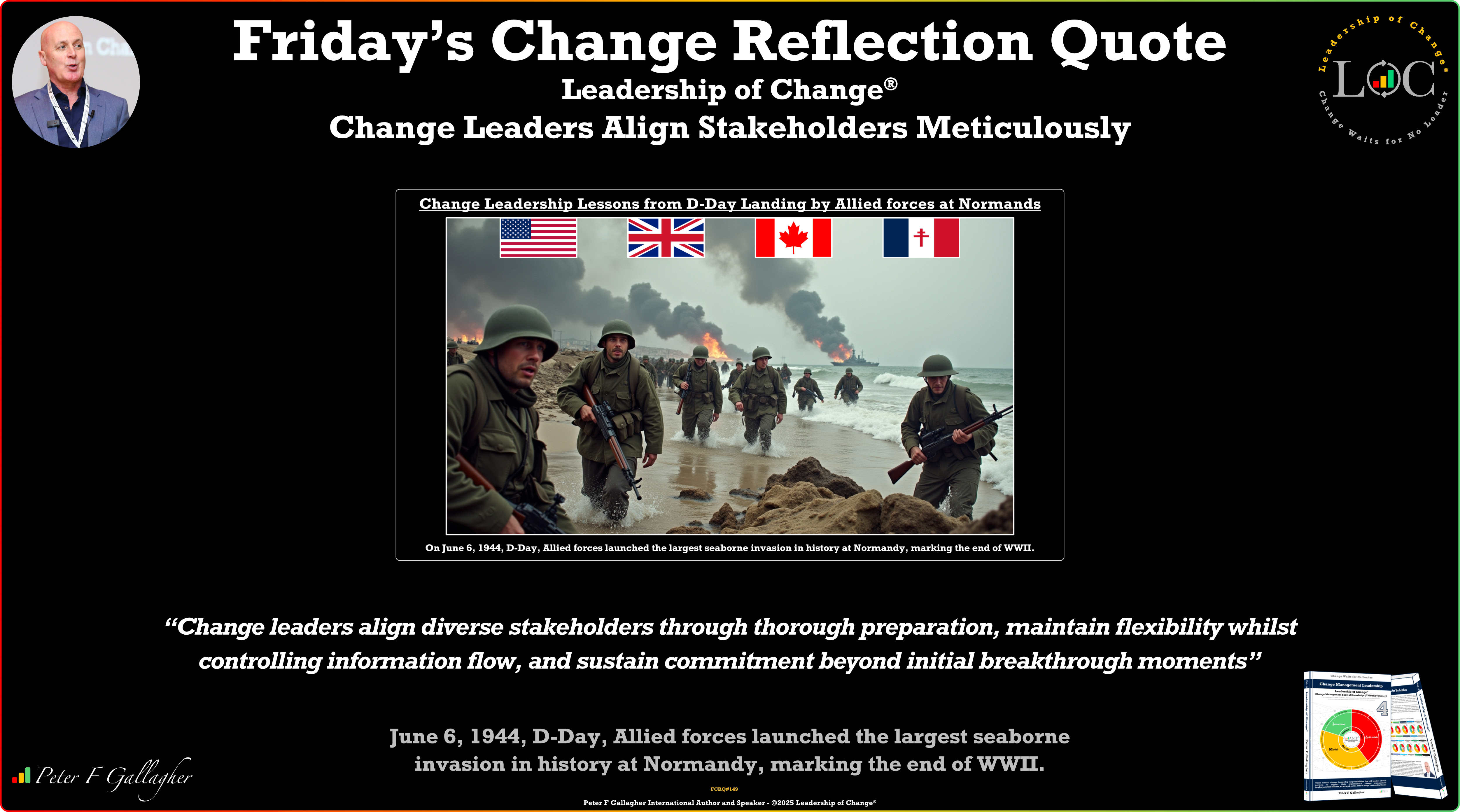 Friday’s Change Reflection Quote - Leadership of Change - Leaders Plan and Communicate Meticulously
Friday’s Change Reflection Quote - Leadership of Change - Leaders Plan and Communicate Meticulously
Leadership Learning!
On this day, 6th June 1944, D-Day, Allied forces launched the largest seaborne invasion in history at Normandy, initiating the final chapter of World War II in Europe. Operation Overlord demanded an extraordinary mobilisation of resources, strategy, and leadership across multiple Allied nations. Nearly 160,000 troops landed on the first day, and over two million would be in France by the end of August. By mid-1944, nearly nine million tonnes of supplies had been shipped from North America to Britain—underscoring the monumental logistics behind this decisive turning point. The invasion delivered five naval assault divisions to the Normandy beaches—UTAH, OMAHA, GOLD, JUNO, and SWORD, supported by 7,000 ships and landing craft, and over 195,000 naval personnel from eight Allied nations. Troops from four Allied nations landed on D-Day: the United States, United Kingdom, Canada, and Free France. These countries contributed ground forces on the beaches or through airborne operations, forming the core military effort on 6 June 1944. The campaign unfolded in two key phases: Operation Neptune (the naval assault) and Operation Overlord (the broader land invasion). British and American airborne forces also landed inland, reflecting the complexity of synchronising land, sea, and air objectives. The leadership of General Dwight D. Eisenhower, who unified Allied forces under a single strategic vision, and General Bernard Montgomery, who commanded the ground assault, were instrumental in maintaining alignment and focus. Strategic alignment among the Allies proved challenging. Though united in defeating Germany, the US and Britain clashed over tactics until the Trident Conference in May 1943 resolved to launch the cross-Channel invasion. Intelligence and deception were equally vital. Operation Bodyguard misled German forces about the location and timing of the attack, requiring coordination across intelligence networks and military commands. Human resources came from a vast Allied coalition. Over 1.4 million American servicemen and a substantial Canadian force had arrived since 1943, demanding integration of different military cultures, training standards, and command systems. Weather added uncertainty, forcing a one-day delay from the original 5 June date. The air component was equally vital; airmen had spent months degrading German air and transport capabilities to enable the invasion’s success. D-Day was not just a military operation—it was a masterclass in coalition leadership, strategic alignment, and high-stakes execution. It remains a defining example of how leaders can orchestrate complex, multinational change under immense pressure.
Change Leadership Lessons: This extraordinary historical event offers enduring leadership insights for those guiding modern transformations. The coordination and scale of D-Day offer compelling lessons for modern change leaders operating in complex, high-risk environments. Leaders of change must align multiple organisations with different cultures towards unified objectives whilst maintaining individual strengths and capabilities. They require extensive planning, resource allocation, and stakeholder alignment over extended periods before attempting major transformational initiatives with consequences. Change leaders must balance detailed preparation with adaptability when external factors threaten carefully planned initiatives whilst maintaining overall strategic direction. They must manage information flow, shape stakeholder expectations, and position initiatives to minimise resistance and maximise engagement. Leaders of change must recognise that breakthrough moments create momentum requiring continued effort, adaptation, and perseverance to achieve transformational objectives. Change Leaders Align Stakeholders Meticulously.
“Change leaders align diverse stakeholders through thorough preparation, maintain flexibility whilst controlling information flow, and sustain commitment beyond initial breakthrough moments.”
Application – Change Leadership Responsibility 1 - Articulate a Change Vision: The successful execution of D-Day serves as a powerful illustration of the critical role that a well-articulated change vision plays in driving transformative efforts. Effective organisational change begins with a leader's ability to craft and communicate a compelling vision that transcends historical grievances and unites diverse interests. It should address immediate priorities while laying the foundation for long-term collaboration and inclusive progress. Change leaders must develop visions that are aspirational yet grounded in practical realities, ensuring they are supported by robust structures essential for sustainable progress. A clearly articulated change vision aligns stakeholders, clarifies purpose, and guides decision-making under pressure. Leaders must actively listen and incorporate diverse perspectives, framing the change in a way that resonates with all involved. A principled, pragmatic vision builds credibility, earns trust, reduces resistance, and accelerates transformation. Articulating this vision requires continuous refinement, emotional intelligence, and resilience, maintaining focus on long-term outcomes despite setbacks. Ultimately, a compelling change vision serves as the cornerstone of successful transformation, guiding organisations through complexities while uniting stakeholders around a shared purpose.
Final Thoughts: D-Day demonstrates that transformational change demands meticulous preparation, unified vision, and relentless coordination. Modern change leaders must emulate this disciplined approach to drive successful outcomes in high-stakes environments.
Peter F. Gallagher consults, speaks, and writes on Leadership of Change®. He works exclusively with boards, CEOs, and senior leadership teams to prepare and align them to effectively and proactively lead their organisations through change and transformation.
For insights on navigating organisational change, feel free to reach out at Peter.gallagher@a2B.consulting.
For further reading please visit our websites: https://www.a2b.consulting https://www.peterfgallagher.com Amazon.com: Peter F Gallagher: Books, Biography, Blog, Audiobooks, Kindle
Leadership of Change® Body of Knowledge Volumes: Change Management Body of Knowledge (CMBoK) Books: Volumes 1, 2, 3, 4, 5, 6, 7, 8, 9, 10, A, B, C, D & E available on both Amazon and Google Play:
~ Leadership of Change® Volume 1 - Change Management Fables
~ Leadership of Change® Volume 2 - Change Management Pocket Guide
~ Leadership of Change® Volume 3 - Change Management Handbook
~ Leadership of Change® Volume 4 - Change Management Leadership
~ Leadership of Change® Volume 5 - Change Management Adoption
~ Leadership of Change® Volume 6 - Change Management Behaviour
~ Leadership of Change® Volume 7 - Change Management Sponsorship
~ Leadership of Change® Volume 8 - Change Management Charade
~ Leadership of Change® Volume 9 - Change Management Insanity
~ Leadership of Change® Volume 10 - Change Management Dilenttante
~ Leadership of Change® Volume A - Change Management Gamification - Leadership
~ Leadership of Change® Volume B - Change Management Gamification - Adoption
Tags: Business Strategy, Change Management, Leadership
 Friday’s Change Reflection Quote - Leadership of Change - Change Leaders Have Authentic Capability
Friday’s Change Reflection Quote - Leadership of Change - Change Leaders Have Authentic Capability
Leadership Learning!
On this day, 30th May 2023, Elizabeth Holmes, the former founder of Theranos, began her 11-year prison sentence for defrauding investors, highlighting the critical importance of ethical leadership and transparency in the business world. This case exemplifies one of the most significant corporate fraud scandals in recent Silicon Valley history. Holmes, once hailed as the youngest female billionaire, founded Theranos in 2003 at the age of 19, claiming her company could revolutionise blood testing with a device called the Edison that would perform hundreds of tests using just a drop of blood. For over a decade, Holmes cultivated an image of innovative genius, securing over $900 million from high-profile investors including former Secretaries of State Henry Kissinger and George Shultz, media mogul Rupert Murdoch, and the Walton family. However, the promised technology failed to materialise. Internal whistleblowers, most notably former employee Tyler Leach-Schultz, grandson of board member George Shultz, revealed that Theranos was using traditional machines from other companies for most of its tests, diluting tiny blood samples to dangerous levels, and manipulating results. The company's claims were thoroughly debunked by investigations from The Wall Street Journal, leading to the company's collapse in 2018. Holmes was convicted on four counts of fraud in January 2022 and sentenced to over 11 years in federal prison, with her sentence beginning on 30th May 2023 at Federal Prison Camp Bryan in Texas. The scandal resulted in the loss of hundreds of millions of dollars for investors and potentially endangered patients who received inaccurate blood test results. This extraordinary case transcends simple corporate malfeasance, representing a profound study in how organisational culture, leadership philosophy, and institutional pressures can create environments where deception flourishes whilst genuine innovation fails to thrive. The Theranos saga illuminates the complex interplay between visionary ambition and ethical responsibility, revealing how the very qualities that can drive transformational change can, when unchecked by moral constraints, lead to catastrophic organisational failure.
Change Leadership Lessons: This historic failure offers enduring leadership insights for driving ethical, sustainable change. The lessons from this case highlight the essential qualities required for effective change leadership. Leaders of change must ensure sustainable organisational transformation requires genuine technological capabilities rather than persuasive storytelling that masks fundamental operational deficiencies. They cannot allow prestigious board appointments to substitute for rigorous oversight processes that independently verify claims and challenge leadership assumptions. Change leaders recognise that excessive secrecy undermines organisational health by preventing necessary internal dialogue that identifies problems before systemic failures. They understand that long-term change initiatives succeed when leaders prioritise genuine stakeholder value creation over short-term perception management and relations. Leaders of change know that organisations encouraging dissenting voices and protecting internal critics demonstrate stronger adaptive capacity than those suppressing truths. Change Leaders Have Authentic Capability.
“True change leadership requires authentic capability over narrative, rigorous governance beyond titles, transparency despite pressure, stakeholder value above perception, and protection for dissent.”
Application - Lead With Integrity: In the case of Theranos, failures in leadership integrity eroded public trust, as the organisation prioritised image over evidence and ambition over authenticity. This case underscores the critical role that personal integrity plays in guiding organisations through complex change journeys. All great change begins with a leader’s ability to create a vision, but a vision not grounded in moral conviction risks becoming dangerously detached from reality. Leaders of change must demonstrate unwavering honesty, especially when faced with uncertainty or scrutiny. Honesty cultivates psychological safety and enables employees to confront and overcome operational challenges without fear. Moral leadership is not aspirational; it is a foundational requirement for those seeking to lead transformation. Research consistently shows that ethical leadership delivers more sustainable organisational outcomes and promotes long-term performance. While most employees recognise the value of moral leadership, many feel that integrity is often claimed but rarely demonstrated. This dissonance undermines change initiatives and erodes confidence in leadership. True credibility is earned through trust, consistency, and alignment between what leaders say and what they do. In the face of competing pressures, leaders must model the ethical behaviour they expect from others. Leading with integrity is neither optional nor symboli, it is essential for building cultures capable of sustaining real change.
Final Thoughts: The Theranos collapse reminds us that leadership integrity is not a fashion nor is it optional. It is the foundation of sustainable leadership. Authentic capability means aligning ambition with moral clarity, rigorous governance, and a commitment to truth.
Peter F. Gallagher consults, speaks, and writes on Leadership of Change®. He works exclusively with boards, CEOs, and senior leadership teams to prepare and align them to effectively and proactively lead their organisations through change and transformation.
For insights on navigating organisational change, feel free to reach out at Peter.gallagher@a2B.consulting.
For further reading please visit our websites: https://www.a2b.consulting https://www.peterfgallagher.com Amazon.com: Peter F Gallagher: Books, Biography, Blog, Audiobooks, Kindle
Leadership of Change® Body of Knowledge Volumes: Change Management Body of Knowledge (CMBoK) Books: Volumes 1, 2, 3, 4, 5, 6, 7, 8, 9, 10, A, B, C, D & E available on both Amazon and Google Play:
~ Leadership of Change® Volume 1 - Change Management Fables
~ Leadership of Change® Volume 2 - Change Management Pocket Guide
~ Leadership of Change® Volume 3 - Change Management Handbook
~ Leadership of Change® Volume 4 - Change Management Leadership
~ Leadership of Change® Volume 5 - Change Management Adoption
~ Leadership of Change® Volume 6 - Change Management Behaviour
~ Leadership of Change® Volume 7 - Change Management Sponsorship
~ Leadership of Change® Volume 8 - Change Management Charade
~ Leadership of Change® Volume 9 - Change Management Insanity
~ Leadership of Change® Volume 10 - Change Management Dilenttante
~ Leadership of Change® Volume A - Change Management Gamification - Leadership
~ Leadership of Change® Volume B - Change Management Gamification - Adoption
Tags: Leadership, Change Management, Business Strategy
 Friday’s Change Reflection Quote - Leadership of Change - Change Leaders Reject Zero-Sum Thinking
Friday’s Change Reflection Quote - Leadership of Change - Change Leaders Reject Zero-Sum Thinking
On 23 May 1998, UK Prime Minister Tony Blair welcomed the results of the referendum on the Good Friday Agreement, calling it “a day for joy.” The previous day, an overwhelming 71.12% of voters in Northern Ireland and 94.39% in the Republic of Ireland endorsed the historic accord, formally known as the Belfast Agreement, ending decades of violent conflict known as ‘The Troubles’. The Agreement, signed on 10 April 1998, concluded intensive multi-party negotiations that had commenced in 1996. Facilitated by Senator George Mitchell, the talks brought together eight Northern Irish parties, the UK and Irish governments, and key stakeholders with historical links to paramilitary organisations. The deal introduced a power-sharing government, policing reforms, early prisoner releases, and constitutional changes in both the UK and Ireland. This was a decisive shift from zero-sum politics to shared governance, recognising both unionist and nationalist aspirations. The public endorsement signalled a readiness to move beyond entrenched conflict toward peace, mutual respect, and long-term cooperation. Tony Blair’s leadership proved instrumental. Coming to power in 1997, he made peace in Northern Ireland a central priority. His approach was bold: direct engagement with all parties, inclusive diplomacy, and the conviction that peace required the participation of every stakeholder, regardless of past associations. Blair combined vision with pragmatism, helping craft consensus in a highly fragmented environment and showing rare political courage. The success of the referendum was not just political; it was deeply human. It showed that peace is possible when leaders have the courage to act, the patience to persist, and the vision to unite. It also demonstrated the power of democratic legitimacy: placing the agreement in the hands of the people provided a foundation strong enough to withstand the difficult path ahead. Blair’s phrase, ‘a day for joy,’ captured not just celebration, but a turning point toward a more hopeful, inclusive, and resilient future. This momentous vote offers valuable insight into how change leaders drive transformation amid deeply entrenched division. The successful transformation from ingrained conflict to collaborative governance provides profound insights for contemporary change leaders.
Change Leadership Lessons: This historic transformation demonstrates five critical principles that define exceptional change leadership. Leaders of change must engage all affected parties, including those with controversial histories or uncomfortable associations. They maintain multiple parallel relationships whilst building trust incrementally across traditional divides and organisational boundaries. Change leaders utilise skilled neutral facilitators who provide credibility and strategic guidance during inevitable crisis moments. They ensure major transformations have broad-based popular support beyond elite agreement to guarantee sustainability and implementation. Leaders of change articulate compelling futures that transcend historical grievances whilst possessing practical skills for implementation. Change Leaders Reject Zero-Sum Thinking.
“Visionary change leaders reject zero-sum thinking, embracing inclusive engagement, balanced principles, neutral facilitation, democratic legitimacy, and practical implementation.”
Application – Change Leadership Responsibility 1 – Articulate a Change Vision:
The overwhelming public endorsement of the Good Friday Agreement marked a significant transformation in Northern Ireland’s political and social landscape. All meaningful change begins with a leader’s ability to craft and communicate a compelling vision—one that transcends historical grievances, addresses practical realities, and unites diverse interests around a shared future. In this case, the vision went beyond stopping violence; it was about creating a stable, inclusive society where power would be shared, and mutual respect institutionalised. Change leaders must craft visions that are aspirational yet grounded in balanced principles and practical structures necessary for sustainable progress. A clearly articulated change vision fosters alignment, clarifies purpose, and enables consistent decision-making under pressure. Leaders must listen actively, incorporate competing viewpoints, and frame the change in a way that resonates with all stakeholders. When a vision is both principled and pragmatic, it earns credibility. This credibility allows leaders to build trust, reduce resistance, and catalyse lasting transformation. Articulating a change vision requires continuous refinement, demanding emotional intelligence, resilience, and unwavering focus on long-term outcomes despite inevitable setbacks.
Final Thoughts: Visionary leaders shape inclusive futures that unite divided perspectives. Effective change visions, supported by neutral facilitation, transform entrenched divisions into sustainable collaborative frameworks.
Peter F. Gallagher consults, speaks, and writes on Leadership of Change®. He works exclusively with boards, CEOs, and senior leadership teams to prepare and align them to effectively and proactively lead their organisations through change and transformation.
For insights on navigating organisational change, feel free to reach out at Peter.gallagher@a2B.consulting.
For further reading please visit our websites: https://www.a2b.consulting https://www.peterfgallagher.com Amazon.com: Peter F Gallagher: Books, Biography, Blog, Audiobooks, Kindle
Leadership of Change® Body of Knowledge Volumes: Change Management Body of Knowledge (CMBoK) Books: Volumes 1, 2, 3, 4, 5, 6, 7, 8, 9, 10, A, B, C, D & E available on both Amazon and Google Play:
~ Leadership of Change® Volume 1 - Change Management Fables
~ Leadership of Change® Volume 2 - Change Management Pocket Guide
~ Leadership of Change® Volume 3 - Change Management Handbook
~ Leadership of Change® Volume 4 - Change Management Leadership
~ Leadership of Change® Volume 5 - Change Management Adoption
~ Leadership of Change® Volume 6 - Change Management Behaviour
~ Leadership of Change® Volume 7 - Change Management Sponsorship
~ Leadership of Change® Volume 8 - Change Management Charade
~ Leadership of Change® Volume 9 - Change Management Insanity
~ Leadership of Change® Volume 10 - Change Management Dilenttante
~ Leadership of Change® Volume A - Change Management Gamification - Leadership
~ Leadership of Change® Volume B - Change Management Gamification - Adoption
Tags: Leadership, Change Management, Business Strategy
 Friday’s Change Reflection Quote - Leadership of Change - Change Leaders Make Data-Driven Decisions
Friday’s Change Reflection Quote - Leadership of Change - Change Leaders Make Data-Driven Decisions
Leadership Learning!
On May 16, 1990, United Kingdom Agriculture Minister John Gummer staged a dramatic and controversial media moment and attempted to feed a beefburger to his four-year-old daughter, Cordelia, at the height of rising concern over Bovine Spongiform Encephalopathy (BSE), also known as mad cow disease. The image of Gummer coaxing his hesitant daughter to eat the burger at a Suffolk harbour became a defining symbol of the BSE crisis that engulfed British agriculture and food policy in the 1990s. This orchestrated photo opportunity was intended to reassure a nervous British public that beef was safe to consume despite mounting evidence linking BSE to a fatal human brain condition called variant Creutzfeldt-Jakob Disease (vCJD). The context is significant. BSE was first identified in British cattle in 1986, and by 1990, public anxiety had escalated as scientists began exploring potential connections between the cattle disease and human health risks. Despite growing concerns, the government insisted that British beef remained completely safe for human consumption. Gummer's public relations exercise with his young daughter was meant to demonstrate his absolute confidence in this position. What made the moment particularly striking was the use of a vulnerable child to convey a political message about food safety. Reports from the event note that Cordelia appeared hesitant to eat the burger, with some accounts suggesting she ultimately refused, though Gummer himself consumed his portion with apparent confidence. The BBC and other major news outlets captured the scene, which was subsequently broadcast across the nation. The historical significance of this event cannot be overstated. Just six years later, in March 1996, the British government would make a complete reversal of position, acknowledging a probable link between BSE and vCJD. By this time, cases of the human disease were emerging, predominantly in young people, leading to 177 deaths in the UK. The European Union imposed a worldwide ban on British beef exports that would last for ten years, devastating the £520 million export industry and requiring the slaughter of 4.4 million cattle.
Change Leadership Lessons: This iconic moment of crisis mismanagement offers profound lessons for modern change leadership. This unfolding emergency offers critical insights into how leaders must respond transparently and ethically during times of growing public concern. Leaders of change must recognise that making absolute safety claims without sufficient evidence inevitably damages public trust beyond the immediate crisis situation. They should embrace transparent acknowledgment of uncertainty rather than projecting unfounded confidence that could later be contradicted by emerging facts. Change leaders need to carefully balance organisational economic interests with stakeholder safety concerns, particularly when scientific evidence continues to evolve. They should avoid using vulnerable stakeholders for political demonstrations as this approach often backfires and undermines the core message being conveyed. Leaders of change must understand that short-term reassurance strategies frequently cause catastrophic long-term consequences by delaying necessary protective measures. Change Leaders Make Data-Driven Decisions.
“Successful change demands leaders who balance transparency with action, acknowledging uncertainty while protecting stakeholders through evidence-based decisions rather than reassuring rhetoric.”
Application - Change Leadership Responsibility 2 - Model the New Way: A fundamental responsibility of leaders in driving organisational change is to Model the New Way. The BSE crisis demonstrates how actions speak louder than words when leaders promote new directions. Modelling the new way is the one key task leaders of change do not need props for, nor should they delegate this to others. For change to be credible, visible alignment between words and actions is essential. At the heart of modelling the new way lies leading with integrity, an indispensable quality for any leader of change. Integrity forms the foundation of trust, which underpins every successful transformation. A leader must act with honesty, especially when change brings discomfort or loss. Employees are far more likely to follow when they believe the leader is being truthful, even when the message is difficult. Moral leadership requires standing for what is right, even when it means opposing popular opinion or prioritisation of profit over safety. This is particularly relevant when navigating conflicting stakeholder expectations. Finally, credibility must be earned through consistent behaviour that reinforces the change message. When leaders are believable, employees are more willing to engage. In the Leadership of Change®, modelling the new way is not symbolic, it is a daily discipline. It ensures the change is not just spoken but seen.
Final Thoughts: A fundamental responsibility of leaders in driving organisational change is to Model the New Way with integrity. Modelling the new way is the one key task leaders of change do not need props for, nor should they delegate this to others.
Peter F. Gallagher consults, speaks, and writes on Leadership of Change®. He works exclusively with boards, CEOs, and senior leadership teams to prepare and align them to effectively and proactively lead their organisations through change and transformation.
For insights on navigating organisational change, feel free to reach out at Peter.gallagher@a2B.consulting.
For further reading please visit our websites: https://www.a2b.consulting https://www.peterfgallagher.com Amazon.com: Peter F Gallagher: Books, Biography, Blog, Audiobooks, Kindle
Leadership of Change® Body of Knowledge Volumes: Change Management Body of Knowledge (CMBoK) Books: Volumes 1, 2, 3, 4, 5, 6, 7, 8, 9, 10, A, B, C, D & E available on both Amazon and Google Play:
~ Leadership of Change® Volume 1 - Change Management Fables
~ Leadership of Change® Volume 2 - Change Management Pocket Guide
~ Leadership of Change® Volume 3 - Change Management Handbook
~ Leadership of Change® Volume 4 - Change Management Leadership
~ Leadership of Change® Volume 5 - Change Management Adoption
~ Leadership of Change® Volume 6 - Change Management Behaviour
~ Leadership of Change® Volume 7 - Change Management Sponsorship
~ Leadership of Change® Volume 8 - Change Management Charade
~ Leadership of Change® Volume 9 - Change Management Insanity
~ Leadership of Change® Volume 10 - Change Management Dilenttante
~ Leadership of Change® Volume A - Change Management Gamification - Leadership
~ Leadership of Change® Volume B - Change Management Gamification - Adoption
Tags: Leadership, Change Management, Business Strategy
 Friday’s Change Reflection Quote - Leadership of Change - Change Leaders Empower Through Servant Wisdom
Friday’s Change Reflection Quote - Leadership of Change - Change Leaders Empower Through Servant Wisdom
Leadership Learning!
On 9 May 1994, Nelson Mandela was elected by South Africa's newly formed National Assembly as the first Black president, marking a historic turning point in the nation's journey toward democracy. This pivotal event followed the inaugural democratic elections from 26 to 29 April 1994, marking a definitive end to apartheid and a collective desire for a united, non-racial society. Mandela's election by Parliament was a significant step in the transition to a multiracial democracy, culminating in his inauguration on 10 May 1994. The African National Congress (ANC), led by Mandela, secured a decisive victory with over 62% of the vote. The peaceful conduct of the elections and the high voter turnout were hailed globally as triumphs of democracy and reconciliation. Mandela's election was not merely a political victory; it symbolised the end of decades of institutionalised racial segregation and oppression. His leadership promised a new beginning for a nation long divided by apartheid policies. The establishment of a Government of National Unity, which included members from various political parties, underscored his commitment to inclusivity and nation-building. The significance of Mandela's presidency extended beyond South Africa's borders. His dedication to reconciliation and efforts to foster unity in a deeply divided society served as an inspiration worldwide. Mandela's leadership style, characterised by humility and a focus on collective progress, set a precedent for transformative governance. Reflecting on this historic event, Mandela's election symbolised a profound shift in the nation's identity and aspirations, transcending mere leadership change. The peaceful transition of power and the establishment of a democratic government laid the foundation for South Africa's ongoing journey toward equality and justice. In the years following his election, Mandela championed the values of democracy, human rights, and social justice, leaving a legacy that continues to inspire generations.
Change Leadership Lessons: Mandela's remarkable transition from prisoner to president offers profound lessons for modern change leaders. Leaders of change must engage in inclusive negotiation to ensure long-term stability and credibility during political transformation. They should use powerful symbolic acts to unify divided populations and build shared national identity in times of change. Change leaders must prioritise reconciliation mechanisms to allow healing and trust-building after periods of systemic conflict or injustice. They need to project calm and vision to reassure citizens and reduce instability during uncertain transitions. Leaders of change should establish key institutions early to embed legitimacy and accountability into new systems of governance. Change Leaders Empower Through Servant Wisdom.
“Change leadership requires servant wisdom, inclusive decisions, symbolic unity, reconciliatory processes, visionary calm, and institution-building for lasting transformation.”
Application – Change Leadership Responsibility 3 – Intervene to Ensure Sustainable Change: Nelson Mandela’s leadership reminds us that even with a compelling vision, change will only take hold if leaders remain actively involved. In organisational change, senior leaders must go beyond articulating a future state—they must intervene consistently to reinforce the new way of working and embed desired behaviours. All great change starts with a leader’s ability to create a vision, but sustainable transformation depends on their commitment to making that vision real. One powerful historical example is the establishment of national institutions, such as the Truth and Reconciliation Commission, which were not left to evolve independently. They were supported by visible political will, legitimacy, and a sustained commitment to ensure their purpose was fulfilled. In organisations, the same principle applies. Leaders must not assume employees will adopt change on their own. Without reinforcement, the momentum quickly fades, and the organisation risks reverting to the status quo. Intervention can include recognition, consistent communication, visible leadership presence, and timely course correction. Where change is critical, it may require consequences for non-compliance. Change is not self-sustaining. It requires deliberate, ongoing action from leaders to embed progress and demonstrate that the change matters. Sustainable success is achieved when leaders intervene with consistency, clarity, and commitment throughout the change journey.
Final Thoughts: Mandela's leadership legacy illustrates that true transformational change begins with reconciliation and the courage to reshape divided systems. As change leaders reflect on these lessons, they must embrace the balance of innovation and responsibility to ensure a sustainable, society-wide impact.
Peter F. Gallagher consults, speaks, and writes on Leadership of Change®. He works exclusively with boards, CEOs, and senior leadership teams to prepare and align them to effectively and proactively lead their organisations through change and transformation.
For insights on navigating organisational change, feel free to reach out at Peter.gallagher@a2B.consulting.
For further reading please visit our websites: https://www.a2b.consulting https://www.peterfgallagher.com Amazon.com: Peter F Gallagher: Books, Biography, Blog, Audiobooks, Kindle
Leadership of Change® Body of Knowledge Volumes: Change Management Body of Knowledge (CMBoK) Books: Volumes 1, 2, 3, 4, 5, 6, 7, 8, 9, 10, A, B, C, D & E available on both Amazon and Google Play:
~ Leadership of Change® Volume 1 - Change Management Fables
~ Leadership of Change® Volume 2 - Change Management Pocket Guide
~ Leadership of Change® Volume 3 - Change Management Handbook
~ Leadership of Change® Volume 4 - Change Management Leadership
~ Leadership of Change® Volume 5 - Change Management Adoption
~ Leadership of Change® Volume 6 - Change Management Behaviour
~ Leadership of Change® Volume 7 - Change Management Sponsorship
~ Leadership of Change® Volume 8 - Change Management Charade
~ Leadership of Change® Volume 9 - Change Management Insanity
~ Leadership of Change® Volume 10 - Change Management Dilenttante
~ Leadership of Change® Volume A - Change Management Gamification - Leadership
~ Leadership of Change® Volume B - Change Management Gamification - Adoption
Tags: Business Strategy, Change Management, Leadership
 Change Reflection Quote - Leadership of Change - Change Leaders Innovate to Shape Industries
Change Reflection Quote - Leadership of Change - Change Leaders Innovate to Shape Industries
Leadership Learning!
On May 2, 1901, Standard Oil’s pipeline delivered refined crude oil to the Eastern Seaboard for the first time, revolutionising oil distribution and redefining the petroleum industry. This breakthrough, under the leadership of John D. Rockefeller, transformed the logistics and scalability of oil supply in the United States. Prior to pipelines, oil was moved by rail and barrels, methods plagued by high costs, logistical delays, and vulnerability to fluctuating freight rates. The advent of pipelines offered a reliable, cost-effective alternative, streamlining the supply chain and reducing dependency on railroads. Standard Oil's extensive pipeline network allowed it to control the movement of oil from production to market, cementing its dominance. This achievement reflected more than logistical prowess—it reshaped the American economy. Efficient oil transport accelerated industrialisation, supported manufacturing growth, and fuelled urban development. The pipeline system stabilised oil prices and ensured a steady supply for growing energy demands, setting a model for future energy infrastructure. Standard Oil’s control over transportation and production enabled it to dictate market conditions and suppress competition, highlighting the company’s unparalleled influence over the oil sector. This dominance, however, drew increasing scrutiny. The Sherman Antitrust Act, enacted in 1890 to combat monopolies, was eventually used to break up Standard Oil in 1911, underscoring the tension between industrial innovation and market fairness. The integration of transportation and energy production demonstrated the power of infrastructure in shaping market dynamics. By pioneering the use of pipelines, Standard Oil not only optimised oil distribution but also influenced the development of modern energy logistics. This innovation contributed to widespread economic growth, with ripple effects seen across sectors like transportation, manufacturing, and urban planning. The 1901 pipeline delivery was more than a milestone—it was a turning point that marked the rise of infrastructure as a strategic tool in industry. It showcased how foresight and innovation could redefine markets, while also laying the groundwork for regulatory responses to unchecked corporate power.
Change Leadership Lessons: This historic milestone of Standard Oil's pipeline delivery on May 2, 1901, illustrates how change leaders translate strategic foresight, technological innovation, and adaptability into structural transformation with long-lasting industrial impact, offering enduring insights into navigating change across industries. Leaders of change anticipate industry shifts, implementing innovative solutions that sustain success and ensure organisations remain competitive in evolving markets. They invest in efficient infrastructure, driving industrial development, stabilising markets, and fostering long-term economic growth through strategic resource management. Change leaders embrace innovation to overcome logistical challenges, enhancing operational effectiveness and strengthening competitive advantage within dynamic industries. They shape market dynamics by maintaining strategic control, leveraging innovation, and ensuring influence over industry trends and competitive landscapes. Leaders of change recognise the interconnectedness of transformation and economic progress, fostering productivity, industrial expansion, and lasting sector-wide impact. Change Leaders Innovate to Shape Industries.
“Visionary change leaders use foresight, innovation, and strategic adaptability to shape industries, influence markets, and drive sustained economic and industrial transformation.”
Application – Change Leadership Responsibility 1 – Articulate a Change Vision: The 1901 pipeline delivery by Standard Oil offers a powerful historical example of how articulating a bold, strategic change vision can reshape entire industries. All great change starts with a leader’s ability to create a vision, one that not only defines a new destination but also challenges accepted norms and outdated practices. In this case, the vision was not merely to transport oil more efficiently; it was to redefine how the oil industry operated through fully integrated infrastructure, reducing dependency on third-party transport and enabling reliable, scalable energy distribution. In modern organisational settings, visionary change leaders identify opportunities before they become obvious, leading organisations from an inefficient or unstable ‘a’ state toward a more strategic and scalable ‘B’ state. A clearly articulated change vision inspires alignment, focuses resources, and sets expectations. It must address both practical benefits, efficiency, control, resilience, and aspirational values such as innovation, progress, and sustainable growth. Articulating the vision also involves navigating resistance and building stakeholder trust. This requires leaders to be inclusive, ensuring the vision resonates across diverse interests while remaining rooted in shared purpose. Ultimately, articulating a change vision is an ongoing act of leadership that demands clarity, courage, and the conviction to lead through uncertainty.
Final Thoughts: The Standard Oil pipeline legacy shows that transformational change begins with a bold vision and the courage to reshape systems. Change leaders must balance innovation with responsibility to ensure sustainable, industry-wide impact.
Further Reading: Change Management Leadership - Leadership of Change® Volume 4.
Peter F. Gallagher consults, speaks, and writes on Leadership of Change®. He works exclusively with boards, CEOs, and senior leadership teams to prepare and align them to effectively and proactively lead their organisations through change and transformation.
For insights on navigating organisational change, feel free to reach out at Peter.gallagher@a2B.consulting.
For further reading please visit our websites: https://www.a2b.consulting https://www.peterfgallagher.com Amazon.com: Peter F Gallagher: Books, Biography, Blog, Audiobooks, Kindle
Leadership of Change® Body of Knowledge Volumes: Change Management Body of Knowledge (CMBoK) Books: Volumes 1, 2, 3, 4, 5, 6, 7, 8, 9, 10, A, B, C, D & E available on both Amazon and Google Play:
~ Leadership of Change® Volume 1 - Change Management Fables
~ Leadership of Change® Volume 2 - Change Management Pocket Guide
~ Leadership of Change® Volume 3 - Change Management Handbook
~ Leadership of Change® Volume 4 - Change Management Leadership
~ Leadership of Change® Volume 5 - Change Management Adoption
~ Leadership of Change® Volume 6 - Change Management Behaviour
~ Leadership of Change® Volume 7 - Change Management Sponsorship
~ Leadership of Change® Volume 8 - Change Management Charade
~ Leadership of Change® Volume 9 - Change Management Insanity
~ Leadership of Change® Volume 10 - Change Management Dilenttante
~ Leadership of Change® Volume A - Change Management Gamification - Leadership
~ Leadership of Change® Volume B - Change Management Gamification - Adoption
Tags: Business Strategy, Change Management, Leadership
 Friday’s Change Reflection Quote - Leadership of Change - Change Leaders Understand Context Before Acting
Friday’s Change Reflection Quote - Leadership of Change - Change Leaders Understand Context Before Acting
Leadership Learning!
On April 25, 2022, Elon Musk reached an agreement to acquire Twitter for $44 billion. Finalised on October 27, the transaction marked a pivotal moment in the evolution of digital communication and social media governance. Far more than a corporate deal, it exposed the complex intersection of innovation, influence, and ideology—highlighting the imperative for leaders to understand the environment before initiating bold change. Musk, one of the most prominent entrepreneurs of the 21st century, did not simply purchase a platform—he entered the domain of global discourse, with profound implications for expression, ownership, and technological power. Having become Twitter’s largest shareholder earlier that month with a 9.2% stake, Musk’s unsolicited offer to buy the company was met with scepticism, reflecting a lack of shared understanding between the proposed change and the broader stakeholder context. His public rationale centred on defending free speech and unlocking the platform’s potential by taking it private. The proposal swiftly became a binding agreement, sparking global debates about the influence of billionaires over public dialogue. This acquisition was one of the most controversial in social media history. Never before had a figure with such standing in technology and industry assumed full control of a communications platform so central to global events—from the Arab Spring to modern election campaigns. While Musk's bold vision for platform transformation would later prove valuable in driving decisive change, the acquisition process itself revealed the consequences of acting without full contextual understanding. The turbulent road to acquisition underscored the risks of initiating disruptive change without first fully appreciating contextual complexity. Musk’s initial investment triggered defensive responses from Twitter’s board, including a shareholder rights plan. Legal disputes emerged when Musk attempted to withdraw over bot account concerns. Twitter sued, and ultimately, the deal closed on October 27. Musk entered Twitter headquarters carrying a sink—a gesture that became symbolic of sweeping change. Following the acquisition, Musk dismissed top executives, dissolved the board, and rapidly restructured operations, including moderation policies and user verification. Twitter was renamed ‘X’ and is now evolving toward Musk’s vision of an “everything app.” Whether this vision succeeds remains to be seen, but the acquisition stands as a landmark case illustrating the tension between bold leadership and the necessity of contextual understanding.
Change Leadership Lessons: Elon Musk’s acquisition of Twitter illustrates how high-stakes decision-making must be grounded in deep contextual understanding to guide bold audacious, strategic transformation. Leaders of change must demonstrate strategic persistence when external pressures and legal challenges threaten to derail transformation efforts. They risk causing confusion and instability when acting without a deep understanding of the strategic and organisational landscape in which change will be implemented. Change leaders should prioritise open, clear communication to align stakeholders and reduce uncertainty during times of intense transition. They must recognise that legal obligations, cultural sensitivities, and stakeholder expectations can significantly shape, delay, or redirect the path to successful change. Leaders of change set the tone for transformation not simply through action, but by first building alignment between the new strategic intent and the existing organisational context. Change Leaders Understand Context Before Acting.
“Change leadership begins with understanding. Acting without context invites unnecessary resistance; however, an audacious vision aligned with restructuring shapes legacy.”
Application - Understand the Context in Which the Change Will Be Implemented: Elon Musk’s acquisition of Twitter underscores the essential leadership responsibility to understand the context in which change will be implemented. All great change starts with a leader’s ability to assess the full complexity of the environment, internal and external, before action is taken. In this case, a failure to fully anticipate legal, cultural, political, and stakeholder dynamics intensified resistance and destabilised trust during a period of profound organisational transition. While boldness may define the leadership character, judgement defines its success. The digital ecosystem, regulatory pressures, public expectations, and employee sentiment were all crucial contextual factors that shaped the response to the transformation. Rapid restructuring, without first ensuring alignment with platform values, user behaviours, and systemic pressures, resulted in contested perceptions among employees and stakeholders regarding the transformation’s purpose and strategic direction. Such consequences illustrate the risk of bypassing a structured change history assessment©. Leaders who disregard context risk reviving historical patterns of failure, where speed replaces strategy, and reaction overrides reflection. Context is not a backdrop; it is an active force that determines whether transformation will be embraced or resisted. Effective change leadership begins not with announcements, but with understanding, and only then, action.
Final Thoughts: The Twitter acquisition reminds us that lasting change requires more than decisive action, it demands contextual intelligence. By fostering shared understanding before taking bold steps, leaders build the trust and alignment needed for sustainable transformation.
Peter F. Gallagher consults, speaks, and writes on Leadership of Change®. He works exclusively with boards, CEOs, and senior leadership teams to prepare and align them to effectively and proactively lead their organisations through change and transformation.
For insights on navigating organisational change, feel free to reach out at Peter.gallagher@a2B.consulting.
For further reading please visit our websites: https://www.a2b.consulting https://www.peterfgallagher.com Amazon.com: Peter F Gallagher: Books, Biography, Blog, Audiobooks, Kindle
Leadership of Change® Body of Knowledge Volumes: Change Management Body of Knowledge (CMBoK) Books: Volumes 1, 2, 3, 4, 5, 6, 7, 8, 9, 10, A, B, C, D & E available on both Amazon and Google Play:
~ Leadership of Change® Volume 1 - Change Management Fables
~ Leadership of Change® Volume 2 - Change Management Pocket Guide
~ Leadership of Change® Volume 3 - Change Management Handbook
~ Leadership of Change® Volume 4 - Change Management Leadership
~ Leadership of Change® Volume 5 - Change Management Adoption
~ Leadership of Change® Volume 6 - Change Management Behaviour
~ Leadership of Change® Volume 7 - Change Management Sponsorship
~ Leadership of Change® Volume 8 - Change Management Charade
~ Leadership of Change® Volume 9 - Change Management Insanity
~ Leadership of Change® Volume 10 - Change Management Dilenttante
~ Leadership of Change® Volume A - Change Management Gamification - Leadership
~ Leadership of Change® Volume B - Change Management Gamification - Adoption
Tags: Business Strategy, Change Management, Leadership
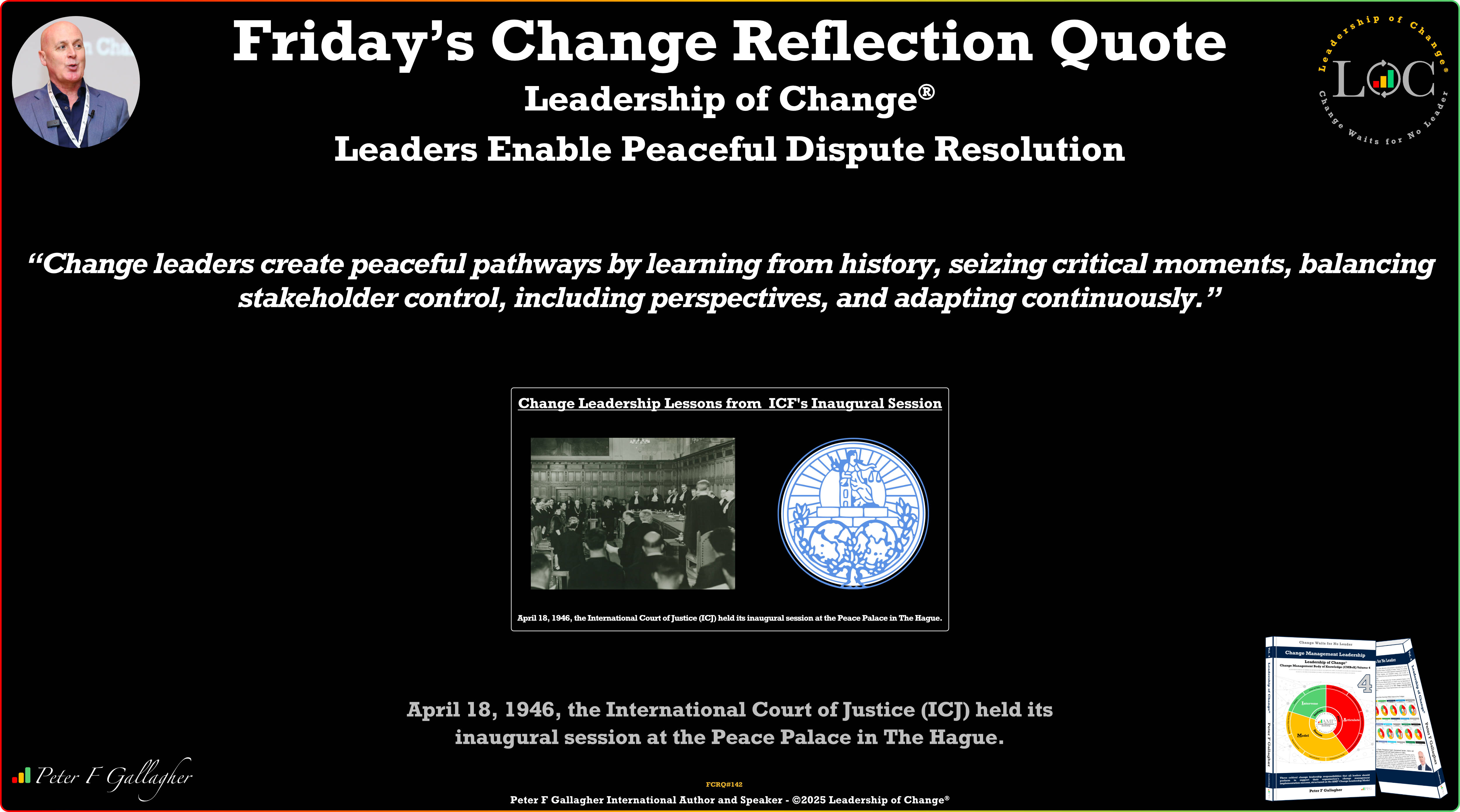 Friday’s Change Reflection Quote - Leadership of Change -Leaders Enable Peaceful Dispute Resolution
Friday’s Change Reflection Quote - Leadership of Change -Leaders Enable Peaceful Dispute Resolution
Leadership Learning!
On this day, 18 April 1946, the International Court of Justice (ICJ) held its inaugural session at the Peace Palace in The Hague, marking a pivotal moment in the post-World War II international order. As the principal judicial organ of the newly formed United Nations, the ICJ succeeded the Permanent Court of International Justice (PCIJ), inheriting its seat, mandate, and commitment to peaceful dispute resolution. The ICJ's establishment reflected a global vision for a stronger, more universally accepted legal mechanism to address conflicts between states through peaceful adjudication rather than military confrontation. Enshrined in the UN Charter, the court’s statute defined its dual role: adjudicating legal disputes submitted by states and offering advisory opinions to authorised UN organs and agencies. This framework underscored the international community’s commitment to resolving disputes through law rather than force. The court's first judges were elected on 6 February 1946 by the UN General Assembly and Security Council, ensuring geographical and legal diversity. Its structure and procedures were crafted to uphold impartiality and fairness, cornerstones for legitimacy in international adjudication. Since its inaugural session, the ICJ has adjudicated a wide range of cases, including territorial disputes, diplomatic conflicts, and treaty interpretations, establishing precedents for peaceful resolution. Its rulings have not only resolved specific disputes but also shaped the development of international law, contributing to a more stable and predictable global legal system. Beyond binding judgments, the ICJ’s advisory opinions have significantly influenced the work of various UN bodies and the broader interpretation of international legal norms. This enduring contribution affirms the power of a clearly articulated vision—rooted in justice, fairness, and legal order, to guide international cooperation over generations. The ICJ’s continuing role affirms the enduring value of legal institutions in maintaining international peace and security. Its existence reflects a collective commitment to justice, order, and the peaceful resolution of conflict in a world that continues to grapple with complex international challenges.
Change Leadership Lessons: The establishment of the International Court of Justice transcends historical significance to offer timeless change leadership lessons, demonstrating the importance of articulating a compelling vision that unites stakeholders, aligns action, and builds legitimacy for transformational change. Leaders of change learn from past failures and incorporate those insights into new structures to create more resilient organisations that can better withstand future challenges. They recognise that launching transformative initiatives during periods of significant disruption can leverage collective willingness to embrace new approaches and institutional frameworks. Change leaders carefully calibrate the balance between centralised direction and stakeholder independence to ensure both guidance and genuine buy-in for successful organisational change. They include varied perspectives in leadership positions to enhance institutional legitimacy and ensure broader acceptance of change initiatives across different constituencies. Leaders of change establish mechanisms that allow for continuous refinement over time, enabling organisations to maintain relevance despite changing external circumstances. Leaders Enable Peaceful Dispute Resolution.
“Change leaders create peaceful pathways by learning from history, seizing critical moments, balancing stakeholder control, including perspectives, and adapting continuously.”
Application - Change Leadership Responsibility 1 - Articulate a Change Vision: The establishment of the International Court of Justice offers a compelling example of how articulating a clear and strategic change vision serves as the foundation for successful transformation. In organisational settings, visionary leaders identify emerging risks and opportunities before they become critical, proactively positioning their organisation at crucial inflection points for future relevance. Effective change leadership begins by defining a compelling future state “B" and contrasting it with the current state “a. This vision must inspire and align stakeholders by clearly showing how the change will lead to shared benefit, increased resilience, and long-term sustainability. In the ICJ example, a shift from fragmented, power-based diplomacy to cooperative, rules-based governance reflected a bold reimagining of international relations—just as organisations today must often shift from legacy systems to new models of operating. Change leaders must demonstrate intellectual rigour, strategic foresight, and integrity—challenging entrenched norms while navigating complex stakeholder concerns. A well-articulated vision should speak to both the pragmatic (efficiency, performance, value) and the aspirational (purpose, fairness, future potential). Additionally, effective change leaders acknowledge and systematically address potential resistance by embedding inclusivity and stakeholder benefits directly into the vision articulation itself. Representing diverse voices, aligning to shared values, and clarifying long-term benefits are all critical for building trust and ownership. Ultimately, articulating a change vision is not a one-time event—it’s an ongoing leadership responsibility. It requires clarity, moral courage, and adaptability to evolve with circumstances. When done effectively, it becomes the guiding light that aligns action, mobilises commitment, and ensures the transformation stays anchored to a shared purpose.
Final Thoughts: Just as the ICJ created structured pathways for peaceful resolution, organisational change leaders must establish frameworks that transform conflict into collaboration. By articulating clear visions that balance diverse interests, today's leaders enable sustainable transformation built on shared understanding rather than imposed directives.
Further Reading: Change Management Leadership - Leadership of Change® Volume 4.
Peter F. Gallagher consults, speaks, and writes on Leadership of Change®. He works exclusively with boards, CEOs, and senior leadership teams to prepare and align them to effectively and proactively lead their organisations through change and transformation.
For insights on navigating organisational change, feel free to reach out at Peter.gallagher@a2B.consulting.
For further reading please visit our websites: https://www.a2b.consulting https://www.peterfgallagher.com Amazon.com: Peter F Gallagher: Books, Biography, Blog, Audiobooks, Kindle
Leadership of Change® Body of Knowledge Volumes: Change Management Body of Knowledge (CMBoK) Books: Volumes 1, 2, 3, 4, 5, 6, 7, 8, 9, 10, A, B, C, D & E available on both Amazon and Google Play:
~ Leadership of Change® Volume 1 - Change Management Fables
~ Leadership of Change® Volume 2 - Change Management Pocket Guide
~ Leadership of Change® Volume 3 - Change Management Handbook
~ Leadership of Change® Volume 4 - Change Management Leadership
~ Leadership of Change® Volume 5 - Change Management Adoption
~ Leadership of Change® Volume 6 - Change Management Behaviour
~ Leadership of Change® Volume 7 - Change Management Sponsorship
~ Leadership of Change® Volume 8 - Change Management Charade
~ Leadership of Change® Volume 9 - Change Management Insanity
~ Leadership of Change® Volume 10 - Change Management Dilenttante
~ Leadership of Change® Volume A - Change Management Gamification - Leadership
~ Leadership of Change® Volume B - Change Management Gamification - Adoption
Tags: Business Strategy, Change Management, Leadership
 Friday’s Change Reflection Quote - Leadership of Change - Leaders Prioritise Reconciliation over Retribution
Friday’s Change Reflection Quote - Leadership of Change - Leaders Prioritise Reconciliation over Retribution
Leadership Learning!
On this day, April 11, 1865, President Lincoln delivered his final address, outlining a vision for post-war reconciliation over retribution, demonstrating his commitment to healing a deeply divided nation. Just two days after the Confederate surrender at Appomattox Court House, the speech marked a critical juncture in American history. Instead of triumph or vengeance, Lincoln called for reintegration, healing, and progress. Speaking from the White House balcony, Lincoln addressed a large crowd gathered to celebrate the Union victory. However, his message was anything but celebratory. He focused on the complexities of national reconstruction and the importance of reintegrating the Southern states into the Union in a fair, sustainable manner. He highlighted Louisiana's biracial loyalist government as a practical model for broader Southern reintegration into the Union. While cautious in tone, Lincoln's message was one of progress, encouraging a measured return to self-governance for the Southern states under the condition of loyalty to the Union and adherence to federal law. A significant portion of the speech was devoted to discussing African American suffrage, which was a revolutionary topic at the time. Lincoln suggested that limited voting rights be extended to Black men, particularly those who were educated or had served in the Union Army. This proposal reflected Lincoln's evolving views on race, democracy, and citizenship. Although he stopped short of endorsing universal suffrage, his position represented a major step forward in American political discourse. It was the first time he publicly acknowledged Black suffrage as a legitimate part of the national conversation, aligning with the broader goals of equality and civil rights that had begun to take shape during the war. One of those angered by the speech was John Wilkes Booth, who was present in the audience. Booth viewed it as a betrayal, confirming his decision to assassinate the president, which he carried out three days later on April 14, 1865, at Ford’s Theatre. While the address is not as widely remembered as some of his other orations, such as the Gettysburg Address or the Second Inaugural, it remains a critical document in understanding Lincoln's final vision for the United States. The April 11 address captured the tension between past grievances and future possibilities, offering a blueprint for national renewal.
Change Leadership Lessons: Lincoln's thoughtful and conciliatory tone amid unprecedented uncertainty demonstrated how strategic foresight, moral clarity, and political courage are essential leadership qualities during profound transitions. Leaders of change must prioritise reconciliation over retribution to unite divided groups and foster long-term stability. They should lead with a clear vision that supports the sustainable reintegration of those impacted by change. Change leaders need to embrace evolving perspectives to advance inclusion and reflect the changing needs of their organisations and societies. They must balance pragmatism with moral courage to push forward progress while maintaining credibility and support. Leaders of change should anticipate resistance and be prepared to address it constructively to ensure the success of transformational efforts. Change Leaders Prioritise Reconciliation over Retribution.
“Sustainable change requires both visionary and vulnerable leadership, and pragmatic implementation—balancing bold aspirations with the patience to cultivate lasting transformation.”
Application - Change Leadership Responsibility 1 - Articulate a Change Vision: Lincoln's final address exemplifies how strategic vision articulation becomes the cornerstone of fundamental organisational transformation. This historical example exemplifies the principle that effective change begins with clearly articulating the change vision. The leadership recognised emerging post-war challenges before they became existential, proactively positioning the nation at a critical historical crossroads. While preserving core values, Lincoln strategically repositioned national unity by abandoning retribution in favour of reintegration, envisioning not merely reunification but enhanced collective governance that would safeguard democratic stability. This approach illustrates how leaders must paint a vivid picture moving from the current "a" state (a divided nation) to an improved future "B" state (a reconciled union). The presidential vision built trust across diverse stakeholder groups by transparently communicating how transformation would benefit all constituents. It demonstrated intellectual rigor by challenging established norms during significant uncertainty. By referencing a biracial loyalist government as a model and proposing progressive policies, it created a blueprint for reconstruction that appealed to both hearts and minds. By systematically addressing concerns while maintaining unwavering focus on healing imperatives, the leadership created the shared understanding necessary to unite stakeholders behind the historic shift. Standing before a crowd expecting triumphant rhetoric, the address instead delivered a measured vision of reconciliation. This historical example showcases how change leaders must maintain intellectual flexibility, adapting strategy to evolving realities while anticipating future organisational needs. The thoughtful articulation captured tension between past and future, revealing the importance of strategic foresight, moral clarity, and leadership courage in moments of profound organisational transition - precisely the elements needed when articulating an effective change vision.
Final Thoughts: Lincoln's leadership demonstrates that reconciliation is more effective than retribution when implementing lasting change. By articulating a clear vision that bridges divides rather than deepens them, change leaders can guide their organisations through even the most challenging transition.
Further Reading: Change Management Leadership - Leadership of Change® Volume 4.
Peter F. Gallagher consults, speaks, and writes on Leadership of Change®. He works exclusively with boards, CEOs, and senior leadership teams to prepare and align them to effectively and proactively lead their organisations through change and transformation.
For insights on navigating organisational change, feel free to reach out at Peter.gallagher@a2B.consulting.
For further reading please visit our websites: https://www.a2b.consulting https://www.peterfgallagher.com Amazon.com: Peter F Gallagher: Books, Biography, Blog, Audiobooks, Kindle
Leadership of Change® Body of Knowledge Volumes: Change Management Body of Knowledge (CMBoK) Books: Volumes 1, 2, 3, 4, 5, 6, 7, 8, 9, 10, A, B, C, D & E available on both Amazon and Google Play:
~ Leadership of Change® Volume 1 - Change Management Fables
~ Leadership of Change® Volume 2 - Change Management Pocket Guide
~ Leadership of Change® Volume 3 - Change Management Handbook
~ Leadership of Change® Volume 4 - Change Management Leadership
~ Leadership of Change® Volume 5 - Change Management Adoption
~ Leadership of Change® Volume 6 - Change Management Behaviour
~ Leadership of Change® Volume 7 - Change Management Sponsorship
~ Leadership of Change® Volume 8 - Change Management Charade
~ Leadership of Change® Volume 9 - Change Management Insanity
~ Leadership of Change® Volume 10 - Change Management Dilenttante
~ Leadership of Change® Volume A - Change Management Gamification - Leadership
~ Leadership of Change® Volume B - Change Management Gamification - Adoption
Tags: Business Strategy, Change Management, Leadership
 Friday’s Change Reflection Quote - Leadership of Change - Change Leaders Plan for Longevity
Friday’s Change Reflection Quote - Leadership of Change - Change Leaders Plan for Longevity
Leadership Learning!
On this day, 4 April 1949, twelve nations signed the North Atlantic Treaty (also known as the Washington Treaty), formally establishing the NATO alliance. The alliance was created in response to the geopolitical instability following World War II, as nations sought a collective security framework to deter future conflicts. The twelve founding nations – Belgium, Canada, Denmark, France, Iceland, Italy, Luxembourg, the Netherlands, Norway, Portugal, the United Kingdom, and the United States – overcame significant political and cultural differences to form an enduring military alliance. Their commitment was based on the principle of collective defence, outlined in Article 5, which states that an attack on one member is an attack on all. Post-war Europe faced an existential threat, prompting urgent cooperation among Western nations. The early Cold War tensions, particularly the growing influence of the Soviet Union, reinforced the need for a unified defence strategy. NATO's formation provided stability and deterrence, ensuring that member nations could collectively respond to external aggression. Beyond its initial defence commitments, NATO evolved to address new security challenges. Over the decades, the alliance expanded its membership to 32 countries and adapted its strategic focus – from Cold War defence to peacekeeping, counter terrorism, and cybersecurity – while staying anchored to its founding principles. The formation of NATO set a precedent for international military cooperation, influencing future defence alliances and security policies. It also demonstrated how diplomatic negotiations could resolve complex security concerns, as nations with differing interests found common ground in mutual defence. While immediate security threats led to NATO’s establishment, its longevity is attributed to deeper commitments beyond military protection. Shared political values, economic ties, and ongoing diplomatic engagement have reinforced the alliance’s stability for over seven decades. NATO remains one of the most significant military alliances in modern history. Its founding, amid post-war uncertainty, shaped global security structures and continues to influence international relations today. NATO’s enduring success provides a powerful example of how principled leadership can guide change through uncertainty and across generations.
Change Leadership Lessons: NATO’s principled and adaptive leadership demonstrates how a clear, shared vision can guide organisations through challenging transitions and build sustainable frameworks for future success. Leaders of change must create an urgent and convincing rationale that clearly outweighs the comfort of maintaining the status quo. They develop inclusive approaches that address diverse stakeholder concerns while balancing individual interests with collective responsibility. Change leaders maintain unwavering commitment to core objectives while remaining flexible about implementation approaches as circumstances evolve. They establish mechanisms for ongoing adaptation rather than pursuing one-time initiatives that quickly become outdated. Leaders of change build transformations upon shared values and principles that transcend immediate circumstances to ensure long-term sustainability. Change Leaders Plan for Longevity.
“Effective change requires both unwavering purpose and flexible execution, built on shared values that outlast immediate challenges and sustain long-term stability.”
Application - Change Leadership Responsibility 1 - Articulate a Change Vision: One critical change leadership lesson from NATO’s establishment is the importance of creating a compelling and sustainable case for transformation. Post-war Europe faced an existential threat that necessitated urgent yet enduring cooperation. Similarly, organisational change requires leaders to articulate a vision rooted in shared values and long-term sustainability, ensuring that the transformation is not only necessary but also built to last. Effective change leaders inspire confidence by clearly demonstrating how the proposed transformation addresses both immediate challenges and future uncertainties. The principle of planning for longevity reminds us that a compelling vision must balance urgency with the adaptability required to navigate evolving contexts. This involves grounding the vision in the organisation’s core principles while designing flexible frameworks to accommodate unforeseen circumstances along the way. A well-crafted change vision does more than describe the future; it unites stakeholders by appealing to both their hearts and minds, driving collective action. Leaders must communicate how the transformation will create shared value, addressing diverse stakeholder concerns while reinforcing a collective sense of purpose. The vision must be aspirational yet realistic, offering a clear, achievable picture of the future that resonates across all levels of the organisation. Change leaders are the primary stewards of this vision. By consistently reinforcing its relevance and aligning it with the organisation’s foundational principles, they foster trust and engagement. Leaders must also establish mechanisms for ongoing adaptation, ensuring that the transformation evolves alongside the organisation’s needs. This approach prevents one-time initiatives from becoming outdated and instead creates a sustainable framework for future success.
Final Thoughts: NATO’s founding teaches us that effective change leadership demands both a compelling vision and the agility to adapt. Leaders who cultivate shared values and long-term thinking can guide their organisations through meaningful and enduring transformation.
Further Reading: Change Management Leadership - Leadership of Change® Volume 4.
Peter F. Gallagher consults, speaks, and writes on Leadership of Change®. He works exclusively with boards, CEOs, and senior leadership teams to prepare and align them to effectively and proactively lead their organisations through change and transformation.
For insights on navigating organisational change, feel free to reach out at Peter.gallagher@a2B.consulting.
For further reading please visit our websites: https://www.a2b.consulting https://www.peterfgallagher.com Amazon.com: Peter F Gallagher: Books, Biography, Blog, Audiobooks, Kindle
Leadership of Change® Body of Knowledge Volumes: Change Management Body of Knowledge (CMBoK) Books: Volumes 1, 2, 3, 4, 5, 6, 7, 8, 9, 10, A, B, C, D & E available on both Amazon and Google Play:
~ Leadership of Change® Volume 1 - Change Management Fables
~ Leadership of Change® Volume 2 - Change Management Pocket Guide
~ Leadership of Change® Volume 3 - Change Management Handbook
~ Leadership of Change® Volume 4 - Change Management Leadership
~ Leadership of Change® Volume 5 - Change Management Adoption
~ Leadership of Change® Volume 6 - Change Management Behaviour
~ Leadership of Change® Volume 7 - Change Management Sponsorship
~ Leadership of Change® Volume 8 - Change Management Charade
~ Leadership of Change® Volume 9 - Change Management Insanity
~ Leadership of Change® Volume 10 - Change Management Dilenttante
~ Leadership of Change® Volume A - Change Management Gamification - Leadership
~ Leadership of Change® Volume B - Change Management Gamification - Adoption
Tags: Business Strategy, Change Management, Leadership
 Friday’s Change Reflection Quote - Leadership of Change - Change Leaders Enable Shared Learning Networks
Friday’s Change Reflection Quote - Leadership of Change - Change Leaders Enable Shared Learning Networks
Leadership Learning!
On this day, 28 March, 1979, the worst nuclear accident in US history began when radioactive steam leaked into the atmosphere in Pennsylvania. The Three Mile Island nuclear accident near Harrisburg profoundly altered the trajectory of nuclear energy policy and crisis management worldwide. A routine mechanical failure triggered a cascade of errors, profoundly shaping public perception and strengthening nuclear regulatory oversight for decades. In the early hours of March 28, 1979, Unit 2 of the Three Mile Island facility experienced a malfunction in its secondary cooling system. A combination of equipment failures, design flaws, and human error led to a partial meltdown of the reactor core. The initial mechanical failure, a stuck valve, was compounded by operators misinterpreting instrument readings, resulting in critically low water levels surrounding the reactor core. Without adequate cooling, nuclear fuel overheated, and radioactive gases formed within the containment building. As the situation unfolded, uncertainty and confusion dominated both the technical response and public communications. Contradictory statements from officials fuelled growing public anxiety. While the concrete containment structure prevented a catastrophic release of radiation, small amounts of radioactive gases were vented into the atmosphere. By March 30, Pennsylvania Governor Dick Thornburgh advised pregnant women and young children within five miles to evacuate, prompting wider voluntary departures. Although physical damage was contained, studies have not definitively linked the accident to increased cancer rates in the surrounding population. However, the psychological impact was profound. The accident occurred just 12 days after the release of The China Syndrome, a film eerily similar to the crisis, intensifying public fears. The Nuclear Regulatory Commission’s official report concluded that despite the severe damage to the reactor, most of the radiation was contained, and the releases that did occur resulted in only minimal physical health effects on the local population and environment. The damaged reactor was sealed and monitored, with the final stage of cleanup completed in December 1993. The cleanup operation took nearly 14 years and cost approximately $1 billion. The incident transformed nuclear safety culture worldwide, prompting regulatory bodies to implement more rigorous safety protocols and enhance operator training. Three Mile Island serves as a critical lesson in the complexity of large-scale technological systems and the potential for isolated failures to cascade into significant crises. It exemplifies that organisational disasters rarely stem from a single cause but emerge from the interaction of multiple factors.
Change Leadership Lessons: Insights from this crisis illustrate how effective change leadership can transform adversity into opportunities for meaningful and lasting progress. Leaders of change must foster psychological safety where team members can voice concerns without fear, preventing problems from escalating into organisational crises. They prioritise transparent, consistent messaging during uncertainty, acknowledging unknowns rather than offering false reassurances to maintain stakeholder trust. Change leaders understand that organisations function as complex adaptive systems where technical, human and organisational factors interact in unpredictable ways. They transform setbacks into opportunities for systemic advancement through visionary leadership that reframes challenges as catalysts for meaningful improvement. Leaders of change build adaptive capacity through scenario-based training and simulations, equipping teams to navigate unexpected developments before actual crises emerge.Change Leaders Enable Shared Learning Networks.
“Adaptive change leadership transforms complexity into opportunity by nurturing learning networks, empowering through transparent communication and systemic understanding.”
Application - Change Leadership Responsibility 2 - Model the New Way: A fundamental responsibility of leaders in driving organisational change is to 'Model the New Way', particularly by transforming systemic failures into opportunities for comprehensive learning and cultural improvement. This involves translating the change vision into reality through consistent actions and behaviours that prioritise safety at every level of the organisation. To achieve this, leaders must actively demonstrate their commitment to safety by integrating it into daily operations and decision-making processes. This includes engaging with employees at all levels, encouraging open dialogue about safety concerns, and recognising those who exemplify safety-first behaviours. By actively demonstrating safety leadership, leaders foster an environment where employees confidently raise concerns without fear of repercussions. Leadership commitment to modelling the new way demands direct, transparent communication and accountability, learning from incidents like Three Mile Island where miscommunication amplified organisational risks. Leaders should work collaboratively with stakeholders to design change initiatives that reflect a shared commitment to safety. This collaborative approach not only enhances the employee experience but also fosters a sense of ownership and responsibility among team members. As leaders fulfil these responsibilities, they will witness a significant shift in the organisation's culture. Employees will feel informed about changes, understand the rationale behind them, and be equipped to adapt to new ways of working. This involves turning the change vision into reality through consistent actions and behaviours that proactively identify and mitigate potential systemic risks before they escalate into critical failures.
Final Thoughts: Transformational change begins with leaders who ‘Model the New Way’ embed safety into organisational culture and everydaypractices. By aligning vision with action and fostering trust, they build adaptable, resilient organisations ready for systemic challenges.
Further Reading: Change Management Leadership - Leadership of Change® Volume 4
Peter F. Gallagher consults, speaks, and writes on Leadership of Change®. He works exclusively with boards, CEOs, and senior leadership teams to prepare and align them to effectively and proactively lead their organisations through change and transformation.
For insights on navigating organisational change, feel free to reach out at Peter.gallagher@a2B.consulting.
For further reading please visit our websites: https://www.a2b.consulting https://www.peterfgallagher.com Amazon.com: Peter F Gallagher: Books, Biography, Blog, Audiobooks, Kindle
Leadership of Change® Body of Knowledge Volumes: Change Management Body of Knowledge (CMBoK) Books: Volumes 1, 2, 3, 4, 5, 6, 7, 8, 9, 10, A, B, C, D & E available on both Amazon and Google Play:
~ Leadership of Change® Volume 1 - Change Management Fables
~ Leadership of Change® Volume 2 - Change Management Pocket Guide
~ Leadership of Change® Volume 3 - Change Management Handbook
~ Leadership of Change® Volume 4 - Change Management Leadership
~ Leadership of Change® Volume 5 - Change Management Adoption
~ Leadership of Change® Volume 6 - Change Management Behaviour
~ Leadership of Change® Volume 7 - Change Management Sponsorship
~ Leadership of Change® Volume 8 - Change Management Charade
~ Leadership of Change® Volume 9 - Change Management Insanity
~ Leadership of Change® Volume 10 - Change Management Dilenttante
~ Leadership of Change® Volume A - Change Management Gamification - Leadership
~ Leadership of Change® Volume B - Change Management Gamification - Adoption
Tags: Business Strategy, Change Management, Leadership
 Friday’s Change Reflection Quote - Leadership of Change - Change Leaders Envision Human-Tech Synergy.
Friday’s Change Reflection Quote - Leadership of Change - Change Leaders Envision Human-Tech Synergy.
March 21, 2024, Elon Musk’s Neuralink company posts a video of a patient playing chess online through their brain implant.
Leadership Learning!
On this day, 21 March, 2024, Neuralink, founded by Elon Musk, posts a video of a patient playing chess online through their brain implant. This watershed moment integrated human cognition with computer technology, enabling a paralysed patient, Noland Arbaugh, to control a cursor and make chess moves through thought alone. The neural interface, implanted in the brain’s motor cortex, translated neural activity into digital commands, achieving direct brain-computer interaction previously confined to science fiction. The video demonstrated unprecedented fluidity and precision, showcasing complex decision-making rather than the basic movements achieved by previous interfaces. Neuralink’s device uses ultrathin threads with electrodes surgically inserted into brain areas controlling movement, with algorithms translating neuronal patterns into digital commands. Founded in 2016, Neuralink aimed to create interfaces allowing human-computer communication at thought speed. After rigorous testing and regulatory review, FDA approval came in May 2023, with the first human implant announced in January 2024. Musk called this first product ‘Telepathy,’ enabling control of devices ‘just by thinking.’ This achievement represents the convergence of materials science, surgical techniques, neuroscience, and AI, highlighting how transformative innovation emerges at the intersection of multiple disciplines. Brain-computer interfaces have evolved since the 1970s, from bulky external equipment to Neuralink’s miniaturised, wireless technology with precise thread insertion capability. The demonstration sparked discussions about neurological applications while raising questions about privacy and human-technology relationships. For change leaders, this milestone offers profound insights: breakthroughs follow lengthy development; vision requires practical execution and regulatory navigation; and transformative change demands reconsideration of fundamental assumptions about human-technology interaction.
Change Leadership Lessons: From Neuralink’s groundbreaking demonstration, change leaders can extract valuable lessons about how visionary leadership, grounded in governance and collaboration, transforms emerging technologies into practical realities. Leaders of change articulate a transcendent vision that inspires action beyond incremental improvement, providing direction and momentum throughout transformation whilst maintaining a focus on societal progress. They facilitate cross-boundary collaboration by bringing together diverse expertise to solve complex challenges across traditional organisational silos.Change leaders engage proactively with governance frameworks, viewing regulations as necessary components of responsible innovation rather than obstacles. They prioritise tangible demonstrations of success to create immediate understanding and build momentum rather than relying on conceptual explanations. Leaders of change demonstrate resilience by persistently adapting tactics while maintaining strategic intent when facing implementation difficulties and setbacks. Change Leaders Envision Human-Tech Synergy.
“Change leaders balance transcendent vision with tangible execution, fostering human-tech synergy for societal progress while navigating governance frameworks and overcoming challenges.”
Change Leadership Responsibility 1 - Articulate a Change Vision: Elon Musk’s Neuralink achievement exemplifies how a clearly articulated vision drives transformative change. Effective change leaders inspire confidence by demonstrating the practical benefits of innovations, ensuring their vision is both bold and achievable. Neuralink’s vision of seamless brain-computer communication was not just a technological goal; it was a commitment to enhancing human capability. Articulating the change vision is the leadership team’s first critical step in navigating transformation. Change leadership is about defining what the organisation will look like when it moves from its current ‘a’ state to an improved future ‘B’ state. A well-crafted vision succinctly describes the benefits of change, appealing to both the hearts and minds of employees. It must be aspirational yet grounded in reality, offering a clear picture of the future. Leaders are the primary communicators of this vision, fostering alignment and commitment across the organisation. By consistently reinforcing the vision’s purpose and relevance, they build trust and engagement. Through clear messaging and visible leadership, they transform ambitious ideas into achievable outcomes, uniting teams on a shared journey of progress and innovation.
Final Thoughts: True leadership demands the courage to embrace technological transformation while remaining grounded in ethical responsibility. Change leaders reflect on the profound impact of innovation, recognising that human-tech synergy must serve the greater good. By thoughtfully navigating the intersection of progress and governance, they ensure that technology elevates humanity rather than diminishes it.
Credit and thank you: Elon Musk and neuralink.com
Further Reading: Change Management Leadership - Leadership of Change® Volume 4
Peter F. Gallagher consults, speaks, and writes on Leadership of Change®. He works exclusively with boards, CEOs, and senior leadership teams to prepare and align them to effectively and proactively lead their organisations through change and transformation.
For insights on navigating organisational change, feel free to reach out at Peter.gallagher@a2B.consulting.
For further reading please visit our websites: https://www.a2b.consulting https://www.peterfgallagher.com Amazon.com: Peter F Gallagher: Books, Biography, Blog, Audiobooks, Kindle
Leadership of Change® Body of Knowledge Volumes: Change Management Body of Knowledge (CMBoK) Books: Volumes 1, 2, 3, 4, 5, 6, 7, 8, 9, 10, A, B, C, D & E available on both Amazon and Google Play:
~ Leadership of Change® Volume 1 - Change Management Fables
~ Leadership of Change® Volume 2 - Change Management Pocket Guide
~ Leadership of Change® Volume 3 - Change Management Handbook
~ Leadership of Change® Volume 4 - Change Management Leadership
~ Leadership of Change® Volume 5 - Change Management Adoption
~ Leadership of Change® Volume 6 - Change Management Behaviour
~ Leadership of Change® Volume 7 - Change Management Sponsorship
~ Leadership of Change® Volume 8 - Change Management Charade
~ Leadership of Change® Volume 9 - Change Management Insanity
~ Leadership of Change® Volume 10 - Change Management Dilenttante
~ Leadership of Change® Volume A - Change Management Gamification - Leadership
~ Leadership of Change® Volume B - Change Management Gamification - Adoption
Tags: Business Strategy, Change Management, Leadership
 Friday’s Change Reflection Quote - Leadership of Change - Leaders Establish Integrity Before Justice.
Friday’s Change Reflection Quote - Leadership of Change - Leaders Establish Integrity Before Justice.
March 14th, 1991, Birmingham Six freed after serving 96 years for a crime they didn’t commit.
Learning Friday!
On March 14th, 1991, the Birmingham Six walked free after serving a combined 96 years for a crime they did not commit. Their convictions for the murder of 21 people in two Birmingham pub bombings were quashed by the Court of Appeal, marking the end of a sixteen-year struggle against systemic failure and demonstrating how institutions often resist acknowledging errors. The Birmingham Six, Paddy Hill, Hugh Callaghan, Richard McIlkenny, Gerry Hunter, Billy Power, and Johnny Walker, became symbols of one of Britain's most notorious miscarriages of justice. These six Irish men were arrested in November 1974 following IRA bomb attacks on two Birmingham pubs, the Mulberry Bush and the Tavern in the Town, which tragically killed 21 people and injured 182 others. Within hours, they were in custody; within six months, they were convicted and sentenced to life imprisonment. Their convictions relied heavily on forensic evidence and confessions the men consistently maintained were extracted through physical and psychological coercion. The case began unravelling in 1985 when the forensic evidence was discredited. The Griess test, used to detect explosives, was found unreliable, producing false positives from everyday items like playing cards and cigarette smoke. Despite this revelation, their first appeal was dismissed, underscoring the system’s reluctance to admit fault. It took a relentless campaign, combining investigative journalism, legal battles, and grassroots activism, to break institutional resistance and achieve justice. Journalist Chris Mullin’s book ‘Error of Judgement’ exposed serious flaws in the case, identifying the likely perpetrators and documenting police malpractice that went unpunished. The men’s legal team, led by solicitor Gareth Peirce, systematically dismantled the prosecution's case, presenting compelling new evidence that the confessions were coerced and forensic evidence manipulated. When Lord Chief Justice Lord Lane finally announced, “The convictions are unsafe and unsatisfactory. They are quashed,” it represented not just freedom for six innocent men, but a seismic shift in Britain’s criminal justice system. The case led directly to the establishment of the Criminal Cases Review Commission and fundamental reforms in police interrogation procedures, including mandatory video recording of interviews. The fact that six innocent men were systematically brutalised within a criminal justice system that lacked the integrity to correct its own errors for sixteen years stands as a stark indictment of institutional failure. As the men emerged from the Old Bailey, Paddy Hill’s words resonated with raw emotion: ‘The police told us from the start they knew we hadn't done it. They didn't care who had done it.” His statement encapsulated the profound betrayal they had suffered at the hands of those sworn to uphold justice and integrity.
Change Leadership Lessons: The Birmingham Six case highlights how integrity must serve as the guiding principle for leadership both in normal day-to-day operations and in transformative change. Leaders of change prioritise integrity as the foundation for decisions, creating trust that paves the way for enduring reforms. They demonstrate consistency between their actions and values, ensuring credibility and fostering confidence in their leadership. Change leaders champion transparency, openly addressing systemic flaws to rebuild the moral framework within organisations. They recognise that sustainable progress emerges from a steadfast commitment to ethics, even when facing resistance or setbacks. Leaders of change cultivate environments where ethical conduct is celebrated, ensuring organisations align with both purpose and principles. Leaders Establish Integrity Before Justice.
“Leaders of change prioritise integrity, demonstrate consistency between their actions and values, and address flaws transparently, ensuring justice has no bias.”
Application - Lead With Integrity: In the Birmingham Six case, integrity failures within law enforcement and judicial institutions directly undermined justice, as authorities consistently refused to address clear errors despite mounting evidence. Modelling integrity is an essential, non-delegable responsibility for leaders of change and cannot rely on superficial gestures or symbolic actions. Integrity stands out as the most critical trait of a leader, especially in times of transformative change. Leaders of change must guide their organisations and employees through change journeys firmly rooted in ethical principles. Integrity and moral credibility are the cornerstones of successful leadership, enabling trust and fostering genuine relationships within the workplace. Organisational change often entails difficult decisions, but ethical leaders consistently prioritise doing what is right, even under pressure. Research confirms that morally grounded leadership yields better organisational outcomes and fosters enduring transformation. While employees overwhelmingly value moral leadership, many perceive a gap between what leaders say and what they embody in practice. Credibility, a hallmark of integrity, hinges on trust, respect, and authentic alignment between a leader’s words and actions, making it indispensable for leaders driving meaningful change.
Final Thoughts: Integrity requires leaders to acknowledge uncomfortable truths even when they challenge institutional beliefs. When justice systems lack integrity, they become vehicles for injustice rather than its remedy.
Further Reading: Change Management Leadership - Leadership of Change® Volume 4
As we reflect on this historic injustice this weekend, may we all consider the importance of integrity in our own leadership roles and communities. While appreciating time with loved ones, perhaps we might also contemplate how we can contribute to more just systems in our spheres of influence.
Peter F. Gallagher consults, speaks, and writes on Leadership of Change®. He works exclusively with boards, CEOs, and senior leadership teams to prepare and align them to effectively and proactively lead their organisations through change and transformation.
For insights on navigating organisational change, feel free to reach out at Peter.gallagher@a2B.consulting.
For further reading please visit our websites: https://www.a2b.consulting https://www.peterfgallagher.com Amazon.com: Peter F Gallagher: Books, Biography, Blog, Audiobooks, Kindle
Leadership of Change® Body of Knowledge Volumes: Change Management Body of Knowledge (CMBoK) Books: Volumes 1, 2, 3, 4, 5, 6, 7, 8, 9, 10, A, B, C, D & E available on both Amazon and Google Play:
~ Leadership of Change® Volume 1 - Change Management Fables
~ Leadership of Change® Volume 2 - Change Management Pocket Guide
~ Leadership of Change® Volume 3 - Change Management Handbook
~ Leadership of Change® Volume 4 - Change Management Leadership
~ Leadership of Change® Volume 5 - Change Management Adoption
~ Leadership of Change® Volume 6 - Change Management Behaviour
~ Leadership of Change® Volume 7 - Change Management Sponsorship
~ Leadership of Change® Volume 8 - Change Management Charade
~ Leadership of Change® Volume 9 - Change Management Insanity
~ Leadership of Change® Volume 10 - Change Management Dilenttante
~ Leadership of Change® Volume A - Change Management Gamification - Leadership
~ Leadership of Change® Volume B - Change Management Gamification - Adoption
Tags: Business Strategy, Change Management, Leadership
Location: Virtual Fees: £25,000 - £35,000
Service Type: Service Offered
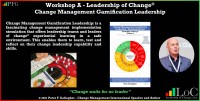 Workshop: Leadership of Change - Change Management Gamification Leadership
Workshop: Leadership of Change - Change Management Gamification Leadership
Location: At client site Fees: Per request
Service Type: Service Offered
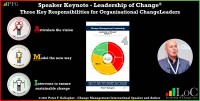 New Leadership of Change Keynote: Three Key Change Leadership Responsibilities
New Leadership of Change Keynote: Three Key Change Leadership Responsibilities
Location: Edinburgh Fees: 95000
Service Type: Service Offered
 Change Sponsors Must Have Gravitas
Change Sponsors Must Have Gravitas Protagonist #2. Change Sponsor: Change Management Charade
Protagonist #2. Change Sponsor: Change Management Charade Leadership Change Lessons From Nixon Serving Dollar Gold Link - Leaders Act on Economic Necessity
Leadership Change Lessons From Nixon Serving Dollar Gold Link - Leaders Act on Economic Necessity Friday’s Change Reflection Quote - Leadership of Change - Change Leaders Anticipate Market Dynamics
Friday’s Change Reflection Quote - Leadership of Change - Change Leaders Anticipate Market Dynamics Friday’s Change Reflection Quote - Leadership of Change - Change Leaders Replace Outdated Ideologies
Friday’s Change Reflection Quote - Leadership of Change - Change Leaders Replace Outdated Ideologies Friday’s Change Reflection Quote - Leadership of Change - Change Leaders Act on Economic Necessity
Friday’s Change Reflection Quote - Leadership of Change - Change Leaders Act on Economic Necessity